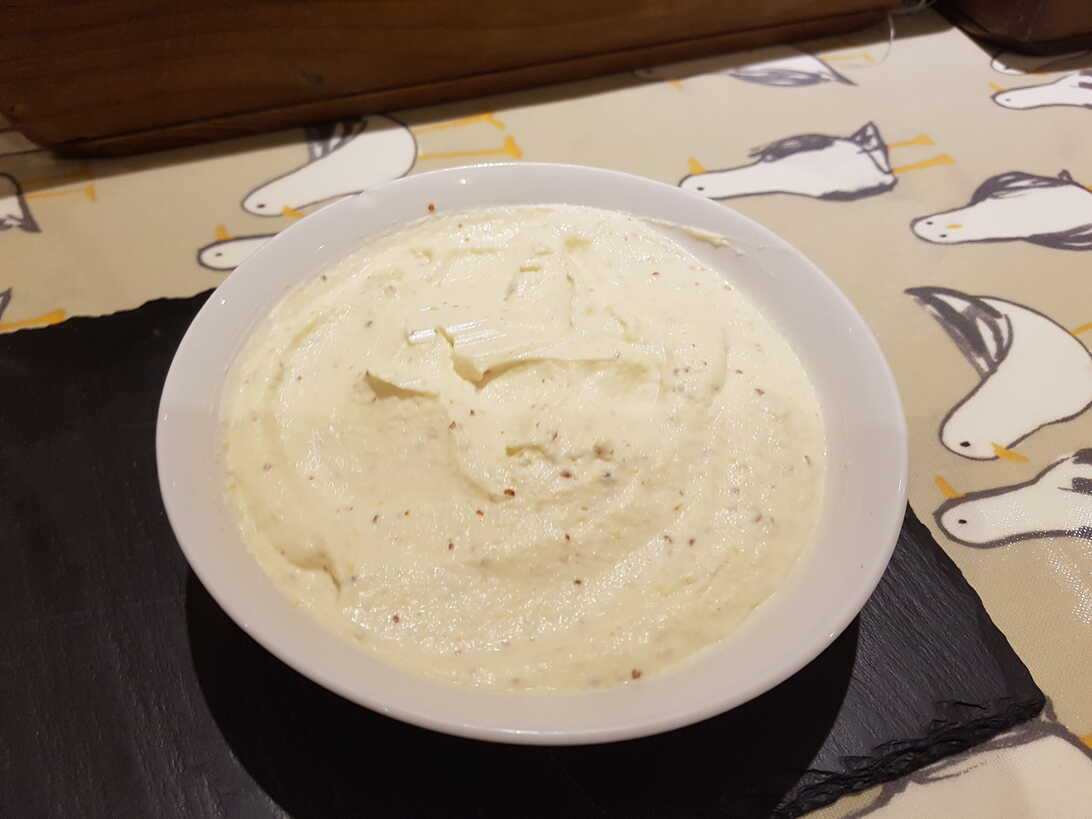
Winter Filth

Ah, Winterfylleth. The ancient Anglo-Saxon month that marked the beginning of winter - as recorded by the Venerable Bede.
Roughly corresponding to October in the modern Gregorian calendar. Starting this year on the New Moon of the 3rd of October and wrapping around the first full moon of winter on the 17th.
Not to be confused with Tolkien's Winterfilth - the tenth month of Shire-calendar. Running from 22nd September to 21st October if you are a hobbit.
Best appreciated with strong liquor.
Speaking of which, ever since I went to Finland to sample Fazer's chocky eggs (and visit Moomin World) I've been a great fan of the Finnish salty liquorice flavour sal ammoniac (ammonium chloride), which they call salmiakki.
Fazer hide surprise bursts of it in many of their sweeties.
So I was delighted to discover, the other day, that you can get a salty liquorice flavoured vodka called Salmiakki on Amazon.
From there, it's just a short step to combining a Japanese salmon preparation technique with a strongly flavoured Finnish vodka to create an obvious pun-based dish.
And thus was SALMONIAKꞰI born.
Salmoniakki
main fish
I couldn't resist this Finnish salmiakki-flavoured vodka. I thought it might make a great flavour for salmon en papillote.
Or possibly teriyaki-style, bubbled into a sauce with maple syrup perhaps? Maybe some vinegar.
Fry the salmon coated in potato starch, or tapioca starch.
The problem I had was that the sauce wasn't thickening the way a teriyaki does - probably the lack of soy sauce, which I don't want to add. Nor do I want any more maple syrup since the sauce is sweet enough. So I thought I'd try adding a thick beer - Barley Wine yes, I realise the name is confusing. I know that the Finns do drink a barley-based beer called sahti so it doesn't seem inappropriate, and in fact the flavour does blend well, mellowing the more aggressive sal ammonia notes, but it doesn't actually thicken things terribly much.
So after much experimentation I gave in and whisked in a few pinches of xanthan gum. Add cautiously - and whisk furiously lest it clump.
So now, what to serve it with?
I started with Flora's Samphire and Creamed Chanterelles (because Finns like their mushrooms), a Japanese Cucumber Salad (because Finns like vinegar), and some rice with spring onion slices (because teriyaki!).
I'm not sure about the mushrooms (maybe add some pickled anchovies?), but the cucumber salad worked very well.
I'm wondering about potato, or a potato purée (since the Finns like potatoes and after all, they don't eat rice), and perhaps a beetroot and horseradish puree (because they also seem like the kind of things Finns eat)?
Beetroot and horseradish agar-agar caviar seems like it might be nice.
I might even make a meal out of it.
The problem I had was that the sauce wasn't thickening the way a teriyaki does - probably the lack of soy sauce, which I don't want to add. Nor do I want any more maple syrup since the sauce is sweet enough. So I thought I'd try adding a thick beer - Barley Wine yes, I realise the name is confusing. I know that the Finns do drink a barley-based beer called sahti so it doesn't seem inappropriate, and in fact the flavour does blend well, mellowing the more aggressive sal ammonia notes, but it doesn't actually thicken things terribly much.
So after much experimentation I gave in and whisked in a few pinches of xanthan gum. Add cautiously - and whisk furiously lest it clump.
So now, what to serve it with?
I started with Flora's Samphire and Creamed Chanterelles (because Finns like their mushrooms), a Japanese Cucumber Salad (because Finns like vinegar), and some rice with spring onion slices (because teriyaki!).
I'm not sure about the mushrooms (maybe add some pickled anchovies?), but the cucumber salad worked very well.
I'm wondering about potato, or a potato purée (since the Finns like potatoes and after all, they don't eat rice), and perhaps a beetroot and horseradish puree (because they also seem like the kind of things Finns eat)?
Beetroot and horseradish agar-agar caviar seems like it might be nice.
I might even make a meal out of it.
Serves 2
Ingredients
- 2x2" slices of salmon fillet
- potato or tapioca starch
For the Sauce:- 3 tblsps Salmiakki flavoured vodka
- 2 tblsps barley wine
- 1 tblsps maple syrup
- pinches of xanthan gum
The Method
So. After some experimentation, here is what you do:
Clean de-bone and descale the salmon. Cut and trim neat pieces.
Stir to dissolve the maple syrup, then simmer until reduced by ½ or ⅔.
Whisk in a couple of pinches of xanthan gum to thicken it if you want - it probably won't coat the fish well without it.
Sift potato or tapioca starch over the fish fillets.
Heat a little oil in a frying pan and fry the fillets skin-side down over medium heat until the fillets colour about a third of the way up.
Flip the fillets and again colour them about a third of the way up.
Transfer the salmon to a plate and clean the pan with kitchen towels. Pour some of the salmoniakki sauce into the frying pan, return the salmon pieces, and flip them in the sauce to coat and glaze.
Clean de-bone and descale the salmon. Cut and trim neat pieces.
If you have the time season the fillets and leave them uncovered overnight in the fridge.
Mix all the sauce ingredients in a small pot, and bring to the boil.Stir to dissolve the maple syrup, then simmer until reduced by ½ or ⅔.
Whisk in a couple of pinches of xanthan gum to thicken it if you want - it probably won't coat the fish well without it.
Sift potato or tapioca starch over the fish fillets.
Heat a little oil in a frying pan and fry the fillets skin-side down over medium heat until the fillets colour about a third of the way up.
Flip the fillets and again colour them about a third of the way up.
Transfer the salmon to a plate and clean the pan with kitchen towels. Pour some of the salmoniakki sauce into the frying pan, return the salmon pieces, and flip them in the sauce to coat and glaze.
You avoid overcooking the salmon on the first fry-through since it will cook some more at this stage in the sauce.
Serve the glazed salmon with extra sauce drizzled over it.
It even surprised me how delicious this is!
I wonder how well this would work en papillote?
If it were teriyaki you'd serve it over rice, but I doubt the Finns eat much savoury rice. Potato probably. Maybe some Karjalanpiirakka pastry?
I wonder how well this would work en papillote?
If it were teriyaki you'd serve it over rice, but I doubt the Finns eat much savoury rice. Potato probably. Maybe some Karjalanpiirakka pastry?
Flora's Samphire and Creamed Chanterelles
veg side
Flora boasted about her successful combining of samphire, creamed chanterelles and scallops.
I didn't have any chanterelles, so I first made this using thinly sliced oyster mushrooms, which are frankly less than ideal.
Then I tried matchsticks of regular mushrooms, which were an improvement, but I think cordyceps would be even better - they even resemble samphire in shape and size.
I also made the mistake of flavouring the cream with cognac instead of calvados, which would have been a definite improvement.
Neither did I have any scallops, but I think you can safely skip those.
I also made the mistake of flavouring the cream with cognac instead of calvados, which would have been a definite improvement.
Neither did I have any scallops, but I think you can safely skip those.
Serves 2
Ingredients
- two handfuls of samphire
- handful of chanterelles though I used oyster mushrooms
- small knob of butter
- splash of olive oil
- 1 tblsp calvados Not cognac!
- 2-3 tblsps double cream
Throw the samphire into boiling water, return to the boil then drain the samphire and dump into iced water to refresh.
Fry the chanterelles until lightly browned you can slice them into shreds to more match the samphire stalks if you like in a little butter and olive oil.
Deglaze the pan with calvados, bubble it off, then add double cream to coat the mushrooms and stir until the sauce thickens.
When ready to serve, bring another pot of water to the boil, drop the samphire in and bring to the boil again. Drain, mix with the creamed mushroom, and serve.
Fry the chanterelles until lightly browned you can slice them into shreds to more match the samphire stalks if you like in a little butter and olive oil.
Deglaze the pan with calvados, bubble it off, then add double cream to coat the mushrooms and stir until the sauce thickens.
When ready to serve, bring another pot of water to the boil, drop the samphire in and bring to the boil again. Drain, mix with the creamed mushroom, and serve.
I'm still not entirely convinced by the combination, but the result is at least edible, and reasonably interesting.
I tried finishing with a splash of cider vinegar, but that doesn't really work.
I also tried adding some shredded nori seaweed sheets. That wasn't too bad.
I tried finishing with a splash of cider vinegar, but that doesn't really work.
I also tried adding some shredded nori seaweed sheets. That wasn't too bad.
Japanese Cucumber Salad
Sunomono
Sunomono
salad veg vegan
Salting the cucumber slices leaves them surprisingly crisp in this simple Japanese salad.
I skipped the wakame seaweed, since I didn't have any,
though I did a couple of rounds using sliced nori seaweed
and used the Thai pineapple and fish sauce dressing from my
Lemongrass and Pineapple Beef Vermicelli Stir-Fry as the pickling liquid and it was still good!
The salting process is so effective that you could easily munch your way through an entire dessicated cucumber.
The salting process is so effective that you could easily munch your way through an entire dessicated cucumber.
Serves 4
Ingredients
- 2 Japanese cucumbers (or 3 Persian cucumbers - about 300g)
- 1-2 tsp fine salt
- 1 tblsp dried wakame seaweed (3g dried, 20-30g rehydrated)
- ½ tblsps toasted white sesame seeds
For the Dressing:- 4 tblsps unseasoned rice vinegar
- 2 tblsps sugar
- ½ tsp salt
- ½ tsp soy sauce
- 1 red chilli, minced
In a saucepan combine the rice vinegar, sugar, soy sauce and salt.
Soak the dried wakame seaweed in water and let it rehydrate for 5 minutes.
Meanwhile, peel the skin of 2 Japanese cucumbers, leaving some skin on to create stripes. Then, slice them very thinly into rounds, best done using a mandoline.
Sprinkle fine sea salt on the slices as you go, then gently massage it all in. Set aside for 5-15 minutes.
The salt helps draw out the moisture from the cucumbers (so it does not dilute the salad dressing after mixing).
Squeeze out the liquid from the rehydrated wakame seaweed and add it to a medium bowl.
I'd skip the salt.
Thoroughly squeezing out the cucumber will get rid of excess salt but there'll still be some left in there, so I would only add more salt as necessary after you taste the final product.
Heat over medium heat and whisk it well together. When the sugar is dissolved completely, remove the saucepan from the heat and let it cool.
If the vinegar flavour seems too strong then dilute it with a small amount of dashi or water.
Thoroughly squeezing out the cucumber will get rid of excess salt but there'll still be some left in there, so I would only add more salt as necessary after you taste the final product.
Adding some minced de-seeded red chilli is quite nice.
Soak the dried wakame seaweed in water and let it rehydrate for 5 minutes.
Meanwhile, peel the skin of 2 Japanese cucumbers, leaving some skin on to create stripes. Then, slice them very thinly into rounds, best done using a mandoline.
Sprinkle fine sea salt on the slices as you go, then gently massage it all in. Set aside for 5-15 minutes.
The salt helps draw out the moisture from the cucumbers (so it does not dilute the salad dressing after mixing).
Squeeze out the liquid from the rehydrated wakame seaweed and add it to a medium bowl.
The seaweed adds an interesting variation in texture and mild briny flavour, but don't overdo it.
It's quite sticky messy stuff that gets everywhere as you squeeze it out. Also the dried packet I had contained quite a lot of large, thick or fibrous pieces amongst the finer, smaller usable ones. So you may have to go through the re-hydrated assortment quite carefully to pick those out.
Squeeze out the liquid from the cucumbers.
No need to be gentle - they can take it!
Add them to the bowl, mix them with the dressing and toss it all together.
Lightly toast the sesame seeds in a dry frying pan and add them to the cucumber, mixing everything together.
It's quite sticky messy stuff that gets everywhere as you squeeze it out. Also the dried packet I had contained quite a lot of large, thick or fibrous pieces amongst the finer, smaller usable ones. So you may have to go through the re-hydrated assortment quite carefully to pick those out.
Very good. I'm not sure how long it will stay crisp though so best eat it soon.
Fortunately you don't get terribly much end product from one cucumber - all the salting and squeezing will reduce it practically to nothing!
There is just one thing, however- with the amount of dressing here, the made-up mixture is pretty wet. So if you're trying to pile it neatly on the plate you may need to dry it off, contain it somehow, or use less dressing. Perhaps half.
There is just one thing, however- with the amount of dressing here, the made-up mixture is pretty wet. So if you're trying to pile it neatly on the plate you may need to dry it off, contain it somehow, or use less dressing. Perhaps half.
Thai Green Curry Squash
main curry thai veg vegan
I made the mistake of buying some attractive French gourds to decorate the kitchen for a few days, before cooking with them - a twofer!
Unfortunately, it turns out that decorative squash, whilst definitely edible, have incredibly thick skin and surprisingly little flesh.
Should have gone with the butternut squash! As recommended in the recipe I (mostly) followed.
I fancied trying their soy-sauce-frying technique for cooking the squash, and it was mostly successful (though it does make the squash very salty).
I did make the mistake of adding peanut butter to the green curry paste in an attempt to turn it more padan-y. But to be honest that didn't really work well.
It might have been better to base the paste around red curry paste, rather than the green. The flavours mostly clashed, rather than working together.
Unfortunately, it turns out that decorative squash, whilst definitely edible, have incredibly thick skin and surprisingly little flesh.
Should have gone with the butternut squash! As recommended in the recipe I (mostly) followed.
I fancied trying their soy-sauce-frying technique for cooking the squash, and it was mostly successful (though it does make the squash very salty).
I did make the mistake of adding peanut butter to the green curry paste in an attempt to turn it more padan-y. But to be honest that didn't really work well.
It might have been better to base the paste around red curry paste, rather than the green. The flavours mostly clashed, rather than working together.
Serves 4
Ingredients
- 2 tblsp sunflower oil
- 1 medium (about 800g) butternut squash, peeled and cut into bite-sized cubes
- 3 tblsp light soy sauce
- 1 lime, wedged to serve
- a handful coriander, roughly torn, to serve
- 1 red chilli, deseeded and finely sliced, to serve
- 1 spring onion, finely chopped to serve
- jasmine rice, to serve
Green Curry Base:- 1 stalk lemongrass, bruised
- 2 tblsp Thai green curry paste red might be better here
- 2 tblsps peanut butter or perhaps not!
- 2 x 400ml tins coconut milk
- a handful sugar snap peas, halved
- a handful asparagus spears, tough ends removed
- a handful green beans, trimmed
- 2 tbsp frozen or fresh edamame beans
Heat 1 tbsp of sunflower oil in a wok while you toss the butternut squash cubes into the soy sauce.
Put the soy-coated butternut squash in the wok and cook over a medium heat for 10 minutes or until softened and browned, stirring frequently.
Add the lemongrass and Thai green curry paste and peanut butter - although you might want to reconsider that!, and fry over a high heat for 1 minute.
Stir in the coconut milk, then reduce the heat slightly and simmer for 8 minutes.
Throw the sugar snap peas, asparagus, green beans and edamame beans into the curry sauce or green beans - if that's all you have to hand and cook for 4-5 minutes or until the vegetables are cooked but still have some bite.
Ladle the curry into bowls and spoon in the softened soy-glazed butternut squash.
Top each bowl with a squeeze of lime juice, sprinkle with the coriander, add a few slices of chilli and a scattering of spring onion.
Serve with bowls of jasmine rice.
Put the soy-coated butternut squash in the wok and cook over a medium heat for 10 minutes or until softened and browned, stirring frequently.
After browning the squash for a few minutes I covered my wok with a lid to help cook it through.
For the green curry base, heat the remaining sunflower oil in a separate large frying pan.Add the lemongrass and Thai green curry paste and peanut butter - although you might want to reconsider that!, and fry over a high heat for 1 minute.
Stir in the coconut milk, then reduce the heat slightly and simmer for 8 minutes.
The original recipe calls for low-fat coconut milk.
WTF even is that?
Remove and discard the lemongrass stalk.WTF even is that?
Throw the sugar snap peas, asparagus, green beans and edamame beans into the curry sauce or green beans - if that's all you have to hand and cook for 4-5 minutes or until the vegetables are cooked but still have some bite.
Ladle the curry into bowls and spoon in the softened soy-glazed butternut squash.
Top each bowl with a squeeze of lime juice, sprinkle with the coriander, add a few slices of chilli and a scattering of spring onion.
Serve with bowls of jasmine rice.
I can see that you probably do need to keep the soy-fried squash separate until serving, or it will lose its identity in the sauce.
Soy-Glazed Sirloin
main meat
Lacking a sous-vide device myself Hello Santa? I improvised one -
I discovered that if I filled my slow cooker with water at 51°c and set it on low it would hold the temperature pretty well without the lid on.
So that's what I used instead. I call it my slow-vide 🤣
The lack of a water circulator didn't seem to matter much since the entire sleeve of the machine heats the water fairly uniformly.
So that's what I used instead. I call it my slow-vide 🤣
The lack of a water circulator didn't seem to matter much since the entire sleeve of the machine heats the water fairly uniformly.
Serves 4
Ingredients
- 12oz/350g piece of sirloin
- 2 tblsps soy sauce
- 2 tsps toasted sesame oil
- 2 tsps rice vinegar
- 2 tsps fish sauce
- 2 tsps mirin
- Wot, no garlic??
Pour the marinades into a freezer bag with the steak.
Lower the open bag carefully into a large bowl of water and use the pressure of the water to squeeze all the air out before sealing the top shut.
Looking at you slow-vide!
When ready to eat, lift the bag out of the sous-vide and the steak out of the bag.
Heat a cast-iron skillet until scorching hot, then quickly sear the outside of the steak. It is now ready to slice and serve.
Or use a vacuum-sealer!
Put the bag into a sous-vide device, weighing its contents down with a plate or something, and cook for 2-3 hours at 53.9°C, or between 50°c and 55°C depending on your device's capabilities.Looking at you slow-vide!
When ready to eat, lift the bag out of the sous-vide and the steak out of the bag.
You have to make sure you don't submerge the top of the bag in the sous-vide water, unless your certain of the seal.
I used a clothes peg and some string to hold the top out.
You will now have quite a lot of marinade and steak fat left in the bag with which to to think of things to do. Like glazing some butternut squash?
Dry the steak thoroughly with kitchen paper. Lubricate it lightly with a neutral high smoke point oil. Just smear it on with your hands!You will now have quite a lot of marinade and steak fat left in the bag with which to to think of things to do. Like glazing some butternut squash?
Heat a cast-iron skillet until scorching hot, then quickly sear the outside of the steak. It is now ready to slice and serve.
It's good steak too!
You can leave it as long as you need in the bath once cooked, and then the sear-to-serve only takes a couple of minutes.
You can leave it as long as you need in the bath once cooked, and then the sear-to-serve only takes a couple of minutes.
Celeriac Purée with Mustard and Goat's Cheese
veg side
Another celeriac purée, but this one offsets some of the bitterness introduced by the mustard (especially if you accidentally use Dijon) with some honeyed goat's cheese that I happened to have lying around.
Adding some potato would help make the purée smoother too.
Adding some potato would help make the purée smoother too.
Ingredients
- celeriac
- cream
- whole grain mustard
- salt
- butter
- goat's cheese honeyed is good
Chop the celeriac into fat chunks and simmer them for about 15 minutes until they soften.
Season and blend in some pieces of butter to enrich the mixture.
You could gently sweat the celeriac in butter and cream or milk for a really long time to soften it instead.
Warm the softened pieces with cream and goat's cheese, then blend with whole grain mustard.Season and blend in some pieces of butter to enrich the mixture.
Good combination.
Valencian Paella
main meat fowl
Well, it may be rather late in the year, but my butcher had a rabbit. So paella it would be...
Despite intense scholarly study of the permissible ingredients in a (definitely non-seafood) Paella Valenciana, there remains significant authentic local variation.
So don't sue me for adding some asparagus! According to these researchers the only ten ingredients generally agreed upon are:
Snails used to be quite a common ingredient, and you will also find little meatballs being added.
If you like you can blanch the sliced green beans or asparagus! and lay them on top for decoration rather than stirring them through. In which case best to cut them in strips.
I've also seen professional chefs from a mountainous area fry up some strips of long sweet red peppers with the meat, then lay those in a star pattern on top to finish.
Apparently they are known as mountain shrimp, due to the shortage of actual shrimp there.
The official 30cm (rim-to-rim) paella pan, which happens to be the size of my frying pan, is meant to hold 2-3 main course servings.
Generally a paella serving is considered to be 100-125g of rice, and the accepted water:rice ratio for paella rice is 3:1 or possibly 2.5:1.
I may have made my paella a little too thick - it's reckoned it should be only about the thickness of a finger un ditet, or no deeper than 2cm (¾").
The reason being that if the rice is too deep it will not dry out evenly resulting in overcooked rice at the bottom.
And that's going to be my excuse for failing to produce a decent succotash, sorry, I mean socarrat. Except for at the very centre of my pan.
I figured that might preclude cooking with the much thicker pieces of flesh which I had, but looking at photos of authentic paellas I see that they too have hefty lumps of meat sticking up from the bed of rice, so perhaps it would be sufficient to just make sure the tops were cleared of rice while cooking.
The D.O.P certified Valencian rice varieties available for paella making are Bomba, J Sendra or Senia and Albufera.
Though for the non-purist, Calasparra, Marisma or Maratelli might also be acceptable.
Despite intense scholarly study of the permissible ingredients in a (definitely non-seafood) Paella Valenciana, there remains significant authentic local variation.
So don't sue me for adding some asparagus! According to these researchers the only ten ingredients generally agreed upon are:
- rice
- water
- olive oil
- salt
- saffron (or food colouring)
- tomato
- flat green beans
- Garrafó beans, a Spanish variety of Lima beans, also widely known as butter beans
- chicken
- rabbit
Snails used to be quite a common ingredient, and you will also find little meatballs being added.
If you like you can blanch the sliced green beans or asparagus! and lay them on top for decoration rather than stirring them through. In which case best to cut them in strips.
I've also seen professional chefs from a mountainous area fry up some strips of long sweet red peppers with the meat, then lay those in a star pattern on top to finish.
Apparently they are known as mountain shrimp, due to the shortage of actual shrimp there.
The official 30cm (rim-to-rim) paella pan, which happens to be the size of my frying pan, is meant to hold 2-3 main course servings.
Generally a paella serving is considered to be 100-125g of rice, and the accepted water:rice ratio for paella rice is 3:1 or possibly 2.5:1.
I may have made my paella a little too thick - it's reckoned it should be only about the thickness of a finger un ditet, or no deeper than 2cm (¾").
The reason being that if the rice is too deep it will not dry out evenly resulting in overcooked rice at the bottom.
And that's going to be my excuse for failing to produce a decent succotash, sorry, I mean socarrat. Except for at the very centre of my pan.
I figured that might preclude cooking with the much thicker pieces of flesh which I had, but looking at photos of authentic paellas I see that they too have hefty lumps of meat sticking up from the bed of rice, so perhaps it would be sufficient to just make sure the tops were cleared of rice while cooking.
The D.O.P certified Valencian rice varieties available for paella making are Bomba, J Sendra or Senia and Albufera.
Though for the non-purist, Calasparra, Marisma or Maratelli might also be acceptable.
Feeds a Fiesta
Ingredients
- extra virgin olive oil
- paella rice
- salt
- rabbit optional
- chicken
- Ferradura or Bajoqueta large flat green beans
- Garrofón or lima or butter beans
- tomato, grated
- sweet smoked paprika
- saffron
- chicken stock
- rosemary
Optional Extras:- garlic, minced
- artichoke hearts optional
- snails of the Xonetes species
Unacceptable Extras:- asparagus
Cut the artichoke stems short above any wooden section, then peel their rough skin if using.
Cut away the tough outer leaves, then quarter them vertically and remove the hairy choke with a paring knife.
Keep them in water acidulated with lemon juice until needed.
Remove the tough end of the asparagus stalks if using and boil them for a minute, before plunging them into iced water to cool.
Grind the saffron lightly in a pestle and mortar. You can toast it first in a foil wrap in the hot pan for 2-3 minutes if you like, to help release the flavour.
Heat the pan of stock and keep it simmering.
Slice the flat green beans on a bias either lengthways or across, as you like.
Mince the garlic if using.
Grate the tomato on the coarser side of a box grater or similar you can blend them if you prefer.
Joint the rabbit and the chicken. Separate the leg sections and the chicken wings discarding the tips of both.
Pour a small puddle of olive oil into your paella pan or closest approximation and sprinkle in salt.
Continue to cook over high heat for 5-10 minutes until the rice begins to appear through the stock. Lower the heat slightly until the surface of the paella dries off, then lay on any decorative vegetables you might have prepared, decorate with several fresh rosemary sprigs, lower the heat right down and cover the pan with foil. Cook on low for another 5-10 minutes remove the rosemary earlier if the aroma seems overpowering until the rice is al dente.
Let the paella sit for 5 minutes now before serving with slices of lemon on the side. Assuming your Valencian village considers this acceptable. Personally I like it with some lemon garlic aïoli, but I've been banished from my village.
Remove the tough end of the asparagus stalks if using and boil them for a minute, before plunging them into iced water to cool.
Grind the saffron lightly in a pestle and mortar. You can toast it first in a foil wrap in the hot pan for 2-3 minutes if you like, to help release the flavour.
Heat the pan of stock and keep it simmering.
Slice the flat green beans on a bias either lengthways or across, as you like.
Mince the garlic if using.
Grate the tomato on the coarser side of a box grater or similar you can blend them if you prefer.
Joint the rabbit and the chicken. Separate the leg sections and the chicken wings discarding the tips of both.
I used only the legs, wings and thighs, and I left the bones in, though you can remove them if you prefer.
I have no idea what you'd do with the snails - you're on your own there!Pour a small puddle of olive oil into your paella pan or closest approximation and sprinkle in salt.
Allegedly this will help with the browning and prevent spitting. Colour me unconvinced, but heaven forbid I should fight tradition.
Over high heat fry the pieces, turning them only occasionally, until they colour a deep rich golden brown and you're getting a nice build-up of fond in the bottom of the pan.
Don't overcrowd the pan - paella doesn't really use that much meat.
Push the meat to the edges, or remove them to a bowl and add the beans. Continue frying and stirring occasionally.
If you're using tinned or pre-cooked beans save these to add just before the rice.
After a couple of minutes clear a space in the middle and add the garlic if using, and for a minute or two without burning.
Next add the paprika and almost immediately after the crushed or grated tomatoes. Stir-fry until the water is cooked out of the tomatoes and they darken in colour a little,
return any meat you removed, then add the hot stock.
Add about 1 rice quantity extra and cook that off now so you'll end up with three times the volume of rice when you add it.
Bubble for 10-20 minutes or so then add any pre-cooked vegetables I added a can of drained lima beans
and the saffron wash all the saffron from the mortar with some of the stock,
check for seasoning, then distribute the rice and stir.
From now on there will be no more unnecessary stirring to avoid breaking up the rice. We are not making risotto!Continue to cook over high heat for 5-10 minutes until the rice begins to appear through the stock. Lower the heat slightly until the surface of the paella dries off, then lay on any decorative vegetables you might have prepared, decorate with several fresh rosemary sprigs, lower the heat right down and cover the pan with foil. Cook on low for another 5-10 minutes remove the rosemary earlier if the aroma seems overpowering until the rice is al dente.
I made a star arrangement of my par-boiled asparagus stalks, then placed a few strategic tinned white butter beans in between. Asparagus is not traditional.
Covering the paella seems like a good way of making sure the top of paella, especially any decoration you laid on top, cooks properly.
True paella professions probably wouldn't cover theirs, but then they'd be cooking it over a roaring wood fire.
I have seen some of them put the paella in the oven to finish though!
Remove the foil, and the rosemary and turn the heat up for a minute or two just to try and develop a layer of that precious caramelised socarrat on the bottom.
Keep sniffing it and testing with a fork or spoon to make sure you aren't burning it though.Covering the paella seems like a good way of making sure the top of paella, especially any decoration you laid on top, cooks properly.
True paella professions probably wouldn't cover theirs, but then they'd be cooking it over a roaring wood fire.
I have seen some of them put the paella in the oven to finish though!
Let the paella sit for 5 minutes now before serving with slices of lemon on the side. Assuming your Valencian village considers this acceptable. Personally I like it with some lemon garlic aïoli, but I've been banished from my village.
I don't know man, putting aside my lack of an awesome crust, it's well-cooked and all but it's a bit stodgy and frankly dull.
I don't know if that's not just how paellas are? I guess I'll have to go to Spain to find out.
I don't know if that's not just how paellas are? I guess I'll have to go to Spain to find out.
Fried Courgettes with Dill
veg vegan side
You could dress the courgettes with spring onions, lemon juice or grated Parmesan if you don't have any dill.
You could also chop the courgettes into round slices or chunks, but I like the way you can plate the long slices in little pleats.
You could also chop the courgettes into round slices or chunks, but I like the way you can plate the long slices in little pleats.
Ingredients
- butter
- olive oil
- courgettes, sliced lengthways
- garlic, minced
- dill, chopped
Slice the courgettes fairly thinly lengthways.
Fry both sides in a single layer in olive oil and butter until they begin to colour.
Add chopped or minced garlic and sweat until the garlic softens without burning.
Season with salt and pepper and dress with roughly chopped dill fronds.
Though you could use a wide potato peeler for this the slices would be rather thin.
Better to use a knife, or a mandolin.
You can discard the ends, and the first and last crusts which are just skin.
And avoid the seedy centres if you like, which are very watery.Fry both sides in a single layer in olive oil and butter until they begin to colour.
Add chopped or minced garlic and sweat until the garlic softens without burning.
Season with salt and pepper and dress with roughly chopped dill fronds.
They went well with leftover paella.
Flora was impressed!
Flora was impressed!
Have a Heart

I blame the cider.
Sometimes, when I visit meat-town I have a complete and extensive shopping list and know exactly what I'm cooking.
And sometimes I have no idea, and wander around aimlessly seeking for inspiration. This time inspiration arrived in the form of cider. As I suspect is often true in the prelude to a tractor crash or a haystack fire.
Anyhoo, my local Wine'n'Cheese happened to have some champagne-style cider bottles for sale. Which I thought intriguing, since I wasn't sure how it might differ from regular cider Nor am I now - I thought this was how all cider was made! so I bought some, then went to the butcher to see what he had that might go with it.
Turned out he had pig's heart.
So that's what's for dinner.
Apple Stuffed Heart
main meat
Well, I found a bottle of Champagne-Style cider in the local Wine'n'Cheese store.
And the rest is history.
Serves 2
Ingredients
- knob butter
- 2 shallots minced
- 2 cloves garlic, minced
- 1 Bramley apple, peeled, cored, chopped
- 1-2 cups cider
- streaky bacon
- 2 pig's hearts
- salt, pepper, sugar to season
Optional Flavourings:- lemon or lime zest
- herbs, e.g. thyme, tarragon, dill
Heat a generous knob of butter in a small pan and sweat the minced shallots until they collapse.
Add the garlic and sweat until it softens.
Add more butter as required. Peel, core and chop the Bramley or other cooking apple into 1cm pieces.
Add it to the pan and stir until it is nicely coated in the butter. Add the cider and cook off until you have a thick, chunky apple sauce.
Season the stuffing, sweeten it if necessary, and add any herbs you fancy. Perhaps tarragon or thyme. Maybe lime or lemon zest?
Hollow out the hearts by cutting out the fat blood vessels in a cone shape from the top. Avoid removing too much pure, smooth muscle.
Season inside the heart with salt and pepper.
Fill the hearts with the apple mixture and pile it up out the top. Roll the back of a knife along each bacon slice to stretch it, then use them to wrap the heart from the bottom to the top. This will secure any cuts or breaks in the heart wall. You can extend the sides upwards to help contain the stuffing, but don't go over the top 🙂
Stand the hearts upright in an oven-proof dish using ramekins, or crumpled foil or baking paper. Bake them for 1½-2 hours until the bacon is crisped, the heart cooked through, and the stuffing caramelised at the top.
Add more butter as required. Peel, core and chop the Bramley or other cooking apple into 1cm pieces.
Add it to the pan and stir until it is nicely coated in the butter. Add the cider and cook off until you have a thick, chunky apple sauce.
Season the stuffing, sweeten it if necessary, and add any herbs you fancy. Perhaps tarragon or thyme. Maybe lime or lemon zest?
Hollow out the hearts by cutting out the fat blood vessels in a cone shape from the top. Avoid removing too much pure, smooth muscle.
Season inside the heart with salt and pepper.
Fill the hearts with the apple mixture and pile it up out the top. Roll the back of a knife along each bacon slice to stretch it, then use them to wrap the heart from the bottom to the top. This will secure any cuts or breaks in the heart wall. You can extend the sides upwards to help contain the stuffing, but don't go over the top 🙂
I used smoked bacon.
Pre-heat the oven to Gas Mark 3.Stand the hearts upright in an oven-proof dish using ramekins, or crumpled foil or baking paper. Bake them for 1½-2 hours until the bacon is crisped, the heart cooked through, and the stuffing caramelised at the top.
They go well with a leek and orange sauce, sweet potatoes with apricots and cider-braised red cabbage.
Camping. Condensed.

It's that time of year again, and I've run out of my ersatz Campbell's condensed oxtail soup.
So I made up another batch. Details below.
Our usual camping spot down by the river at the delightful Rue du Chateau campsite was taken by interlopers so we had to make do with the opposite side of the field near the horsebox.
Which sounds charming, but is unfortunately where they keep the toilets.
Still, the camping spaghetti bolognese tasted just as good as ever.
And the Samye Ling Buddhist Centre was as calm and meditative as ever. I also had a couple of spare oxtail segments (are they still called vertebrae if they're in the tail?) after condensing the soup so I improved Wishart's Oxtail stew with the addition of a little soy sauce and some star anise. And some red peppers.
I now call it a tagine. So sue me.
Condensed Oxtail Soup Redux
meat soup
Another bash at making an ersatz Campbell's Condensed Oxtail Soup.
This time with more accurate measurements.
This time with more accurate measurements.
Makes 2 Tins-Worth
Ingredients
- oil for browning
- flour
- 2 oxtails (about 2kg)
- veal/beef stock
- 2 onions, peeled, chopped
- 2 (small) heads garlic, halved
- 2 carrots, peeled, chopped
- ½ head celery, chopped
- 1 turnip, peeled, chopped
- 4 bay leaves
- bunch thyme
- bunch parsley
- ½ cup pearl barley, toasted
- ½ bottle red wine
- handful black peppercorns
- half a dozen star anise
- half a dozen cloves (maybe shouldn't?)
- 100g cooking bacon, chopped
- 1 tblsp tomato purée or ketchup
- 2 tsps marmite
- 1 tsp paprika
Simmer for about 8 hours, or leave it in the oven overnight at its lowest setting as I did.
Strain the stock through a colander and carefully lift out the oxtails with their meat attached and set aside to cool.
Wash the vegetable pulp in more water to extract all of its flavour and strain again into the stock.
Strain the stock once more through muslin or a sterile hairnet as I did.
Separate the meat from the oxtails, being sure to remove any bone or cartilage, and blend with enough hot water to cover to make a foamy, meaty paste.
Strain through a sieve into the stock.
Strain the stock through a colander and carefully lift out the oxtails with their meat attached and set aside to cool.
Wash the vegetable pulp in more water to extract all of its flavour and strain again into the stock.
Strain the stock once more through muslin or a sterile hairnet as I did.
Separate the meat from the oxtails, being sure to remove any bone or cartilage, and blend with enough hot water to cover to make a foamy, meaty paste.
Strain through a sieve into the stock.
No need to strain out all the grainy meatiness which will contribute to the condensed soup's texture.
Reduce the stock until it becomes a thick, rich, sticky, sauce.
Makes about 2 cans-worth. For roughly £15 each 😢
Though you can scoop out a couple of bonus bowls of regular oxtail soup with extra oxtail (as pictured) before you start your blending and reducing process.
Though you can scoop out a couple of bonus bowls of regular oxtail soup with extra oxtail (as pictured) before you start your blending and reducing process.
Honey Roasted Beetroot
side veg vegan
As served with an Oxtail Tagine.
Serves 4
Ingredients
- 2 tsp chopped fresh thyme
- 2 tsp balsamic vinegar
- 2 tbsp olive oil
- 2 tbsp clear honey
- 500g/17½oz beetroot
- salt and freshly ground black pepper
Preheat the oven to 220°C/425°F/Gas 7.
Mix together the thyme, vinegar, olive oil and honey in a bowl until well combined.
If the beetroot are raw, boil them whole and un-skinned, until easily penetrated with a knife, then cool and peel them.
The skin should slip off easily scraping with a spoon or the back of a knife.
Trim away the rough ends.
Using a small melon baller or small spoon, scoop out balls of the beetroot or cut them into wedges and place into the bowl with the honey mixture and season, to taste, with salt and freshly ground black pepper.
Transfer into a deep roasting tray and roast in the oven, stirring occasionally, for 30-45 minutes or until the beetroot is sticky and glazed.
Mix together the thyme, vinegar, olive oil and honey in a bowl until well combined.
If the beetroot are raw, boil them whole and un-skinned, until easily penetrated with a knife, then cool and peel them.
The skin should slip off easily scraping with a spoon or the back of a knife.
Trim away the rough ends.
Using a small melon baller or small spoon, scoop out balls of the beetroot or cut them into wedges and place into the bowl with the honey mixture and season, to taste, with salt and freshly ground black pepper.
Transfer into a deep roasting tray and roast in the oven, stirring occasionally, for 30-45 minutes or until the beetroot is sticky and glazed.
Rather good.
The glaze does burn on pretty hard though, so if you want to avoid a lot of scrubbing you should line the tray with foil.
The glaze does burn on pretty hard though, so if you want to avoid a lot of scrubbing you should line the tray with foil.
In Which Karl Solves Pastry

My Wine 'n' Cheese Man™ sold me so very much oozy Gorgonzola Dolce that I was struggling to eat it all, so I thought I'd put some of it in a pie.
Now I like a steamed suet pudding as much as the next Yorkshireman, but I'm not soo keen on the stodginess of baked suet pastry, and being too lazy to go to all the trouble of blind-baking a shortcrust pastry so it doesn't go all limp and soggy, I thought someone should invent a new pastry.
One which is light and airy enough to rival shortcrust, but robust enough to crisp up even when filled with watery content.
And here it is!
Finally!
Karl's MAGIC™ Suet Shortcrust Pastry
ingredient
So I invented a new pastry. Or I think I did. Which deserves its own page!
And here it is!
The pastry swells and browns quite nicely, a bit like puff. And crisps well when filled without becoming soggy.
It's almost possible to soft-bake an egg in it!
After extensive research I've discovered evidence that some traditional
and Cornish pasties also blend lard and suet.
So maybe I didn't really invent it after all 😠
I wondered if it might be possible to cross a lard-based shortcrust pastry with a suet pastry to get some of the crispness of the shortcrust, the robustness of the suet
and avoid any need to blind-bake the casing.So maybe I didn't really invent it after all 😠
And here it is!
The pastry swells and browns quite nicely, a bit like puff. And crisps well when filled without becoming soggy.
It's almost possible to soft-bake an egg in it!
Serves 6-8
Ingredients
- 600g self-raising flour
- 200g lard, diced
- 100g suet
- salt
- egg yolk loosened with a little milk for the wash
Flavour Options:- 2 tsps mustard powder
- handful of fresh herbs
- 1 tblsp dried herbs
- garlic
- citrus zest
- 200g hard cheese, grated
- spices
- toasted nuts
- seeds (sesame, cumin, fennel, caraway, etc)
Sift the flour into a bowl with a little salt.
Add any flavour options you fancy.
Add the suet, then cut in just enough ice cold water to bring the dough together into a ball.
To Make a Pie:
Separate about a third, make a flattened ball of each part, cover them in clingfilm and refrigerate for an hour or so.
Pre-heat the oven to Gas Mark 5.
Mix an egg yolk with a little milk to loosen.
Roll out the larger ball on a floured surface and line a baking dish.
Spoon in your chosen, cooled, filling.
Brush the pastry edges with the egg wash.
Roll out the smaller ball to cover, crimp the wetted edges and trim tidily with a knife.
Decorate with shapes cut from the spare pastry if you like, and make a couple of slits to let out the steam, then brush the top with egg wash and bake for about 45 minutes or until the pie is nicely browned and cooked through.
Add any flavour options you fancy.
You might want to add any fragile flavourings, like fresh herbs, at the end of the mixing.
Chop the chilled lard into small pieces and cut into the flour to make breadcrumbs without over-working it.Add the suet, then cut in just enough ice cold water to bring the dough together into a ball.
To Make a Pie:
Separate about a third, make a flattened ball of each part, cover them in clingfilm and refrigerate for an hour or so.
Pre-heat the oven to Gas Mark 5.
Mix an egg yolk with a little milk to loosen.
Roll out the larger ball on a floured surface and line a baking dish.
Spoon in your chosen, cooled, filling.
Brush the pastry edges with the egg wash.
Roll out the smaller ball to cover, crimp the wetted edges and trim tidily with a knife.
Decorate with shapes cut from the spare pastry if you like, and make a couple of slits to let out the steam, then brush the top with egg wash and bake for about 45 minutes or until the pie is nicely browned and cooked through.
Adjust the oven temperature as required to prevent burning or to speed things up.
Be sure to crimp the top onto the wetted walls of the base pretty firmly, or they will separate when baked. As mine did!
Give the top another couple of egg washes after the first 30 minutes for a glossy finish!
Be sure to crimp the top onto the wetted walls of the base pretty firmly, or they will separate when baked. As mine did!
Give the top another couple of egg washes after the first 30 minutes for a glossy finish!
Steak and Gorgonzola Pie
meat main cheese
I thought I'd try my MAGIC™ Suet Shortcrust pastry with one-third suet and two-thirds lard.
I didn't bother blind baking it, but the bottom turned out crisped and well-cooked without being soggy.
Although I do rather like a soggy bottom myself!
In case you were wondering, the decoration on the pie was meant to be an impression of a beef's nose and horns, with steam slits for nostrils.
Unfortunately the horns were much too long to fit on the pie horizontally, so now it looks more like a mushroom and a couple of whale's jaw bones.
Ah well, I never claimed to be an artist.
I didn't bother blind baking it, but the bottom turned out crisped and well-cooked without being soggy.
Although I do rather like a soggy bottom myself!
In case you were wondering, the decoration on the pie was meant to be an impression of a beef's nose and horns, with steam slits for nostrils.
Unfortunately the horns were much too long to fit on the pie horizontally, so now it looks more like a mushroom and a couple of whale's jaw bones.
Ah well, I never claimed to be an artist.
Serves 6-8
Ingredients
- 1 kg beef chuck, shoulder or shin
- 5 tblsps flour
- 1 tblsp mustard powder
- pepper
- oil for frying
- 250g bacon lardons
- 2 carrots, chopped small
- 2 onions, chopped small
- 1 head garlic, pressed
- thyme
- bottle red wine
- 500ml beef stock
- handful parsley, roughly chopped
- 200g button mushrooms
- a dozen baby onions, peeled
- 250g gorgonzola, cubed
For the Pastry:- 600g self-raising flour
- 200g lard
- 100g suet
- 2 tsps mustard powder
- salt
Cut the beef into ½" chunks.
Shake in a bag or a bowl with the flour, mustard powder, ground pepper and a little salt.
Fry in batches over high heat in a little sunflower or rapeseed oil to brown nicely.
Transfer to a large pot.
Fry the bacon lardons until beginning to brown and add them to the pot.
Add more oil and fry the carrots and the onions until they begin to caramelise nicely.
Mince, purée, or crush a head of garlic or push it through a garlic press and add to the frying pan for a few minutes.
Deglaze the frying pan with red wine and bubble until reduced by half, then add the reduced wine and the stock to the pot.
Cook for two hours until the meat is tender.
Meanwhile heat a little oil over high heat and char the baby onions a little. Set aside.
to add to the pot about 15 minutes before finishing.
Add a knob of butter and fry the button mushrooms to give them colour, then add them to the pot. Simmer for another 15 minutes so there is very little sauce remaining, then stir in the parsley and the gorgonzola to melt it through.
Allow to cool.
Sift the flour into a bowl with the mustard powder and a little salt.
Cut the chilled lard into small pieces and cut into the flour to make breadcrumbs without over-working. Add the suet, then cut in just enough ice cold water to bring the dough together into a ball.
Separate about a third, make a flattened ball of each part, cover in clingfilm and refrigerate for an hour or so.
Pre-heat the oven to Gas Mark 5.
Mix an egg yolk with a little milk to loosen.
Roll out the larger ball on a floured surface and line a baking dish.
Fill with the cooled stew. Brush the edges with the egg wash.
Roll out the smaller ball to cover, crimp the wetted edges and trim tidily with a knife.
Decorate with shapes cut from the spare pastry if you like, make a couple of slits to let out the steam, then brush the top with egg wash and bake for about 45 minutes or until it is nicely browned and cooked through.
Adjust the oven temperature as required to prevent burning or speed up the cooking.
Give the top another couple of egg washes after the first 30 minutes.
Shake in a bag or a bowl with the flour, mustard powder, ground pepper and a little salt.
Fry in batches over high heat in a little sunflower or rapeseed oil to brown nicely.
Transfer to a large pot.
Fry the bacon lardons until beginning to brown and add them to the pot.
Add more oil and fry the carrots and the onions until they begin to caramelise nicely.
Mince, purée, or crush a head of garlic or push it through a garlic press and add to the frying pan for a few minutes.
If you halve a head of garlic and place the cloves a few at a time in the press with the cut sides against the mesh - you don't need to peel them.
The peel will magically remain in the press. Hopefully!
Decant everything to the pot.The peel will magically remain in the press. Hopefully!
Deglaze the frying pan with red wine and bubble until reduced by half, then add the reduced wine and the stock to the pot.
Cook for two hours until the meat is tender.
Meanwhile heat a little oil over high heat and char the baby onions a little. Set aside.
to add to the pot about 15 minutes before finishing.
Add a knob of butter and fry the button mushrooms to give them colour, then add them to the pot. Simmer for another 15 minutes so there is very little sauce remaining, then stir in the parsley and the gorgonzola to melt it through.
Allow to cool.
Other blue cheeses are available. And more-or-less as good.
Sift the flour into a bowl with the mustard powder and a little salt.
Cut the chilled lard into small pieces and cut into the flour to make breadcrumbs without over-working. Add the suet, then cut in just enough ice cold water to bring the dough together into a ball.
Separate about a third, make a flattened ball of each part, cover in clingfilm and refrigerate for an hour or so.
Pre-heat the oven to Gas Mark 5.
Mix an egg yolk with a little milk to loosen.
Roll out the larger ball on a floured surface and line a baking dish.
Fill with the cooled stew. Brush the edges with the egg wash.
Roll out the smaller ball to cover, crimp the wetted edges and trim tidily with a knife.
Decorate with shapes cut from the spare pastry if you like, make a couple of slits to let out the steam, then brush the top with egg wash and bake for about 45 minutes or until it is nicely browned and cooked through.
Adjust the oven temperature as required to prevent burning or speed up the cooking.
Give the top another couple of egg washes after the first 30 minutes.
Serve with gravy or creamed leeks,
celeriac and mustard mash,
and peas lubricated with a splash of cream. Or peas with a dab of cream cheese dressed with chopped mint.
Though on reflection the peas can be a little rich. How about mint and a splash of Forvm Chardonnay vinegar?
Or better yet, how about peas and a minty gastrique?
Celeriac and Mustard Mash
side veg
The addition of potato gives a smoother result than just celeriac which can be quite grainy. I had about 25%.
Add more potato if you prefer.
Add more potato if you prefer.
Serves 4
Ingredients
- 1 celeriac, peeled, chunked
- 2 small potatoes, chunked
- 2 tsps wholegrain mustard
- large knob butter
- 100ml double cream
- salt & pepper
Peel the celeriac and potato and cut into fairly large, even chunks.
Add the celeriac to boiling water, return to the boil and simmer for 5 minutes.
Add the potatoes, return to the boil and simmer for another 10 minutes or until the vegetables are quite soft.
You may need to remove one or other of the vegetables early if they cook more quickly.
Drain them, then mash with butter and cream.
Add the celeriac to boiling water, return to the boil and simmer for 5 minutes.
Add the potatoes, return to the boil and simmer for another 10 minutes or until the vegetables are quite soft.
You may need to remove one or other of the vegetables early if they cook more quickly.
Drain them, then mash with butter and cream.
You can use a blender if you want a smoother purée, but you may need to add more liquid.
Season and mix in the wholegrain mustard.
Pretty good mash.
Peas with Minted Chardonnay Gastrique
veg side
This is a bit tricky, but can be quite a tasty way of jazzing up some peas if you get it right.
Make sure the gastrique is quite thick. If it's too watery it will just turn the peas wet and disappointing.
Whisking butter in at the end helps.
Make sure the gastrique is quite thick. If it's too watery it will just turn the peas wet and disappointing.
Whisking butter in at the end helps.
Serves 2
Ingredients
- 1 tblsp honey
- water
- 1 tblsp Forvm chardonnay vinegar
- 1 tblsp mint, minced
- knob of butter
- 1 cup shelled peas
Dissolve the honey in a little water to get rid of any crystals
then cook it in a small pan until the water is boiled off and the honey begins to bubble and caramelize.
Once it has darkened to your liking add the vinegar and reduce until it becomes sticky.
Take off the heat and throw a knob of butter into the gastrique. stir to make a smooth sauce.
Shell the peas and boil them in salted water for a minute, then drain and dress them with the sauce.
Stir through finely minced mint leaves to serve.
Once it has darkened to your liking add the vinegar and reduce until it becomes sticky.
Take off the heat and throw a knob of butter into the gastrique. stir to make a smooth sauce.
Shell the peas and boil them in salted water for a minute, then drain and dress them with the sauce.
Stir through finely minced mint leaves to serve.
A work in progress. First tip: don't add the mint leaves until the peas have cooled slightly or they'll blacken.
Second: You might consider whisking some butter into the gastrique before dressing the peas.
Second: You might consider whisking some butter into the gastrique before dressing the peas.
Yep, the butter makes for a nicer, richer, dressing.
Love. Age. Die.

Chris from my Culinary Master Class brought a whole bunch of lovage to class.
So I offered to give it a good home.
When life gives you lovage... Make love?
Speaking of leafy plants, as we were, it's Prairial - wild garlic season, and around here the spring woodlands become carpeted with them.
First you get their distinctively odoriferous versatile young leaves which you can just throw into a leafy salad, then as these turn heavy and coarse you get the flower buds, which you can pickle, apparently
My God, perhaps I could live off them?
So I offered to give it a good home.
When life gives you lovage... Make love?
Speaking of leafy plants, as we were, it's Prairial - wild garlic season, and around here the spring woodlands become carpeted with them.
First you get their distinctively odoriferous versatile young leaves which you can just throw into a leafy salad, then as these turn heavy and coarse you get the flower buds, which you can pickle, apparently
And having now tried some I can attest to their potency!
Then come the flowers.
I don't know about eating them
Then you get the seeds. Which you can also pickle.My God, perhaps I could live off them?
Chilled Cucumber and Lovage Soup
soup veg
Not a bad soup - surprisingly rich. The boiled egg garnish really works well.
Serves 4
Ingredients
- 3 long cucumbers, peeled
- 3 tbsp of crème fraîche
- 350ml of natural yoghurt
- ½ lemon, juiced
- 75ml of olive oil, good-quality
- 3 sprigs of fresh lovage, leaves picked
- salt
- ground white pepper
Garnishes:- hard-boiled eggs, chopped
- chives, chopped
- lemon zest
Cut the cucumbers in half lengthways and scrape out the seeds with a teaspoon.
Discard the seeds.
Roughly chop into chunks and place in a blender.
Add the rest of the ingredients (except the garnish, if using) to the blender and season with salt and pepper.
Start initially with 12 lovage leaves.
Taste.
Is there a good balance of acidity and mellowness from the yoghurt? Add more lemon if it seems too creamy-tasting.
Can you taste the lovage enough? It should be defined but not overpowering.
Add the lovage leaves cautiously, a little at a time so as not to overpower the delicate cucumber flavour
Once you’re happy you’ve achieved a balanced flavour, place the soup in the fridge for at least 2 hours so that it is well-chilled before serving.
Sprinkle with chopped hard-boiled egg, minced chives, and lemon zest to garnish, if desired.
Discard the seeds.
Roughly chop into chunks and place in a blender.
Add the rest of the ingredients (except the garnish, if using) to the blender and season with salt and pepper.
Start initially with 12 lovage leaves.
Good advice - though I ended up using considerably more. Perhaps double.
Blend until completely smooth — the soup should have a pleasing, pale green colour.Taste.
Is there a good balance of acidity and mellowness from the yoghurt? Add more lemon if it seems too creamy-tasting.
Can you taste the lovage enough? It should be defined but not overpowering.
Add the lovage leaves cautiously, a little at a time so as not to overpower the delicate cucumber flavour
Once you’re happy you’ve achieved a balanced flavour, place the soup in the fridge for at least 2 hours so that it is well-chilled before serving.
Sprinkle with chopped hard-boiled egg, minced chives, and lemon zest to garnish, if desired.
Pretty good soup. It needs a fair amount of seasoning, and quite a lot of lovage. Depending on your sensitivity to it, I suppose.
This makes quite a good sauce too if blended with Boursin cream cheese.
This makes quite a good sauce too if blended with Boursin cream cheese.
Mackerel and Lovage Tarts
fish starter snack
You can use shop-bought puff pastry. I know I did!
Though a 320g pack of ready rolled puff pastry is not enough. You'll need slightly less than twice that to make 6 or 7 10cm x 12cm tarts.
I mostly followed Hugh Fearnley-Whittingstall but adjusted the oven temperatures a bit to encourage the blind pastries to rise.
I also think the 2cm potato cubes are a little on the large side.
You won't hear me say this very often, but it could have done with more mackerel!
I cooked my mackerel under the grill, skin-side-up. Which make it easy to peel the blistered, crispy skin off when they're cooked through.
Plus you can decorate the finished tarts with shards of their skin to serve.
They also freeze well.
Though a 320g pack of ready rolled puff pastry is not enough. You'll need slightly less than twice that to make 6 or 7 10cm x 12cm tarts.
I mostly followed Hugh Fearnley-Whittingstall but adjusted the oven temperatures a bit to encourage the blind pastries to rise.
I also think the 2cm potato cubes are a little on the large side.
You won't hear me say this very often, but it could have done with more mackerel!
I cooked my mackerel under the grill, skin-side-up. Which make it easy to peel the blistered, crispy skin off when they're cooked through.
Plus you can decorate the finished tarts with shards of their skin to serve.
They also freeze well.
Serves 6
Ingredients
- 2 tbsp olive oil
- 2 onions, finely diced
- 2 bay leaves
- 3 soft lovage stems (about a stick of celery's worth), finely sliced
- 350g potatoes, peeled, cooked and cut into 2cm cubes or smaller
- 4 mackerel fillets, cooked, skinned and flaked or more!
- 1 small handful lovage leaves, finely shredded, plus extra for serving
- 2 tbsp finely chopped dill fronds, plus extra for serving
- 3 tbsp crème fraîche
- Salt and freshly ground black pepper
For the Rough Puff Pastry:- 250g unsalted butter, chilled and cut into small cubes
- 500g plain flour
- Pinch of salt
- About 150ml iced water
- 1 egg, lightly beaten with 1 tsp of milk, for glazing
- Freshly ground black pepper
First make the pastry:
Toss the butter in the flour with the salt until coated, then add just enough water (you may not need it all) to bring it together into a fairly firm dough.
Form this into a rectangular shape with your hands and, on a well-floured surface, roll it out in one direction, away from you, into a 1cm-thick rectangle.
Fold the two short ends into the middle so they overlap, like folding a letter. Give the pastry a quarter turn, repeat the rolling out five more times, then wrap in cling-film.
Rest in the fridge for an hour.
Heat the oven to 220°C/425°F/Gas Mark 7.
Put the oil in a frying pan over medium-low heat, add the onion and bay, and sauté gently until soft, about 10 minutes.
Add the lovage stems, fry for a couple of minutes, then tip into a bowl with the potato, flaked fish, lovage leaves, dill and crème fraîche.
Remove the bay, season and cool.
Roll the pastry into a rectangle about 35cm x 45cm. Cut into six smaller rectangles. Cut a 1cm strip from the edge of each and reserve.
Place the rectangles on a large baking sheet lined with parchment, and lightly brush the edges with egg wash.
Place the strips around the edges to make a border, and brush lightly with egg wash.
Prick the bases of the tarts with a fork.
Bake for 10-15 minutes until they're starting to turn golden, remove from the oven and divide the filling between the tarts, piling it up quite high.
Reduce the oven to 200°C/400°F/Gas Mark 6. Bake for five to 10 minutes until warmed through.
Scatter over dill and lovage, and serve hot or warm.
Toss the butter in the flour with the salt until coated, then add just enough water (you may not need it all) to bring it together into a fairly firm dough.
Form this into a rectangular shape with your hands and, on a well-floured surface, roll it out in one direction, away from you, into a 1cm-thick rectangle.
Fold the two short ends into the middle so they overlap, like folding a letter. Give the pastry a quarter turn, repeat the rolling out five more times, then wrap in cling-film.
Rest in the fridge for an hour.
Or just go to the shops and buy some.
Heat the oven to 220°C/425°F/Gas Mark 7.
Put the oil in a frying pan over medium-low heat, add the onion and bay, and sauté gently until soft, about 10 minutes.
Add the lovage stems, fry for a couple of minutes, then tip into a bowl with the potato, flaked fish, lovage leaves, dill and crème fraîche.
Remove the bay, season and cool.
Roll the pastry into a rectangle about 35cm x 45cm. Cut into six smaller rectangles. Cut a 1cm strip from the edge of each and reserve.
Place the rectangles on a large baking sheet lined with parchment, and lightly brush the edges with egg wash.
Place the strips around the edges to make a border, and brush lightly with egg wash.
Prick the bases of the tarts with a fork.
Bake for 10-15 minutes until they're starting to turn golden, remove from the oven and divide the filling between the tarts, piling it up quite high.
I'm trying freezing some at this stage - I'll let you know how that works out.
Yeah it works fine - you need to reheat them quite slowly or the tops will burn - about 45 minutes at Gas Mark 4/175°C/350°F.
Add the mackerel skins with 5 minutes to go if you want to crisp them up.
Reduce the oven to 200°C/400°F/Gas Mark 6. Bake for five to 10 minutes until warmed through.
Scatter over dill and lovage, and serve hot or warm.
Not bad, if a bit mild.
They are nicely complemented with a cucumber and lovage soup beaten into some boursin to make a nice rich sauce.
You can decorate the tarts with pieces of mackerel skin crisped either in the oven or under a grill.
They are nicely complemented with a cucumber and lovage soup beaten into some boursin to make a nice rich sauce.
You can decorate the tarts with pieces of mackerel skin crisped either in the oven or under a grill.
Salted Pickled Wild Garlic Seeds
pickle
A sort of poor man's caper.
Unless capers are consumer-man's pickled wild garlic?
The seeds always seem to be salted before pickling. This will draw any moisture from the seeds, keeping them firm and giving better subsequent vinegar penetration to increase the pickling effect.
Perhaps it also helps to prevent them from spoiling?
Unless capers are consumer-man's pickled wild garlic?
The seeds always seem to be salted before pickling. This will draw any moisture from the seeds, keeping them firm and giving better subsequent vinegar penetration to increase the pickling effect.
Perhaps it also helps to prevent them from spoiling?
Fills 1x300ml jar
Ingredients
- 200-250g green wild garlic seedheads (to yield approximately 150g picked seeds)
- 40g fine sea salt
- 300ml cider vinegar or white wine vinegar
- a bay leaf or two
Pick the individual seeds from the seedheads.
This requires a bit of patience, but you can speed things up with a small pair of scissors or by using a fork to strip a whole head of seeds from the main stem in one movement.
It's best to do this in a large bowl or a plastic bag - the seeds will shoot all over the place.
Don’t worry too much about any fine stems that remain attached to the seeds.
Wash the seeds thoroughly in several changes of water. Pick out any spiders or grass stalks that survive the process, then strain them into a sieve and leave to drain well.
Put a heaped tablespoon of the dry seeds into the sterilised pickling jar, and sprinkle over some of the salt.
Continue layering seeds and salt until the jar is full and all of the salt is used up. (Don’t worry too much about the salt being evenly distributed.)
Fasten the lid onto the jar, and put the jar into the fridge. Leave it there for three weeks, shaking the jar every day or so.
Once the three weeks is up, tip the salted seeds into a sieve and rinse them well. Spread them out on a clean tea towel and leave them to dry again. Meanwhile, wash and sterilise the jar again.
Put the dry wild garlic seeds back into the jar. Pour over enough vinegar to cover, fasten the lid and leave to mature for at least one month, but preferably three.
Stored in the fridge, the pickled seeds should keep for around twelve months.
This requires a bit of patience, but you can speed things up with a small pair of scissors or by using a fork to strip a whole head of seeds from the main stem in one movement.
It's best to do this in a large bowl or a plastic bag - the seeds will shoot all over the place.
Don’t worry too much about any fine stems that remain attached to the seeds.
Wash the seeds thoroughly in several changes of water. Pick out any spiders or grass stalks that survive the process, then strain them into a sieve and leave to drain well.
Put a heaped tablespoon of the dry seeds into the sterilised pickling jar, and sprinkle over some of the salt.
Continue layering seeds and salt until the jar is full and all of the salt is used up. (Don’t worry too much about the salt being evenly distributed.)
Fasten the lid onto the jar, and put the jar into the fridge. Leave it there for three weeks, shaking the jar every day or so.
Once the three weeks is up, tip the salted seeds into a sieve and rinse them well. Spread them out on a clean tea towel and leave them to dry again. Meanwhile, wash and sterilise the jar again.
Put the dry wild garlic seeds back into the jar. Pour over enough vinegar to cover, fasten the lid and leave to mature for at least one month, but preferably three.
Stored in the fridge, the pickled seeds should keep for around twelve months.
Really good!
Feel free to add a bay leaf or two.
To be honest they'll easily be ready to start eating after a couple of weeks pickling.
Feel free to add a bay leaf or two.
To be honest they'll easily be ready to start eating after a couple of weeks pickling.
Spring Roll

As the action hero Super-Ram says: It's Lambin' Time!. Probably.
I had another go at rolling some baby lamb's breasts and roasting them, and discovered the delicious glory of a slow-braised lamb's shoulder. I really dunno why my kitchen is now covered in spare lamb parts?
And then I carried on cooking for the next 3 months.
And here it all is...
Slow Cooked Braised Rolled Lamb Breast
Round Three
Round Three
main meat
Round 3 of my experiments with rolled lambs' breasts.
So far I've produced them succulent with leathery hides, or crispy with (more) leathery insides.
I thought I'd try them in the slow cooker this time - and they turned out soft and succulent throughout.
So hurrah!
Either it was the longer cooking (8 hours in the slow cooker), or more likely the increased amount of liquid I used.
This time the rolls were almost covered, and I basted them a couple of times too.
Now, if I could only figure out how to get crispy skin and succulent insides I'd have covered everything.
Unfortunately if you just take the rolls from the braise and roast them for 10 minutes at Gas Mark 8 they do crisp, but it's a bit on the stringy, chewy side.
Perhaps better fat larding? Watch this space...
So far I've produced them succulent with leathery hides, or crispy with (more) leathery insides.
I thought I'd try them in the slow cooker this time - and they turned out soft and succulent throughout.
So hurrah!
Either it was the longer cooking (8 hours in the slow cooker), or more likely the increased amount of liquid I used.
This time the rolls were almost covered, and I basted them a couple of times too.
Now, if I could only figure out how to get crispy skin and succulent insides I'd have covered everything.
Unfortunately if you just take the rolls from the braise and roast them for 10 minutes at Gas Mark 8 they do crisp, but it's a bit on the stringy, chewy side.
Perhaps better fat larding? Watch this space...
I repeated the high-heat roasting (well, Gas Mark 6) on cold rolls, but this time giving them a good coating of fat.
The result was a moderate crisping, but still with some tough, woody, spots.
I think I'm inclining to the notion that lamb breast is just not really suited to the production of crispy skin.
There really isn't much of a fatty layer compared with, say pork belly. Or even lamb's leg.
The result was a moderate crisping, but still with some tough, woody, spots.
I think I'm inclining to the notion that lamb breast is just not really suited to the production of crispy skin.
There really isn't much of a fatty layer compared with, say pork belly. Or even lamb's leg.
Serves about 2 per breast
Ingredients
- olive oil
- rolled lambs' breast(s)
- garlic
- onions
- hot-smoked anchovies other anchovies are also available
- thyme
- rosemary
- couple of tablespoons of tomato purée
- red wine
- zest of a lemon
- bay leaves
- splash balsamic vinegar
- water
First buy the rolled lamb breasts. Or, you know, buy lamb breast and roll it up yourself.
In which case you can salt the inside and cover it with the anchovies, lemon zest and herbs first. I guess.
Roughly chop the onions. Halve the head of garlic. We're going to strain the sauce before using it, so you can leave the peel on these.
Sear the rolled lamb breast(s) all over in olive oil in a large frying pan. Put them into the slow cooker.
Add thickly sliced onions, halved garlic cloves, anchovies, rosemary and thyme to the pan with more oil if required and fry until they soften and begin to colour up.
Stir through the tomato puée and cook down for a few minutes, then add the red wine and bubble the alcohol off.
Pour the contents of the pan into the slow cooker and add the bay leaves, lemon zest and a splash of balsamic vinegar. Maybe a tiny pinch of chilli flakes for some gentle warmth?
Cook in the slow cooker on low for 8 hours.
Decant the rolls and set them to rest for 10 minutes while you strain the liquid into a pan and boil hard to reduce to a nice jus.
Or you could thicken the liquid with cornflour slurry if you prefer.
In which case you can salt the inside and cover it with the anchovies, lemon zest and herbs first. I guess.
Roughly chop the onions. Halve the head of garlic. We're going to strain the sauce before using it, so you can leave the peel on these.
Sear the rolled lamb breast(s) all over in olive oil in a large frying pan. Put them into the slow cooker.
Add thickly sliced onions, halved garlic cloves, anchovies, rosemary and thyme to the pan with more oil if required and fry until they soften and begin to colour up.
Stir through the tomato puée and cook down for a few minutes, then add the red wine and bubble the alcohol off.
Pour the contents of the pan into the slow cooker and add the bay leaves, lemon zest and a splash of balsamic vinegar. Maybe a tiny pinch of chilli flakes for some gentle warmth?
You can add the lemon's leaves too, if it happened to come with any.
Rinse the frying pan with water or stock, using enough to cover ⅔ of the rolled breasts.Cook in the slow cooker on low for 8 hours.
Decant the rolls and set them to rest for 10 minutes while you strain the liquid into a pan and boil hard to reduce to a nice jus.
Or you could thicken the liquid with cornflour slurry if you prefer.
A reasonably good version. Well served with
Date Gratin,
Fennel Gratin,
Charred Asparagus and
Minted Pea Purée
Slow Braised Lamb Shoulder
main meat
Because of the amount of collagen and connective tissue in a lamb shoulder you can't cook it rare like you might for a leg.
Long and slow is the only way to go.
Following Nagi more-or-less exactly except for adding some grated lemon zest after the initial roast, before sealing.
Since I had a 2lb shank-side half-shoulder I only added 1 cup of liquid, half of which was white wine (and some of it was stock - just because I had some to use up).
I super-sealed the roasting dish before slow-roasting:
Since I cooked mine overnight, the joint was ready many hours before dinner. So I just left the still-sealed dish untouched on the side, then reheated it for an hour at 150°C/300°F/Gas Mark 2-3, before opening it up to reduce the jus and serve.
Long and slow is the only way to go.
Following Nagi more-or-less exactly except for adding some grated lemon zest after the initial roast, before sealing.
Since I had a 2lb shank-side half-shoulder I only added 1 cup of liquid, half of which was white wine (and some of it was stock - just because I had some to use up).
I super-sealed the roasting dish before slow-roasting:
- Covered the joint with baking parchment, to stop it sticking, and prevent the bone from poking through the next layers.
- Wrapped air-tight in several layers of cling film.
- Covered again with baking parchment, to stop the cling film melting.
- Wrapped tightly in a couple of layers of tin foil.
Since I cooked mine overnight, the joint was ready many hours before dinner. So I just left the still-sealed dish untouched on the side, then reheated it for an hour at 150°C/300°F/Gas Mark 2-3, before opening it up to reduce the jus and serve.
That's how confident I was that it was perfectly cooked, and not burned to cinders!
I suppose I could have opened it immediately to check it and prepare the jus, and then reheated just the meat and veg, covered, in the roasting tin to serve at dinner time?
Serves exactly 5. Apparently
Ingredients
- 1.5-2.5kg / 3-4.5lb lamb shoulder, bone-in
- 2 cups water
- 4-6 large banana shallots, halved
- a few large garlic cloves, peeled
For the Marinade:- zest from ½ lemon, grated
- 1 tblsp fresh rosemary, finely chopped
- 1 tblsp dried oregano
- 2 large garlic cloves, minced
- 1 tsp salt
- ½ tsp black pepper
- ¼ cup extra virgin olive oil
For the Jus:- 1 tsp cornflour optional
Mix the Marinade ingredients in a small bowl. Rub thoroughly all over the lamb surface. You can do this in the roasting tin.
Leave the lamb to marinate for a couple of hours, or 24 hours in the fridge.
Peel and halve the shallots (or onions) lengthways.
Make a bed for the meat using these and lay the lamb shoulder on top. You can throw in a few extra rosemary sprigs too if you like.
Pour the water into the pan.
Cover lamb with baking paper, then a double layer of foil and seal very tightly to avoid water evaporation.
Braise for 12 hours.
Remove lamb to a large dish. There will (should!) be a lot of liquid pooled under the lamb in the roasting pan.
Cover loosely with foil to keep warm. It will stay warm for 2 to 3 hours.
Strain the liquid into a small pan. Retain the vegetables.
There will tons of rendered fat which you will want to remove somehow. Let the juices settle or cool to scoop it off, or suck the juice from underneath with a turkey baster.
Now you can either reduce the liquid to a decent syrupy jus by hard boiling, or you can thicken it to gravy by heating with a teaspoon of cornflour added in a slurry.
Season to taste.
Tear the meat apart with tongs or forks. Dress with the jus and serve with the well-braised shallots and garlic cloves, if you like.
Leave the lamb to marinate for a couple of hours, or 24 hours in the fridge.
Nagi suggests that skipping this period does no discernable harm.
Preheat oven to 210°C fan/230°C/450°F/Gas Mark 8.Peel and halve the shallots (or onions) lengthways.
You could leave the peel on, but if you want to serve some of the shallot with the meat you probably shouldn't.
Peel a few large garlic cloves.Make a bed for the meat using these and lay the lamb shoulder on top. You can throw in a few extra rosemary sprigs too if you like.
Pour the water into the pan.
I used only half the suggested quantity of liquid - half wine and half water with a bit of spare stock added.
Roast uncovered for 45 minutes until nicely browned.
To be honest I'm not happy with the degree to which much of the dressing now burns in the hot oven while searing the meat.
If it were possible, I wonder if the meat couldn't be smeared with the dressing after this initial sear?
Perhaps wear latex gloves?
Turn down the oven to 100°C/210°F/Gas Mark ¼ or as low as your oven will go.If it were possible, I wonder if the meat couldn't be smeared with the dressing after this initial sear?
Perhaps wear latex gloves?
Cover lamb with baking paper, then a double layer of foil and seal very tightly to avoid water evaporation.
Braise for 12 hours.
You can cook it for longer! Nagi does it overnight. As did I.
You can also, as I did, include layers of cling film on the inside. The oven temperature will be low enough not to melt it.
Check the meat - test the side of lamb with two forks. The meat should be fall-apart tender. If not, cover and return to oven.You can also, as I did, include layers of cling film on the inside. The oven temperature will be low enough not to melt it.
Remove lamb to a large dish. There will (should!) be a lot of liquid pooled under the lamb in the roasting pan.
Cover loosely with foil to keep warm. It will stay warm for 2 to 3 hours.
Strain the liquid into a small pan. Retain the vegetables.
There will tons of rendered fat which you will want to remove somehow. Let the juices settle or cool to scoop it off, or suck the juice from underneath with a turkey baster.
Now you can either reduce the liquid to a decent syrupy jus by hard boiling, or you can thicken it to gravy by heating with a teaspoon of cornflour added in a slurry.
Season to taste.
Tear the meat apart with tongs or forks. Dress with the jus and serve with the well-braised shallots and garlic cloves, if you like.
Marvellous!
Delicious served on a Parmesan and Crème Fraîche Mash, with Broad Beans mashed with Mint and Lemon.
Delicious served on a Parmesan and Crème Fraîche Mash, with Broad Beans mashed with Mint and Lemon.
Gratin de Dattes
Potato Gratin with Dates
Potato Gratin with Dates
side
I had some fresh dates which needed eating, so I thought I'd invent a new gratin.
I used a rich chicken stock as the liquid, but I'm sure you could use cream instead. It might even be better - the stock makes the gratin rather sloppy unless you cook it all off, and that risks mis-timing the cooking and burning the gratin.
I used a rich chicken stock as the liquid, but I'm sure you could use cream instead. It might even be better - the stock makes the gratin rather sloppy unless you cook it all off, and that risks mis-timing the cooking and burning the gratin.
By the way, fresh dates taste best when they've gone soft and squishy and seem on the edge of rotting.
Then they taste much like the dried versions.
Ingredients
- dates, stoned, thinly sliced
- potatoes, thinly sliced
- chicken stock
- butter
- rosemary leaves, finely minced
Thinly slice your potatoes into a bowl of cold water using a mandolin.
Pour in stock until it almost comes to the top.
Cook uncovered in the oven at Gas Mark 3-4 for a couple of hours until the stock has mostly bubbled off. It will take a while.
I blanched my slices afterwards because the gratin was going to sit around half the day before cooking.
Fill a casserole dish with alternate layers of potato and a filling of sliced dates ssprinkled with finely minced rosemary and dots of butter.Pour in stock until it almost comes to the top.
Cook uncovered in the oven at Gas Mark 3-4 for a couple of hours until the stock has mostly bubbled off. It will take a while.
Meh, it's not bad. Not amazing either.
Might need to add more butter, which I resisted, so that all the stock can cook off without hardening the potato too much.
Might need to add more butter, which I resisted, so that all the stock can cook off without hardening the potato too much.
Crushed Broad Beans with Mint and Lemon
side veg
Depending on the quantities of ingredients you use this can basically become mostly gremolata thickened with beans.
But first a history lesson:
Fava or Faba beans, from their latin name Vicia Faba, are a broad bean indigenous to North Africa and have been been consumed for several thousands of years during which time they have migrated throughout Europe.
The pods are the typical long green furry bean sleeves, which you can eat raw whole like mange-tout when (very) young. Or just grilled.
When they are mature the beans themselves inside grow a thick fibrous skin which many people also prefer to remove before eating.
You (or most people anyway) can eat fava beans raw.
Broad bean, on the other hand, is a description of the shape of the bean, rather than their species, and are generally flattened - the bean not the pod.
Usually in Europe Broad Beans means Fava beans, but might sometimes be used to refer to Lima beans. Also known as Butter beans.
These younger varieties come from the Americas and indeed are named after Lima - the capital of Peru where they were first cultivated a couple of thousand years ago.
They are best not eaten raw since they are wont to contain small amounts of cyanide and various other toxins.
If you plan on double-podding your fava beans it's best, if you can, to choose pods containing either beans large enough to easily remove their skins, or small enough not to bother. Otherwise you're going to be spending a lot of time popping hundreds of fiddly piddling-sized beans.
Be aware, especially if you're double-podding, that there is an enormous amount of wastage from these beans - you'll need bushels of the things to finish up with anything more than a handful of kernels.
But first a history lesson:
Fava or Faba beans, from their latin name Vicia Faba, are a broad bean indigenous to North Africa and have been been consumed for several thousands of years during which time they have migrated throughout Europe.
The pods are the typical long green furry bean sleeves, which you can eat raw whole like mange-tout when (very) young. Or just grilled.
When they are mature the beans themselves inside grow a thick fibrous skin which many people also prefer to remove before eating.
You (or most people anyway) can eat fava beans raw.
Broad bean, on the other hand, is a description of the shape of the bean, rather than their species, and are generally flattened - the bean not the pod.
Usually in Europe Broad Beans means Fava beans, but might sometimes be used to refer to Lima beans. Also known as Butter beans.
These younger varieties come from the Americas and indeed are named after Lima - the capital of Peru where they were first cultivated a couple of thousand years ago.
They are best not eaten raw since they are wont to contain small amounts of cyanide and various other toxins.
If you plan on double-podding your fava beans it's best, if you can, to choose pods containing either beans large enough to easily remove their skins, or small enough not to bother. Otherwise you're going to be spending a lot of time popping hundreds of fiddly piddling-sized beans.
Be aware, especially if you're double-podding, that there is an enormous amount of wastage from these beans - you'll need bushels of the things to finish up with anything more than a handful of kernels.
Ingredients
- broad beans, podded
Optional Flavours:- fresh mint leaves, minced
- garlic, crushed
- parmesan, grated
- lemon zest, grated
- lemon juice
- olive oil
- salt & pepper
Pop the broad beans out of their long outer sleeves.
Drop them into salted boiling water, bring back to the boil and simmer for a bare 30 seconds. Strain them immediately into iced water to cool.
With a paring knife, slit one end of each bean's thick outer skin or rind I cut the end opposite where the sprout attached and pop out the bright green, tender kernels.
Keep these in the iced water until required, then blanche them briefly in salted boiling water to reheat before using.
Drain the double-podded beans and roughly mash with chopped mint, grated lemon zest, lemon juice, puréed garlic, grated parmesan and olive oil to taste.
Season if necessary.
Drop them into salted boiling water, bring back to the boil and simmer for a bare 30 seconds. Strain them immediately into iced water to cool.
With a paring knife, slit one end of each bean's thick outer skin or rind I cut the end opposite where the sprout attached and pop out the bright green, tender kernels.
Keep these in the iced water until required, then blanche them briefly in salted boiling water to reheat before using.
Drain the double-podded beans and roughly mash with chopped mint, grated lemon zest, lemon juice, puréed garlic, grated parmesan and olive oil to taste.
Season if necessary.
Not perhaps the most attractive serving, but they taste pretty good.
King Oyster Mushroom Tempura
mushroom oriental side veg
Yes, I still have leftover King Oyster mushrooms and tamarillo salsa.
These fat mushrooms are also pretty tasty halved, tempura'd and deep-fried.
I'm sure you could fry regular oyster mushrooms too the same way.
The batter flour proportions are not too critical but I mostly tried to follow my favourite tempura batter number 8.
Add whatever spices you like to the dry mixture. You could even try some dried herbs like oregano.
These fat mushrooms are also pretty tasty halved, tempura'd and deep-fried.
I'm sure you could fry regular oyster mushrooms too the same way.
The batter flour proportions are not too critical but I mostly tried to follow my favourite tempura batter number 8.
Add whatever spices you like to the dry mixture. You could even try some dried herbs like oregano.
Ingredients
- king oyster mushrooms, halved
- vegetable oil for deep-frying
For the dry mix:- 1 tsp onion powder or salt
- 1 tsp garlic powder
- 2 tsps wheat flour
- ½ tsp cumin
- ½ tsp paprika
For the batter:- 2 tblsps rice flour
- 2 tblsps cornflour
- 1 tblsp wheat flour
- vodka
- ice cold water
- salt
Mix together the dry mix in a plastic bag without holes!.
Mix the tempura batter flours, season, then stir briefly with a splash of vodka and iced water (or iced soda water) to make a usable slurry.
Don't overmix - it's fine for the batter to have floury lumps.
Halve the mushrooms lengthways and make a pattern of shallow slashes in the cut surfaces. Shake the mushrooms in the dry mix bag, then roll them in the wet batter mix to coat thickly.
Drain on kitchen paper and serve with smoked salmon dip In which case you could decorate them with crispy-fried salmon skin!, or aïoli, or maybe Sriracha or wasabi mayonnaise.
Mix the tempura batter flours, season, then stir briefly with a splash of vodka and iced water (or iced soda water) to make a usable slurry.
Don't overmix - it's fine for the batter to have floury lumps.
Halve the mushrooms lengthways and make a pattern of shallow slashes in the cut surfaces. Shake the mushrooms in the dry mix bag, then roll them in the wet batter mix to coat thickly.
You might roll them again to finish in the dry mix. If you want to try and get an even more crunchy coating.
Deep-fry the battered mushrooms in 350°F/175°C oil for 3-5 minutes until they are nicely crisped and coloured.Drain on kitchen paper and serve with smoked salmon dip In which case you could decorate them with crispy-fried salmon skin!, or aïoli, or maybe Sriracha or wasabi mayonnaise.
Smoked Salmon and Cream Cheese Salad Dressing. Or Dip.
dressing sauce fish cheese
I wanted to make a smoked anchovy salad dressing
but the Wine 'n' Cheese didn't have any hot smoked anchovies and I didn't have any Boursin.
So I made this version with hot smoked salmon and Philadelphia instead.
It makes quite a good substitute for Hollandaise sauce on an Eggs Royale, Eggs Hemingway, Eggs Atlantic, Eggs Pacifico, or whatever you like to call Eggs Benedict with smoked salmon.
I made the dressing without any anchovies to begin with, but it didn't seem quite fishy enough for me, so I added a half-dozen of the regular kind.
Your fishy-sense may vary!
Some sun-dried tomato or red pesto blended in might go quite well too. It would certainly look the part.
It makes quite a good substitute for Hollandaise sauce on an Eggs Royale, Eggs Hemingway, Eggs Atlantic, Eggs Pacifico, or whatever you like to call Eggs Benedict with smoked salmon.
I made the dressing without any anchovies to begin with, but it didn't seem quite fishy enough for me, so I added a half-dozen of the regular kind.
Your fishy-sense may vary!
Some sun-dried tomato or red pesto blended in might go quite well too. It would certainly look the part.
Serves 2-4
Ingredients
- piece of hot smoked salmon
- 100g cream cheese
- 2-3 garlic cloves
- dollop of cream or crème fraîhe
- juice of 2-3 clementines
- ½ red chilli
- olive oil
Flavour options:- half a dozen anchovies
- splash of red wine vinegar
- teaspoon mustard
- paprika
- sun-dried tomatoes maybe?
Remove the salmon skin.
Blend the salmon, garlic, chilli just enough to give a little warmth, anchovies, sun-dried tomatoes if using, cream and orange juice to a smooth paste.
Blend in as much cream cheese as needed to enrich the mixture, season, then drizzle in olive oil whilst beating or running the food processor until you have a consistency like mayonnaise.
Blend the salmon, garlic, chilli just enough to give a little warmth, anchovies, sun-dried tomatoes if using, cream and orange juice to a smooth paste.
Blend in as much cream cheese as needed to enrich the mixture, season, then drizzle in olive oil whilst beating or running the food processor until you have a consistency like mayonnaise.
Pretty tasty. Probably better as a dip than a salad dressing if I'm honest.
Sweetcorn Velouté
sauce veg
A velouté is technically a stock thickened with blond roux, but blended sweet corn is pretty much thick enough on its own.
The recipe which inspired me for this uses crème fraîche, but I don't think the sourness really works.
Go for regular cream.
It also adds turmeric, which seems too coarse for the sauce, so I went with saffron.
I used my velouté to lubricate some Culinary Masterclass spinach and mascarpone tortellinis (no, that's not an idle boast!) and served them dressed with red pepper slices and artichoke hearts.
You don't get a lot of edible heart out of an artichoke though, especially considering the effort involved 🙁
The recipe which inspired me for this uses crème fraîche, but I don't think the sourness really works.
Go for regular cream.
It also adds turmeric, which seems too coarse for the sauce, so I went with saffron.
I used my velouté to lubricate some Culinary Masterclass spinach and mascarpone tortellinis (no, that's not an idle boast!) and served them dressed with red pepper slices and artichoke hearts.
You don't get a lot of edible heart out of an artichoke though, especially considering the effort involved 🙁
Serves 2
Ingredients
- 2 corn cobs
- 2 tblsps double cream
- 1 large banana shallot
- ½ small fennel or 1 stick celery
- 2 garlic cloves
- glass white wine
- pinch saffron
- light chicken stock or water
- salt & ground white pepper
- butter
Additions:- artichoke hearts
- red pepper, charred, skinned and sliced
- a few corn kernels, toasted if you like
Simmer the corn cobs in a large pot of salted water for 10 minutes or so until it softens.
Drain, allow to cool enough to handle, and slice the kernels off the cobs. Reserve some for decoration.
Meanwhile sweat the shallots, garlic and fennel or celery slices in olive oil and butter in a small pan until they soften.
De-glaze with white wine and bubble off.
Add the corn kernels to the pan with enough water or light stock to cover.
Add a pinch of saffron strands with the water/stock. Cook until the corn is well-softened, then blend until smooth and pass through a seive back into the pan.
Reheat, season with ground white pepper and salt, and stir in cream, and perhaps a knob of butter until the sauce is thick and glossy.
Globe Artichoke Hearts
Add lemon juice to the pot of boiling salted water.
Pull off the artichoke's larger outer leaves and trim the stalk.
Use a Y-shaped vegetable peeler to peel off the fibrous outer layer of the stop of the stalk and the bottom of the artichoke bulb. Cut the stalk away leaving an inch or two attached to the bulb.
Cut the top of the globe off somewhere below the mid-point. Using a paring knife remove leaves and coarse skin from the bottom of the artichoke and right in to the hairy choke.
Add to the boiling water and cook for 10-15 minutes until softened. Strain and keep in acidulated water until required.
Core and quarter a red pepper and char the skin over a flame or under the grill. Let them rest in a plastic bag to soften the charred skin, then peel it off and slice them thinly.
Toast a handful of corn kernels in a hot, lightly oiled frying pan.
Boil up some spinach and mascarpone tortellinis, if you like, and serve them with the artichoke hearts dressed with the corn velouté and the red pepper slices and toasted corn kernels.
Drain, allow to cool enough to handle, and slice the kernels off the cobs. Reserve some for decoration.
Meanwhile sweat the shallots, garlic and fennel or celery slices in olive oil and butter in a small pan until they soften.
De-glaze with white wine and bubble off.
Add the corn kernels to the pan with enough water or light stock to cover.
Add a pinch of saffron strands with the water/stock. Cook until the corn is well-softened, then blend until smooth and pass through a seive back into the pan.
Reheat, season with ground white pepper and salt, and stir in cream, and perhaps a knob of butter until the sauce is thick and glossy.
Globe Artichoke Hearts
Add lemon juice to the pot of boiling salted water.
Pull off the artichoke's larger outer leaves and trim the stalk.
Use a Y-shaped vegetable peeler to peel off the fibrous outer layer of the stop of the stalk and the bottom of the artichoke bulb. Cut the stalk away leaving an inch or two attached to the bulb.
Cut the top of the globe off somewhere below the mid-point. Using a paring knife remove leaves and coarse skin from the bottom of the artichoke and right in to the hairy choke.
You can add some lemon juice, and the squeezed-out lemon remains, to a bowl of cold water to wet the artichoke as you work.
This will help reduce browning.
Now quarter the artichoke base vertically and cut away the choke with the paring knife, which you can now easily access.Add to the boiling water and cook for 10-15 minutes until softened. Strain and keep in acidulated water until required.
Actually it's pretty hard to tell how much of the fibrous artichoke peel to remove, if you're a novice.
But you can quite easily tell when the artichoke is cooked since the edible parts turn a whiter shade, and are softer. Obviously. So it might be easier to do most, or all, of your trimming after the artichoke pieces (or maybe even the whole heart) are cooked.
Plus you risk less browning.
I found hardly any of the stalk to be edible, but perhaps that depends on their age and size?
But you can quite easily tell when the artichoke is cooked since the edible parts turn a whiter shade, and are softer. Obviously. So it might be easier to do most, or all, of your trimming after the artichoke pieces (or maybe even the whole heart) are cooked.
Plus you risk less browning.
I found hardly any of the stalk to be edible, but perhaps that depends on their age and size?
Core and quarter a red pepper and char the skin over a flame or under the grill. Let them rest in a plastic bag to soften the charred skin, then peel it off and slice them thinly.
Toast a handful of corn kernels in a hot, lightly oiled frying pan.
Boil up some spinach and mascarpone tortellinis, if you like, and serve them with the artichoke hearts dressed with the corn velouté and the red pepper slices and toasted corn kernels.
It sure looks pretty. Though the whole thing is a little insipid. I think the velouté might be a better match with something else.
When I find it I'll let you know.
When I find it I'll let you know.
Minted Pea Purée
side veg cheese
One of very many pea purées on this site,
though perhaps more complex than most.
Ingredients
- peas
- mint leaves, roughly chopped
- lemon zest
- olive oil
- crème fraîche
- parmesan, grated
Blanch the peas then shock them in iced water.
Drain and blend them with the other ingredients, adding enough crème fraîche to lubricate the blender without diluting the purée too much.
Heat gently when required.
Drain and blend them with the other ingredients, adding enough crème fraîche to lubricate the blender without diluting the purée too much.
Heat gently when required.
Quite colourful; you can play with the proportions to meet your tastes.
Cream might make a reasonable substitute for the crème fraîche.
Pickled Jerusalem Artichokes
pickle veg vegan
Although Thyme Farm does not specify how long you should leave this pickle to mature before using it,
most other sites recommend leaving it for a week or longer.
Mind you, they don't thinly slice their artichokes. So up to you I guess.
I don't believe I left mine for very long at all!
Mind you, they don't thinly slice their artichokes. So up to you I guess.
I don't believe I left mine for very long at all!
Serves 2
Ingredients
- 6 Jerusalem Artichokes
- ½ juice of a lemon
- 3tbsp water
- 250ml good quality vinegar
- 25g sugar
- pinch salt
- ½ teaspoon fennel seeds
- ½ teaspoon mustard seeds
- Sprig rosemary
Add all the pickling ingredients to a heavy pot and bring to the boil.
Peel the artichokes under running water or using a large bowl of iced water.
Slice them straight into the pickle using a mandolin.
Return the pot to the boil, then immediately set aside to cool.
Press the artichokes to keep them submerged.
Peel the artichokes under running water or using a large bowl of iced water.
Slice them straight into the pickle using a mandolin.
Return the pot to the boil, then immediately set aside to cool.
Press the artichokes to keep them submerged.
Not, I must admit, my favourite way of serving these artichokes, but they are crunchily different.
Pheasant Normandy
fowl main
On a visit to Edinburgh, Flora and I cooked this Two Fat Ladies recipe from their
Gastronimic Adventures cookbook,
which seems to be just about the only place to find it. I've scoured their TV series but it's just not in there.
Which is a pity because it's pretty good.
Here's what they have to say about it:
Here's what they have to say about it:
This is a sumptuous way of preparing pheasant.
It also makes the birds go quite a long way due to the richness of the sauce
and the fact that it arrives fully prepared at table so there is no waste from badly carved carcasses.
Serves 2
Ingredients
- a brace of young pheasants
- 4 sweet apples (Cox's or similar)
- 115g/4 oz butter
- 1 tsp brown sugar
- 150ml/¼ pint Calvados
- 660ml/1 pint thick cream
- salt and freshly ground pepper
Peel and core the apples, slice into rings and fry in 55g/2 oz of the butter.
Add the sugar and cook until golden brown and slightly caramelised. Reserve.
Melt the rest of the butter in a flameproof casserole large enough to take the birds. Brown the creatures on all sides, turning and coating with the butter. Cover with the lid and place in a preheated oven at 190°C/375°F/Gas 5 to cook for 40 minutes; or you can cook them on top of the stove, turning at half time.
Carve the birds into good-size pieces and lay them in a shallow gratin dish. Make sure to pick every little piece of meat from the bones. Place the legs at either end. Keep warm. Scrape any morsels from the carving into the casserole juices and heat until bubbling then pour in the warmed Calvados. Set fire to the mixture, but take care not to singe your eyelashes. Roll the juices round and round until the flames subside. Add the cream and continue cooking, stirring the while with a wooden spoon, until the sauce thickens. Season to taste.
Place the apple rings over the pheasant pieces, then pour the sauce over the whole dish and bring to the table. If you prefer, you can serve the apple rings separately. Wild rice with fried celery would be excellent with this dish, and a watercress salad should suffice.
Melt the rest of the butter in a flameproof casserole large enough to take the birds. Brown the creatures on all sides, turning and coating with the butter. Cover with the lid and place in a preheated oven at 190°C/375°F/Gas 5 to cook for 40 minutes; or you can cook them on top of the stove, turning at half time.
Carve the birds into good-size pieces and lay them in a shallow gratin dish. Make sure to pick every little piece of meat from the bones. Place the legs at either end. Keep warm. Scrape any morsels from the carving into the casserole juices and heat until bubbling then pour in the warmed Calvados. Set fire to the mixture, but take care not to singe your eyelashes. Roll the juices round and round until the flames subside. Add the cream and continue cooking, stirring the while with a wooden spoon, until the sauce thickens. Season to taste.
Place the apple rings over the pheasant pieces, then pour the sauce over the whole dish and bring to the table. If you prefer, you can serve the apple rings separately. Wild rice with fried celery would be excellent with this dish, and a watercress salad should suffice.
Or you can serve it with a juniper berry mash. Either way it's delicious.
Roslyn's Kebabs
meat snack
Roslyn passed along this masala paste recipe from a friend of hers, with which she coated some field mushrooms for barbecueing.
And said were delicious!
I'm ashamed to say that I have yet to try it out.
Incidentally, she also barbecued aubergine slices dressed with tamarind paste, which sounded interesting too.
And said were delicious!
I'm ashamed to say that I have yet to try it out.
Incidentally, she also barbecued aubergine slices dressed with tamarind paste, which sounded interesting too.
Ingredients
- diced chicken or mushrooms!
- oil
- 2 tblsps soy sauce
- 2 tblsps Worcestershire sauce
- 1 tblsps tomato purée
- 1 tsp turmeric
- 1 tsp coriander powder
- 1 tsp garam masala powder
- 1 tsp chilli powder
- 1 tsp paprika
- 1 tsp green masala
- ½ tsp salt
- dash of lemon juice (optional)
Mix well and marinate for a minimum of half an hour, the longer you leave it the better the taste!
(Marinate overnight for best results.)
Put on skewers and cook in oven under grill or barbecue.
Put on skewers and cook in oven under grill or barbecue.
The chicken, that is.
If you're using field mushrooms then just smear them all over then slap them on the grill or barbecue.
If you're using field mushrooms then just smear them all over then slap them on the grill or barbecue.
Roslyn's Green Masala
sauce veg vegan
This green masala is an ingredient in Roslyn's friend's kebab recipe.
According to her friend's notes:
According to her friend's notes:
A teaspoon of Green Masala can be added to any Indian dish to give it flavour and a kick.
The idea is that it is pre-made to save you making it every time you make a curry.
It only has 3 ingredients, balanced as follows:
The idea is that it is pre-made to save you making it every time you make a curry.
It only has 3 ingredients, balanced as follows:
Makes about 4 teaspoons
Ingredients
- 4-5 green chillies (preferably birds eye chillies) I'd use finger chillies!
- 1 clove garlic
- 1 inch ginger
Cut the stem off the chillies and take the skin off the garlic and ginger.
Throw into a food processor and mix until it becomes a finely minced paste (not liquified!).
You can chop by hand if you do not have a food processor.
The above is how much a curry should contain.
If you are making a small batch then times the above by 5 or more and consume with a week.
The key thing my parents told me is that it should be greener than it is white, so if your paste isn't that green, then add more green chillies.
If you wish to make a larger batch that will cover you for a longer period of time then add a tablespoon of oil and a teaspoon of salt into your Green Masala to extend its life.
Keep your Green Masala in a pot in the fridge, or keep half of it in the fridge and freeze the other half for another time.
You can even put your Green Masala into an ice cube tray (one teaspoon per ice cube hole) and use one cube per curry, which will extend the life of your Green Masala hugely!
You can chop by hand if you do not have a food processor.
The above is how much a curry should contain.
If you are making a small batch then times the above by 5 or more and consume with a week.
The key thing my parents told me is that it should be greener than it is white, so if your paste isn't that green, then add more green chillies.
If you wish to make a larger batch that will cover you for a longer period of time then add a tablespoon of oil and a teaspoon of salt into your Green Masala to extend its life.
Keep your Green Masala in a pot in the fridge, or keep half of it in the fridge and freeze the other half for another time.
You can even put your Green Masala into an ice cube tray (one teaspoon per ice cube hole) and use one cube per curry, which will extend the life of your Green Masala hugely!
Included for completeness. After all, it's just ginger/garlic/chilli paste.
Cordyceps
mushroom ingredient veg vegan
Cordyceps are thin wormy orange mushrooms.
Pretty nice tasting raw, in fact, but they have a nice mellower nutty taste when cooked too.
You might need to be warned that they are also known as the Zombie Fungus and do have an unpleasant habit of parasitising insects brains in order to operate them like a meat suit. So perhaps don't stick them in your ears.
Although you can just stir-fry them, apparently, I deep-fried mine for a fairly short time in really hot oil to crisp them up a bit.
Less than a minute.
They colour up nicely, but don't go exactly crispy, though they might if you fry them longer I suppose. I didn't experiment too much with them since they're pretty expensive.
Though not as expensive as Lion's Manes: £33 a kilo they are!
Pretty nice tasting raw, in fact, but they have a nice mellower nutty taste when cooked too.
You might need to be warned that they are also known as the Zombie Fungus and do have an unpleasant habit of parasitising insects brains in order to operate them like a meat suit. So perhaps don't stick them in your ears.
Although you can just stir-fry them, apparently, I deep-fried mine for a fairly short time in really hot oil to crisp them up a bit.
Less than a minute.
They colour up nicely, but don't go exactly crispy, though they might if you fry them longer I suppose. I didn't experiment too much with them since they're pretty expensive.
Though not as expensive as Lion's Manes: £33 a kilo they are!
Ingredients
- cordyceps
- oil for deep frying
Heat oil.
Throw in cordyceps.
Swirl.
Remove.
Drain.
Serve.
Throw in cordyceps.
Swirl.
Remove.
Drain.
Serve.
Must. Eat. Cordyceps!
Choy Sum with Garlic and Ginger
oriental side veg vegan
The method write-up below is more-or-less verbatim from Daddy Lau.
Except for the changes required for legal fair use, of course 😉
Except for the changes required for legal fair use, of course 😉
Serves 4
Ingredients
- 1 lb choy sum
- 1" ginger, shredded
- 5 cloves garlic, minced
- 2 tblsp cooking oil
- 1 tblsp mirin
- 1 tsp sugar
- salt or soy sauce
To prepare the choy sum, you want to separate the quick-to-cook leaves and the slower-to-cook stems.
You can either make one horizontal cut to separate the leaves and clump of stems of each plant all at once, or you can separate the joined stems (at an angle for extra style points) and then cut away the leaves and set aside.
Slice the garlic: For maximum visual appeal, slice a couple of cloves and mince the rest.
Cut the (small amount of) ginger into roughly 1/8 slices. He (Daddy Lau) uses about 4 slices of ginger for 1 lb of choy sum.
Heat your wok over high heat for a bare minute. Add a dash of oil (about 1 tbsp), then turn the heat to medium low.
Lowering the heat here is important to avoid burning the aromatics.
Add the ginger and garlic.
Stir-fry for 15 seconds so that you can smell the ginger and garlic releasing their aromas.
Add the choy sum; stems first since they'll take longer to cook through. Stir-fry the stems for about 30 seconds.
Then, add the leaves. Raise the heat to high and add the mirin and sugar to balance the texture of the leaves; these ingredients help make the dish silky smooth.
Mix these in and stir-fry for another 30 seconds.
DON'T ADD THE SALT YET!
If you add salt now, all the water in the vegetables will release (thank you, osmosis) and you'll end up with less tender vegetables in a puddle of juice.
Lower the heat to medium or low heat. Cover with the lid and let it steam for about 1½-2 minutes, or until the choy sum is tender and just cooked through.
Uncover the wok and bring the heat up to the highest setting. Stir-fry on high heat for a minute, then add the salt.
Toss with the finishing oil for another 20 seconds, and then plate.
Enjoy!
You can either make one horizontal cut to separate the leaves and clump of stems of each plant all at once, or you can separate the joined stems (at an angle for extra style points) and then cut away the leaves and set aside.
Slice the garlic: For maximum visual appeal, slice a couple of cloves and mince the rest.
Cut the (small amount of) ginger into roughly 1/8 slices. He (Daddy Lau) uses about 4 slices of ginger for 1 lb of choy sum.
Heat your wok over high heat for a bare minute. Add a dash of oil (about 1 tbsp), then turn the heat to medium low.
Lowering the heat here is important to avoid burning the aromatics.
Add the ginger and garlic.
Stir-fry for 15 seconds so that you can smell the ginger and garlic releasing their aromas.
Add the choy sum; stems first since they'll take longer to cook through. Stir-fry the stems for about 30 seconds.
Then, add the leaves. Raise the heat to high and add the mirin and sugar to balance the texture of the leaves; these ingredients help make the dish silky smooth.
Mix these in and stir-fry for another 30 seconds.
DON'T ADD THE SALT YET!
If you add salt now, all the water in the vegetables will release (thank you, osmosis) and you'll end up with less tender vegetables in a puddle of juice.
Lower the heat to medium or low heat. Cover with the lid and let it steam for about 1½-2 minutes, or until the choy sum is tender and just cooked through.
Uncover the wok and bring the heat up to the highest setting. Stir-fry on high heat for a minute, then add the salt.
Now you're allowed to add the salt 🙂
Drizzle a table of oil over the leaves to finish for a smooth texture, a glossy look, and to help preserve their vibrant green color.Toss with the finishing oil for another 20 seconds, and then plate.
Enjoy!
OK, Daddy Lau's instructions are a bit of a song-and-dance for what is basically fried spinach, but the result is pleasant enough!
Lion's Mane with Garlic and Tamari Soy Sauce
mushroom side veg vegan
You could dust the mushrooms with flour before frying to try and give them a bit more of a crunchy texture.
Serves 4
Ingredients
- 8 ounces Lion's Mane mushrooms, thickly sliced
- 2 tablespoons ghee or butter
- 2 tablespoons tamari, or coconut aminos
- 1 teaspoon minced garlic
- pinch of salt
- freshly chopped parsley for garnish
Place ghee or butter in a skillet over medium-high heat.
Once hot, add the sliced mushrooms and cook until browned on both sides. Don't touch the mushrooms as they cook to let them deeply caramelize on each side.
Add the tamari and garlic to the pan and cook for an additional minute until the liquid is absorbed by the mushrooms, tossing them in the mixture.
Garnish with parsley and serve as desired.
Once hot, add the sliced mushrooms and cook until browned on both sides. Don't touch the mushrooms as they cook to let them deeply caramelize on each side.
Add the tamari and garlic to the pan and cook for an additional minute until the liquid is absorbed by the mushrooms, tossing them in the mixture.
Garnish with parsley and serve as desired.
Meh, they're not the greatest, if I'm honest. They do have a noticeable bitterness.
If you've splashed out £33 a kilo on them, you probably want something more impressive. Perhaps try them battered and deep-fried?
If you've splashed out £33 a kilo on them, you probably want something more impressive. Perhaps try them battered and deep-fried?
Pimientos de Padrón
spanish veg vegan snack
Often served as a tapas, these bright green heirloom peppers from Padró in Galicia, Spain are pretty mild for the most part.
But you get the occasional surprisingly hot one, so snacking on them is a bit like playing chilli roulette.
Enjoy!
But you get the occasional surprisingly hot one, so snacking on them is a bit like playing chilli roulette.
Enjoy!
Serves 4-6
Ingredients
- 1 tablespoon neutral oil, like canola or grapeseed
- 12 ounces Padrón peppers
- flaked sea salt
- 2 tablespoons extra virgin olive oil
Heat oil over high heat in a cast iron skillet large enough to fit the peppers in a single layer. Heat until lightly smoking, then add peppers.
Cook without moving until blistered on first side, about 30 seconds.
Flip and shake the peppers and continue to cook, turning occasionally, until well blistered all over and tender-crisp, about 1½ minutes total.
Transfer peppers to a serving plate. Drizzle with extra-virgin olive oil and sprinkle with more flaked salt. The need to be well-salted!
Serve immediately.
Cook without moving until blistered on first side, about 30 seconds.
Flip and shake the peppers and continue to cook, turning occasionally, until well blistered all over and tender-crisp, about 1½ minutes total.
Of course it would be even better to char them on a charcoal grill or barbecue instead.
But some of us have kitchens to cook in.
Season with salt.But some of us have kitchens to cook in.
Transfer peppers to a serving plate. Drizzle with extra-virgin olive oil and sprinkle with more flaked salt. The need to be well-salted!
Serve immediately.
Very tasty when you get them right.
Though they do need to be cooked to the point of collapsing or they'll be a bit stringy, and they need to be served immediately or they'll become soggy.
Though they do need to be cooked to the point of collapsing or they'll be a bit stringy, and they need to be served immediately or they'll become soggy.
Son-In-Law Eggs
oriental snack
Apparently, because these eggs resemble shrivelled amputated bollocks, they are prepared as a warning to wayward sons by their mothers-in-law.
In Asia.
Well, where else?
1 tsp of tamarind concentrate is approximately the equivalent of 1 tblsp of the liquid from soaked, strained tamarind pulp.
So if using concentrate in the recipe below, substitute 2 tsps of concentrate diluted with 4 tsps water for the 2 tblsps of tamarind paste.
Well, where else?
1 tsp of tamarind concentrate is approximately the equivalent of 1 tblsp of the liquid from soaked, strained tamarind pulp.
So if using concentrate in the recipe below, substitute 2 tsps of concentrate diluted with 4 tsps water for the 2 tblsps of tamarind paste.
Serves 4
Ingredients
- 1 tblsp finely diced shallots optional
- 2 tblsps tamarind paste
- ¼ cup/4 tblsps palm sugar, chopped, packed
- couple tblsps water
- ¼ cup/4 tblsps fish sauce
- 4 medium boiled duck eggs, or 5 chicken eggs, peeled and cooled completely
- 2 head of shallot for fried shallots, thinly sliced lengthwise
- 3-4 cloves garlic for garlic chips (or make as much as you like and keep for miscellaneous sprinkling!)
- dried chilies optional
- coriander leaves
Make the sauce:
Add palm sugar, tamarind, water and fish sauce. Let simmer, stirring and crushing, for a few minutes until the sugar is all dissolved and the sauce is thickened slightly.
After simmering for 3-5 minutes, the sauce should have a darker colour, becomes shiny, and has the consistency of maple syrup (it will thicken slightly as it cools).
Taste and adjust seasoning, keeping in mind that the sauce will be mellowed out by the eggs.
Make fried shallots:
Thinly slice the shallots and lay them on a plate lined with paper towel. Sprinkle salt over them and let sit for at least 10 minutes.
Once it has had time to sit, press a piece of paper towel onto the shallots to absorb all the liquid that has been drawn out by the salt.
Heat just enough oil in a wok or a shallow saucepan to cover the shallots. Turn the heat on medium high and add all the shallots to the oil without waiting for the oil to become hot.
Once the shallots are bubbling, turn the heat down to low and keep them bubbling gently until they are golden browned and crispy. Keep an eye on them as they burn quickly!
Remove the shallots with a slotted or mesh skimmer and drain on paper towel. Turn off the heat.
Make garlic chips:
To the same oil you used the fry shallots, add the garlic slices THEN turn the heat back on low.
Keep frying the garlic on low heat (gentle bubbling) until the garlic has turned a light golden colour and the bubbling has stopped.
Remove the garlic chips and drain on paper towel.
Turn off the heat.
Make fried chilies:
To the same oil, add the dried chilies and fry them on low heat until they turn a maroon colour and smell smoky.
This will take less than a minute so do not walk away!
Remove and drain on paper towel.
Fry the eggs:
Add more oil to the pot so that it comes halfway up the eggs. Heat the oil on medium high heat until the oil reaches 375-400°F.
While you wait for the oil, dry the eggs really well with paper towel to prevent oil from splattering too much. Then add the eggs to the oil, one at a time and fry them until they become golden brown (it should take just less than 1 minute).
Flip the eggs and brown the other side.
Remove from heat and drain on paper towel.
To assemble:
Cut the eggs in half with a sharp knife and arrange on a plate, cut side up.
Reheat the sauce (add a little more water if it has become too thick) then drizzle the sauce over the eggs.
Top with fried shallots, garlic, chilies and cilantro. Serve immediately with jasmine rice. Enjoy!
Add palm sugar, tamarind, water and fish sauce. Let simmer, stirring and crushing, for a few minutes until the sugar is all dissolved and the sauce is thickened slightly.
You can caramelize some shallots as the base for this sauce if you like.
After simmering for 3-5 minutes, the sauce should have a darker colour, becomes shiny, and has the consistency of maple syrup (it will thicken slightly as it cools).
Taste and adjust seasoning, keeping in mind that the sauce will be mellowed out by the eggs.
Make fried shallots:
Thinly slice the shallots and lay them on a plate lined with paper towel. Sprinkle salt over them and let sit for at least 10 minutes.
Once it has had time to sit, press a piece of paper towel onto the shallots to absorb all the liquid that has been drawn out by the salt.
Heat just enough oil in a wok or a shallow saucepan to cover the shallots. Turn the heat on medium high and add all the shallots to the oil without waiting for the oil to become hot.
Once the shallots are bubbling, turn the heat down to low and keep them bubbling gently until they are golden browned and crispy. Keep an eye on them as they burn quickly!
Remove the shallots with a slotted or mesh skimmer and drain on paper towel. Turn off the heat.
Frankly, that all sounds unnecessarily complicated.
Just throw the shallots in oil over a low heat and leave them until they caramelize.
That's it!
Make garlic chips:
To the same oil you used the fry shallots, add the garlic slices THEN turn the heat back on low.
Keep frying the garlic on low heat (gentle bubbling) until the garlic has turned a light golden colour and the bubbling has stopped.
Remove the garlic chips and drain on paper towel.
Turn off the heat.
Make fried chilies:
To the same oil, add the dried chilies and fry them on low heat until they turn a maroon colour and smell smoky.
This will take less than a minute so do not walk away!
Remove and drain on paper towel.
Definitely optional - alternatively just garnish the eggs with sliced fresh red chillies to serve.
Fry the eggs:
Add more oil to the pot so that it comes halfway up the eggs. Heat the oil on medium high heat until the oil reaches 375-400°F.
While you wait for the oil, dry the eggs really well with paper towel to prevent oil from splattering too much. Then add the eggs to the oil, one at a time and fry them until they become golden brown (it should take just less than 1 minute).
Flip the eggs and brown the other side.
Remove from heat and drain on paper towel.
To assemble:
Cut the eggs in half with a sharp knife and arrange on a plate, cut side up.
Reheat the sauce (add a little more water if it has become too thick) then drizzle the sauce over the eggs.
Top with fried shallots, garlic, chilies and cilantro. Serve immediately with jasmine rice. Enjoy!
Liquorice Pudding
sweet veg
Nigella says:
I followed her advice and ordered some from Amazon. Worth every penny!
I use the tiny liquorice pellets that come, usually, from Calabria and are seen everywhere in Italy.
Outside of Italy, you can find them in Italian delis and via the internet.
I followed her advice and ordered some from Amazon. Worth every penny!
Serves 2
Ingredients
- 60 millilitres water
- 1 teaspoon pure Italian liquorice pellets (such as Amarelli Rossano)
- 2 tablespoons light brown muscovado sugar
- 175 millilitres double cream
- 2 teaspoons cornflour
- 1 tablespoon milk
- Maldon sea salt flakes (to serve)
Put the water and liquorice pellets in your smallest pan and bring to the boil, stirring or whisking frequently to help the liquorice melt.
Once it starts bubbling, turn off the heat and leave for 5 minutes, stirring or whisking every now and again.
Turn the heat back on and whisk in the sugar, then the cream, and bring to a bubble.
Remove from the heat.
Spoon the cornflour into a little bowl, cup or ramekin and slake it with the milk: which is to say, whisk in the milk until you have a smooth paste.
Pour this, whisking as you go, into the mixture in the saucepan. Still whisking, put the pan back on the heat and bring back to a bubble, whisking all the while, for 20-30 seconds, or until thickened.
Divide between 2 heatproof glasses or cups and - unless you want to eat this hot - cover, touching the surface of the puddings, with clingfilm or baking parchment that you've wet with cold water then wrung out (this is to prevent a skin forming, a thing she Ed: That's Nigella cannot tolerate), and put them in the fridge to chill for at least 2 hours or overnight.
Let the puddings come to room temperature before serving, and remove the clingfilm or baking parchment and smooth the tops with the back of a teaspoon.
Put the soft sea salt on the table to sprinkle over as you eat, if wished. For those of us Ed: Like Nigella! who love liquorice, this pudding is a sheer, spine-tingling joy.
Turn the heat back on and whisk in the sugar, then the cream, and bring to a bubble.
Remove from the heat.
Spoon the cornflour into a little bowl, cup or ramekin and slake it with the milk: which is to say, whisk in the milk until you have a smooth paste.
Pour this, whisking as you go, into the mixture in the saucepan. Still whisking, put the pan back on the heat and bring back to a bubble, whisking all the while, for 20-30 seconds, or until thickened.
Divide between 2 heatproof glasses or cups and - unless you want to eat this hot - cover, touching the surface of the puddings, with clingfilm or baking parchment that you've wet with cold water then wrung out (this is to prevent a skin forming, a thing she Ed: That's Nigella cannot tolerate), and put them in the fridge to chill for at least 2 hours or overnight.
Let the puddings come to room temperature before serving, and remove the clingfilm or baking parchment and smooth the tops with the back of a teaspoon.
Put the soft sea salt on the table to sprinkle over as you eat, if wished. For those of us Ed: Like Nigella! who love liquorice, this pudding is a sheer, spine-tingling joy.
You might think that you could briefly dunk the ramekin in very hot water in order to loosen the pudding and neatly turn it out onto a plate by inverting the ramekin.
You would be wrong 🙁
The pudding will stick belligerently to the ceramic and only emerge untidily at the point of a knife.
I guess this kind of loosening only works best with gelatine-based thickeners.
You would be wrong 🙁
The pudding will stick belligerently to the ceramic and only emerge untidily at the point of a knife.
I guess this kind of loosening only works best with gelatine-based thickeners.
The Week After the Morning After The Week Before

And is there runny cheese still for tea?
Yes, dear reader, yes there is!
About a month later I'm finally chewing through the last of the Christmas cheeses - mostly Gorgonzola.
I rolled some into a surprisingly long puff pastry log, which I then struggled to fit into the oven.
In the end I had to slide it in at a diagonal, and keep rotating it to limit the scorching of the ends.
I combined the finished, and impressively glossy, cheese roll with some colourful celeriac and pea purées and experimented with different presentations.
What do you think?
The Tête de Moine, or Monk's Head cheese, with which I creamed some kale, was believe it or not, a post-Christmas purchase.
It's a fine-grained semi-hard Swiss cheese which coincidentally originated from Bellalay Abbey near Berne, and is usually scraped or pared for serving, rather than being cut or sliced.
In fact there's a whole device called a Girolle which is sold for scraping this conveniently cylindrical cheese into beautiful rosette-like swirls.
You can manage to produce similarly attractive curls with a regular cheese slicer, or if you are particularly skilled, a sharp knife.
So after that, it's back to my habitual weekly steak, obtained at the end of my meat walk into Brighouse.
Now serving with a fruity liquorice sauce.
Yes, dear reader, yes there is!
About a month later I'm finally chewing through the last of the Christmas cheeses - mostly Gorgonzola.
I rolled some into a surprisingly long puff pastry log, which I then struggled to fit into the oven.
In the end I had to slide it in at a diagonal, and keep rotating it to limit the scorching of the ends.
I combined the finished, and impressively glossy, cheese roll with some colourful celeriac and pea purées and experimented with different presentations.
What do you think?
The Tête de Moine, or Monk's Head cheese, with which I creamed some kale, was believe it or not, a post-Christmas purchase.
It's a fine-grained semi-hard Swiss cheese which coincidentally originated from Bellalay Abbey near Berne, and is usually scraped or pared for serving, rather than being cut or sliced.
In fact there's a whole device called a Girolle which is sold for scraping this conveniently cylindrical cheese into beautiful rosette-like swirls.
You can manage to produce similarly attractive curls with a regular cheese slicer, or if you are particularly skilled, a sharp knife.
So after that, it's back to my habitual weekly steak, obtained at the end of my meat walk into Brighouse.
Now serving with a fruity liquorice sauce.
Chestnut, Gorgonzola & Spinach en Croûte
main veg cheese
I had the last of my Christmas gorgonzola to use up, and this seemed like an ideal vehicle.
Indeed, it's not too bad - just a couple of observations:
- Firstly the filling quantity is huge - far too much for a single roll.
Probably you should halve the quantities for the same amount of pastry.
- Secondly I used about ⅔ volume of stock in the sauce, and also correspondingly less cream. It seemed to produce a reasonably flavoured sauce, which I think would have been far too dilute with the recommended stock volume.
- Although the original recipe calls for Shropshire Blue cheese I used Gorgonzola. Of course any blue cheese will be satisfactory.
- I reduced the oven temperature from Gas 7 to 6. But perhaps it should have been even lower?
- I kept back some of the sauce leeks and fried them in oil and butter until they caramelised to make a crispy topping. Which Flora described as The Spider Corpses. So maybe you shouldn't do that?
- Finally I found 200g bags of whole cooked chestnuts and puréed chestnuts at my Local Fucking Supermarket™ and that seemed like sufficient quantities.
- Good luck finding all-butter puff pastry at your Local Fucking Supermarket™.
Serves 8
Ingredients
- 50g butter
- 500g pack leeks, thickly sliced
- 3 garlic cloves, thinly sliced
- 240g bag baby spinach
- 415g can chestnut purée or 200g of whole cooked
- 3 large eggs, plus 1 for glazing
- ½ nutmeg, finely grated
- 200g pack vacuum-packed whole cooked chestnuts, halved
- 85g fresh white breadcrumbs
- 220g blue cheese, rind trimmed, diced
- 500g pack all-butter puff pastry
For the Sauce:- 500ml vegetable stock
- 2 leeks, thinly sliced
- 1 tbsp cornflour
- 300ml pot double cream
Melt the butter in a large frying pan.
Add the leeks and garlic, stir well, cover and cook for 10 mins until the leeks are soft, stirring a few times to check that they don’t catch.
Tip into a large bowl.
Put the spinach in the pan and allow it to wilt. Leave to cool and, when cold, squeeze out as much liquid from it as you possibly can.
Tip the chestnut purée into the bowl with the leeks and add the 3 eggs, the nutmeg, chestnuts, spinach, breadcrumbs, cheese and seasoning, and stir until well mixed.
Chill for at least 1 hr until the mixture firms up.
Heat oven to 180°C/Gas Mark 6.
On a lightly floured work surface, roll out the pastry to a rectangle large enough to completely enclose the filling.
Carefully lift onto a large, long baking tray that has been lined with baking parchment, then brush round all the edges of the pastry with the remaining egg.
Spoon the filling down the centre of the length of the pastry, leaving the ends clear.
Tuck the ends over the filling, then firmly lift up the sides to wrap them round, trimming away any excess pastry as you go.
Brush with more egg to glaze, then make a few holes in the top so steam can escape as it cooks.
Bake for 40 mins until golden and the filling is firm. Remove from the oven, brush with more glaze and then bake for 10 mins more.
To make the sauce, heat the stock in a medium pan, add the leeks, boil for 5 mins, then take off the heat and scoop out 2 tbsp of the leeks.
Pour in the cream and reserved leeks and warm through.
Can be made 2 days ahead and chilled. Serve the pastry in thick slices with the sauce.
Add the leeks and garlic, stir well, cover and cook for 10 mins until the leeks are soft, stirring a few times to check that they don’t catch.
Tip into a large bowl.
Put the spinach in the pan and allow it to wilt. Leave to cool and, when cold, squeeze out as much liquid from it as you possibly can.
Tip the chestnut purée into the bowl with the leeks and add the 3 eggs, the nutmeg, chestnuts, spinach, breadcrumbs, cheese and seasoning, and stir until well mixed.
Chill for at least 1 hr until the mixture firms up.
Heat oven to 180°C/Gas Mark 6.
On a lightly floured work surface, roll out the pastry to a rectangle large enough to completely enclose the filling.
Carefully lift onto a large, long baking tray that has been lined with baking parchment, then brush round all the edges of the pastry with the remaining egg.
Spoon the filling down the centre of the length of the pastry, leaving the ends clear.
Tuck the ends over the filling, then firmly lift up the sides to wrap them round, trimming away any excess pastry as you go.
Brush with more egg to glaze, then make a few holes in the top so steam can escape as it cooks.
Bake for 40 mins until golden and the filling is firm. Remove from the oven, brush with more glaze and then bake for 10 mins more.
To make the sauce, heat the stock in a medium pan, add the leeks, boil for 5 mins, then take off the heat and scoop out 2 tbsp of the leeks.
Or reserve them from the beginning and caramelise as a topping.
Don't just blend in all the cornflour - better to make a slurry first with a little water, then add only as much as required to achieve your preferred consistency.
Blitz the rest in the pan with the cornflour using a hand blender, then cook, stirring, until thickened.Don't just blend in all the cornflour - better to make a slurry first with a little water, then add only as much as required to achieve your preferred consistency.
Pour in the cream and reserved leeks and warm through.
Can be made 2 days ahead and chilled. Serve the pastry in thick slices with the sauce.
It's pretty decent, if you can fit the roll in your oven!
Mine was a bit soggy inside, if I'm honest, so perhaps cooking for longer at an even lower temperature might help.
Celeriac and Sun-Dried Tomato Purée
side veg
I really wanted a pink purée to suit my meal plan's colour scheme.
This seemed like it would work, and the flavours are quite complementary too.
Bonus!
It's the celeriac and the sun-dried tomatoes which are puréed by the way, not just the tomatoes. To clear up any confusion 😉
This seemed like it would work, and the flavours are quite complementary too.
Bonus!
It's the celeriac and the sun-dried tomatoes which are puréed by the way, not just the tomatoes. To clear up any confusion 😉
Ingredients
- celeriac
- sun-dried tomato
- large knob of butter
- cream
- splash stock optional
Peel the celeriac and chop into chunks.
Simmer in salted water until soft and drain.
Blend together with a knob of butter and as many sun-dried tomato pieces as you need to get the colour or taste you require.
Lubricate and thin with cream or stock as needed.
Season and serve.
Simmer in salted water until soft and drain.
Blend together with a knob of butter and as many sun-dried tomato pieces as you need to get the colour or taste you require.
Lubricate and thin with cream or stock as needed.
Season and serve.
Pretty and tasty!
Red Wine, Redcurrant and Liquorice Steak Sauce
meat sauce
A rather thick and delicious alternative to McPhail's steak sauce,
and another step taken in my crusade to combine liquorice with everything.
The fruit jelly is optional.
The fruit jelly is optional.
Serves 1 Steak
Ingredients
- butter
- garlic
- red wine
- herbs - rosemary and thyme
- redcurrant or rowan jelly
- liquorice pellets
After you've fried your steak, add a large knob of butter and some garlic and herbs to the pan, if you didn't already.
Add shallots too, if you like.
Fry until the garlic becomes to colour, then de-glaze with red wine.
Add stock and redcurrant or rowan jelly if you like and bubble to reduce and thicken.
Grind liquorice pellets to a powder in a mortar and mix through the sauce to taste.
Season, strain, and serve with the steak.
Add shallots too, if you like.
Fry until the garlic becomes to colour, then de-glaze with red wine.
Add stock and redcurrant or rowan jelly if you like and bubble to reduce and thicken.
Grind liquorice pellets to a powder in a mortar and mix through the sauce to taste.
Season, strain, and serve with the steak.
Strange, but tasty.
If you like liquorice.
If you like liquorice.
Kale with Tête de Moine and Lemon Cream Sauce
veg side cheese
You'll need a generous amount of kale - it will disappear almost like spinach in this recipe.
You'll want to use a melty cheese. I liked the tète de moine, but any hard melty cheese like gruyère, emmental, or even parmesan would work well.
You can make a decorative rose out of a Tête de Moine by shaving thin slices from the around the centre of the cheese wheel with a specialist Girolle.
Or a coarse approximation using a potato peeler or a cheese slicer.
You'll want to use a melty cheese. I liked the tète de moine, but any hard melty cheese like gruyère, emmental, or even parmesan would work well.
You can make a decorative rose out of a Tête de Moine by shaving thin slices from the around the centre of the cheese wheel with a specialist Girolle.
Or a coarse approximation using a potato peeler or a cheese slicer.
Serves 4
Ingredients
- 10 oz kale leaves
- 1-2 garlic cloves, sliced or minced
- large knob of butter
- 4 tblsps double cream
- stock optional
- ¼ cup Tête de Moine or similar cheese, grated
- juice of 1 lemon
Cut away the stalks from the kale, wash and drain them and roughly tear or chop.
Mix the lemon juice with about an equal quantity of the cream.
Heat a large knob of butter or a splash of olive oil in a saucepan or skillet and sweat the kale until it begins to collapse, but still retains its vibrant green colour. Add sliced garlic and sweat until fragrant.
Season if required and serve.
Mix the lemon juice with about an equal quantity of the cream.
Heat a large knob of butter or a splash of olive oil in a saucepan or skillet and sweat the kale until it begins to collapse, but still retains its vibrant green colour. Add sliced garlic and sweat until fragrant.
You can add some stock to deepen the flavour if you like,
cook most of it off before continuing.
Add some cream, bubble and then add grated cheese and stir until it thickens and all melts together.
Off the heat stir in the cream and lemon juice mixture.Season if required and serve.
Very good. If a bit watery.
The Morning After The Week Before

Today I will be mostly eating cheese. And brussels sprouts.
And catching up with the cooking and eating I've been doing over the last few weeks.
Vacherin Mont d'Or is a winter cheese made on the French/Swiss border using milk from the same cows responsible for Comté. They come down from the mountains when the season turns cold and their milk is too meagre and too fatty to make the summer cheese.
It's delicious baked in its spruce-bark box and scooped out with sourdough soldiers.
Like Époisse it also pairs surprisingly well with a Tamarillo Salsa.
The delightful snowy scene on the river Wharfe above comes courtesy of Otley's Traditionale Victoriane Fayre
- well worth a visit on the first Sunday in December.
So a bit of a wait now then.
In the meantime - have some more local wintry scenes...
So a bit of a wait now then.
In the meantime - have some more local wintry scenes...
King Oyster Mushrooms with Cream Cheese and Bacon
meat starter side cheese
Making my annual Advent tom khaa kai I came across King Oyster mushrooms in the Chinese supermarket.
Some of them went into the soup, and the others went into some bacon.
You could probably use some other kind of fat mushroom, but it will have to be substantial enough to wrap bacon around.
About 2 per mushroom.
Some of them went into the soup, and the others went into some bacon.
You could probably use some other kind of fat mushroom, but it will have to be substantial enough to wrap bacon around.
About 2 per mushroom.
Ingredients
- king oyster mushrooms or similar
- bacon slices
- Boursin
- olive oil for drizzling
Optional extras:- garlic
- butter
Mash up a garlic clove with some butter if you fancy some extra flavour.
Drag the blade of a knife along the length of the bacon slices to stretch them out a little.
Slice the fat mushrooms in half lengthwise, and cut or scoop out a groove the length of the insides.
Fill the grooves with Boursin.
Smear the cut surfaces with garlic butter if you're using it.
Press the mushroom halves back together and wind bacon slices around each mushroom starting from the bottom of the stalk, until it's completely wrapped, possibly excepting the head. Pin the bacon in place with a cocktail stick right through the mushroom.
Place in a small oven dish and drizzle with olive oil and a dab of garlic butter, if using. Throw in any of the mushroom cuttings too - waste not want not!
Roast at Gas Mark 4-5 for about 20-30 minutes until the bacon is starting to crisp at the edges and the mushrooms are cooked through.
Remove the cocktail sticks and serve the mushrooms dressed with all their lovely juices.
Perhaps with a few green vegetables. Maybe some broccoli.
Drag the blade of a knife along the length of the bacon slices to stretch them out a little.
Slice the fat mushrooms in half lengthwise, and cut or scoop out a groove the length of the insides.
Fill the grooves with Boursin.
Smear the cut surfaces with garlic butter if you're using it.
Press the mushroom halves back together and wind bacon slices around each mushroom starting from the bottom of the stalk, until it's completely wrapped, possibly excepting the head. Pin the bacon in place with a cocktail stick right through the mushroom.
Place in a small oven dish and drizzle with olive oil and a dab of garlic butter, if using. Throw in any of the mushroom cuttings too - waste not want not!
Roast at Gas Mark 4-5 for about 20-30 minutes until the bacon is starting to crisp at the edges and the mushrooms are cooked through.
Remove the cocktail sticks and serve the mushrooms dressed with all their lovely juices.
Perhaps with a few green vegetables. Maybe some broccoli.
Delicious!
Braised Celery with Cheese Sauce
veg side cheese
Delia's Recipe has a lot more onion than mine,
and a lot less bacon.
And I didn't bother with the egg yolks.
Or the parmesan.
Or par-boiling the celery.
But they're otherwise identical!
And I didn't bother with the egg yolks.
Or the parmesan.
Or par-boiling the celery.
But they're otherwise identical!
Serves 4
Ingredients
For the Celery:- 1 large or 2 small heads of celery
- 1 oz (25 g) butter
- 1 tablespoon oil
- 1 carrot, peeled and thinly sliced
- 1 onion, thinly sliced
- 6 slices of bacon, cut into fat batons an optional extra
- splash of Kümmel optional
- ½ teaspoon celery (or fennel) seeds
- Salt and freshly milled black pepper
- 150 ml stock or water
For the Sauce:- 3 oz (75 g) mature Cheddar cheese, grated
- 1 smallish onion, finely chopped or not
- about 5 fl oz (150 ml) milk
- 1 oz (25 g) butter
- ½ oz (10 g) plain flour
- 1 large egg yolk or not
- 1 tablespoon Parmesan, freshly grated other cheeses are available
Preheat the oven to gas mark 4, 350°F (180°C).
Prepare the celery by discarding any outer stalks if they are coarse and damaged.
Separate the rest of the stalks, leaving the inner ones attached to the root. Clean any dirt off under cold running water. Cut the inner stalks and their roots vertically, then cut all the stalks in half horizontally.
Blanch the celery by putting it in boiling, salted water or use stock for about 5 minutes. Drain well, reserving the cooking water.
Now, in the flameproof casserole, heat 1 oz (25 g) butter and the oil, add the prepared carrot and onion and cook for about 5 minutes. I also fried up a few slices of bacon, cut into fat lardons.
Add the drained celery and 5 fl oz (150 ml) of the cooking water or stock.
Place the casserole in the oven and bake, covered, for 30 minutes or until the celery is tender.
When ready, transfer the vegetables to a shallow ovenproof dish, using a slotted spoon.
Empty the cooking liquid from the casserole into a measuring jug and make it up to 10 fl oz (275 ml) with the milk.
To make the sauce, heat the butter in a saucepan and fry the finely chopped onion until golden (I didn't bother with extra onion), then blend in the flour and cook for a couple of minutes before adding the milk mixture a little at a time, stirring well after each addition.
Bring to simmering point, still stirring, and simmer gently for a minute or two, then remove from the heat and beat in the Cheddar cheese and egg yolk.
I didn't bother with the egg either, but I wanted to re-use the mixture in smaller re-cooked servings later and didn't want the sauce setting.
Pour the sauce over the vegetables, sprinkle on the Parmesan cheese, and bake uncovered in the oven for a further 25-30 minutes or until it's heated through and the top is starting to colour.
Prepare the celery by discarding any outer stalks if they are coarse and damaged.
Separate the rest of the stalks, leaving the inner ones attached to the root. Clean any dirt off under cold running water. Cut the inner stalks and their roots vertically, then cut all the stalks in half horizontally.
Blanch the celery by putting it in boiling, salted water or use stock for about 5 minutes. Drain well, reserving the cooking water.
Or don't bother with the blanching - I'm not sure it will make much difference since you're going to braise them in the liquid anyway.
Now, in the flameproof casserole, heat 1 oz (25 g) butter and the oil, add the prepared carrot and onion and cook for about 5 minutes. I also fried up a few slices of bacon, cut into fat lardons.
Add the drained celery and 5 fl oz (150 ml) of the cooking water or stock.
If you didn't blanch your celery, give it a good stir around in the butter for a few minutes before adding the water.
De-glaze the pot with a splash of Kümmel or some other herby liquor. If you like.
A fennel liqueur would be perfect, if you had any!
Sprinkle with the celery (or fennel) seeds and season with a little salt and black pepper.De-glaze the pot with a splash of Kümmel or some other herby liquor. If you like.
A fennel liqueur would be perfect, if you had any!
Place the casserole in the oven and bake, covered, for 30 minutes or until the celery is tender.
When ready, transfer the vegetables to a shallow ovenproof dish, using a slotted spoon.
Empty the cooking liquid from the casserole into a measuring jug and make it up to 10 fl oz (275 ml) with the milk.
To make the sauce, heat the butter in a saucepan and fry the finely chopped onion until golden (I didn't bother with extra onion), then blend in the flour and cook for a couple of minutes before adding the milk mixture a little at a time, stirring well after each addition.
Bring to simmering point, still stirring, and simmer gently for a minute or two, then remove from the heat and beat in the Cheddar cheese and egg yolk.
I didn't bother with the egg either, but I wanted to re-use the mixture in smaller re-cooked servings later and didn't want the sauce setting.
Pour the sauce over the vegetables, sprinkle on the Parmesan cheese, and bake uncovered in the oven for a further 25-30 minutes or until it's heated through and the top is starting to colour.
It's pretty good for celery, which is challenging to make tasty.
A bit on the sloppy side though - try not to have too much sauce so that it leaves plenty of the celery uncovered.
I used slices of a brie-like post-Christmas cheese instead of the parmesan. Which also worked fine.
A bit on the sloppy side though - try not to have too much sauce so that it leaves plenty of the celery uncovered.
I used slices of a brie-like post-Christmas cheese instead of the parmesan. Which also worked fine.
Shaved Brussels Sprouts Salad
veg salad cheese
When Christmas gives you Brussels...
The inspiration for this salad uses pine nuts and dried cranberries. But I didn't have those.
However I did have flaked almonds.
The inspiration for this salad uses pine nuts and dried cranberries. But I didn't have those.
However I did have flaked almonds.
Serves 4
Ingredients
- 4 cups brussels sprouts, thinly shredded
- ¼ cup lemon juice
- lemon zest
- ¼ cup olive oil
- ½ cup flaked almonds, toasted
- ½ cup pecorino cheese, finely grated
- salt & pepper
Options:- chives or parsley, minced
Trim the sprouts, then slice them very thinly on a mandoline.
Break the slices up with your hands or a fork.
Grate over lemon zest and a squeeze of lemon juice.
Dress with olive oil until glistening.
Mix through some grated pecorino.
Add chopped herbs, if using.
Heat a small frying pan and dry-fry a handful of flaked almonds and toss over the salad before serving.
Break the slices up with your hands or a fork.
Grate over lemon zest and a squeeze of lemon juice.
Dress with olive oil until glistening.
Mix through some grated pecorino.
Add chopped herbs, if using.
Heat a small frying pan and dry-fry a handful of flaked almonds and toss over the salad before serving.
Pretty good brussels!
Beetroot and Cider Soup
soup veg vegan
An unusually fruity beetroot soup, if a bit on the thick side.
Serves 2
Ingredients
- 1 large onion
- 1 bulb fennel
- 4 beetroots
- 4 cloves garlic
- 4 bay leaves
- 2 granny smith apples
- 500ml dry cider or less
- stock, as required
To Garnish:- crème fraîche
- mussels, cooked
- black pudding cubes, fried
Roughly chop the onion, fennel and garlic and sweat in butter over a medium heat until softened.
Peel the beetroot, finely slice and add to onion and fennel.
Add bay leaves and cider and enough stock or water to cover the vegetables.
Simmer over a medium heat until the beetroot is softened.
Peel, core and slice the apples and add to pan.
Remove the bay leaves then blend the soup, in batches if necessary.
Season with salt & pepper.
Pour into bowls and garnish with a dollop of crème fraîche.
Peel the beetroot, finely slice and add to onion and fennel.
Add bay leaves and cider and enough stock or water to cover the vegetables.
Simmer over a medium heat until the beetroot is softened.
Peel, core and slice the apples and add to pan.
Remove the bay leaves then blend the soup, in batches if necessary.
Season with salt & pepper.
Pour into bowls and garnish with a dollop of crème fraîche.
Quite good, though you could hold back on the cider a little - it can be a bit overpowering.
It's nice also dressed with a few cooked mussels and cubes of fried black pudding.
You know, if that's what you happen to have around.
It's nice also dressed with a few cooked mussels and cubes of fried black pudding.
You know, if that's what you happen to have around.
Steak and Kidney Pudding
meat main
You can either pre-braise your pudding filling for a couple of hours to give you more control over the result as I do here,
or cook everything from raw inside the pudding.
In that case you would need to steam it for a good few hours longer - perhaps 5. You might be able to do this in a slow cooker on high, or for 8-10 hours on low.
You should also then chop the vegetables up small and consider dusting the meat with cornflour rather than wheat flour, which will clump less.
And don't add too much liquid.
Your stewing steak could be neck, chuck, blade, shin, skirt or cheek. Or maybe brisket.
I used shin, and had so many trimmings that I fried them up with some chopped onions, carrots and celery and then boiled them to make a simple stock. Which I strained and used for the pudding filling. Though you could also use them to make a gravy.
Don't cut the pieces too small or they'll disintegrate before you even get them in the puddings.
For the kidneys you will be best using veal or lamb. Ox might be a bit strong.
You can add any extra fillings or flavourings you like, I suppose even (shudder) carrots. Though I did add mushrooms, and garlic, so who am I to talk?
You could substitute red wine for the stout, include some kind of tomato in the filling, and some type of mustard is quite a popular addition, either as a powder in the crust, or a paste in the filling.
I grated some gorgonzola into my pastry after cohering it with the water. But then it is post-Christmas, so now I've got 10 pounds of cheese to get through.
In that case you would need to steam it for a good few hours longer - perhaps 5. You might be able to do this in a slow cooker on high, or for 8-10 hours on low.
You should also then chop the vegetables up small and consider dusting the meat with cornflour rather than wheat flour, which will clump less.
And don't add too much liquid.
Your stewing steak could be neck, chuck, blade, shin, skirt or cheek. Or maybe brisket.
I used shin, and had so many trimmings that I fried them up with some chopped onions, carrots and celery and then boiled them to make a simple stock. Which I strained and used for the pudding filling. Though you could also use them to make a gravy.
Don't cut the pieces too small or they'll disintegrate before you even get them in the puddings.
For the kidneys you will be best using veal or lamb. Ox might be a bit strong.
You can add any extra fillings or flavourings you like, I suppose even (shudder) carrots. Though I did add mushrooms, and garlic, so who am I to talk?
You could substitute red wine for the stout, include some kind of tomato in the filling, and some type of mustard is quite a popular addition, either as a powder in the crust, or a paste in the filling.
I grated some gorgonzola into my pastry after cohering it with the water. But then it is post-Christmas, so now I've got 10 pounds of cheese to get through.
Serves 4
Ingredients
- 1 tbsp plain flour
- 400g chuck or stewing-type steak, cut into 1" chunks
- 150g rose veal kidney
- 1½ tbsp beef dripping or oil, to cook
- 1 onion or leek, thinly sliced
- 1 bay leaf
- Small bunch of thyme, leaves picked
- 150ml stout
- 150ml beef stock
Optional Fillings:- half a dozen chestnut or field mushrooms, chunked
- garlic, sliced
- gorgonzola!
- anchovies
- oysters
- soy sauce
- Worcestershire sauce
- whole grain mustard
For the Pastry:- 250g self raising flour
- ¼ tsp salt
- 125g chopped suet
- butter, to grease
Optional Pastry Flavours:- ½ tsp English mustard powder
- herbs - thyme/parsley/sage/tarragon
- cheese, crumbled or grated
- nuts, chopped
- lemon or orange zest
Cut the beef into chunks about 1-1½ large. Be sure to remove any silverskin or connective tissue. Especially if you're using shin.
Quarter the kidneys and remove their core along with any additional stringy bits.
Put the meat and the kidneys in plastic bags and shake up with well-seasoned flour.
Heat the dripping, or oil, in a large frying pan. Adding more along the way as required:
Fry the floured beef in batches to brown, then scoop into a pot.
Fry the floured kidney in batches until browned, then scoop into a pot.
Chop or slice the onion or leek and fry until they begin to caramelise, then scoop into the pot.
Add a dash of soy and Worcestershire sauce, thyme, and a couple of bay leaves and simmer gently for 1¾ hours until the meat is tender.
Taste and adjust the flavourings and seasoning. Remove the bay leaves and allow to cool.
Two hours before you want to eat, sift the flour into a mixing bowl and add the salt. Add mustard powder if using.
Rub in the suet briefly to mix together with herbs/cheese/nuts if using. Add just enough cold water to bring together into a firm dough using a knife.
Pinch off a quarter of the dough and set aside, then roll out the rest to about ½ cm thick. Butter a 1 litre pudding basin generously, and use the pastry to line it, being careful not to stretch it.
Fill the pastry with meat and gravy, stopping about 2cm from the top, and then roll out the lid and stick it on with a little cold water.
Quarter the kidneys and remove their core along with any additional stringy bits.
Put the meat and the kidneys in plastic bags and shake up with well-seasoned flour.
Heat the dripping, or oil, in a large frying pan. Adding more along the way as required:
Fry the floured beef in batches to brown, then scoop into a pot.
Fry the floured kidney in batches until browned, then scoop into a pot.
Chop or slice the onion or leek and fry until they begin to caramelise, then scoop into the pot.
Add any other non-canon vegetables like garlic or carrots.
De-glaze the frying pan with the stout and bubble until reduced by half. Add to the pot along with enough stock to cover everything.Add a dash of soy and Worcestershire sauce, thyme, and a couple of bay leaves and simmer gently for 1¾ hours until the meat is tender.
Keep stirring it occasionally because the flour will stick and burn if you let it.
If you're adding mushrooms, cut them into chunks the size of the meat and stir them through towards the end of the simmering.
Adjust the position of the lid, so as to finish with a thick gravy. You may need to boil more vigorously at the end.Taste and adjust the flavourings and seasoning. Remove the bay leaves and allow to cool.
Two hours before you want to eat, sift the flour into a mixing bowl and add the salt. Add mustard powder if using.
Rub in the suet briefly to mix together with herbs/cheese/nuts if using. Add just enough cold water to bring together into a firm dough using a knife.
Pinch off a quarter of the dough and set aside, then roll out the rest to about ½ cm thick. Butter a 1 litre pudding basin generously, and use the pastry to line it, being careful not to stretch it.
Fill the pastry with meat and gravy, stopping about 2cm from the top, and then roll out the lid and stick it on with a little cold water.
If you want to add some blue cheese, crumble it into the filling in a couple of layers.
Cover the basin with foil, with a pleat to allow the pastry to rise, and fashion a handle out of string to lift the basin out of the water.
Put the pudding in a large pan half-filled with boiling water, cover and simmer for 1½ hours.
Though I think it's easier to use a proper steamer. Then you won't need the improvised handle. Or worry about drowning it.
Check the water level regularly and top up with more boiling water as necessary. Turn out and serve immediately.
Delicious!
You will probably want to have extra gravy - either strain some off the filling you made, or make up a separate batch.
I served mine with a cherry and red wine sauce, some charred shallots, piped pea purée and champ (mashed potato and spring onions).
You will probably want to have extra gravy - either strain some off the filling you made, or make up a separate batch.
I served mine with a cherry and red wine sauce, some charred shallots, piped pea purée and champ (mashed potato and spring onions).
Ecuadoran Tamarillo Salsa
salad veg vegan
Tamarillo, or tree-tomato is a South American fruit. Bright red and pretty tart.
The skin is rather tough, but you can eat all the rest of the fruit even though the seeds are a bit on the large side.
I looked these facts up, because my Local Greengrocer had some, and I therefore had to give them a try.
The skin is rather tough, but you can eat all the rest of the fruit even though the seeds are a bit on the large side.
I looked these facts up, because my Local Greengrocer had some, and I therefore had to give them a try.
Makes about ½ cup
Ingredients
- 1 fresh tamarillo (tree tomato)
- 1 fresh serrano chilli (preferably red), coarsely chopped, with seeds if desired
- 2 large scallions or ½ red onion, coarsely chopped
- 1 tablespoon water
- 1 teaspoon olive oil
- 1 tablespoon chopped coriander
- 1 teaspoon fresh lime juice
- brown sugar optional
- salt to taste
Either halve the tamarillo and scoop out the flesh and seeds with a spoon,
or quarter it and remove the skin with a horizontal cut with a knife by holding the tamarillo piece flat on a chopping board.
Mix everything together.
Season with salt and sugar if required to take some of the edge off the bitterness.
Apparently you can also peel them like tomatoes by dropping them into boiling water for a few seconds.
Chop the flesh. Mince the other solid ingredients.Mix everything together.
Season with salt and sugar if required to take some of the edge off the bitterness.
Really good.
The original recipe blends everything, but I liked it chunky.
Goes surprisingly well on toast with Époisses cheese. Well, you have cranberry sauce and brie - why can't you have tamarillo salsa and Époisses?
The original recipe blends everything, but I liked it chunky.
Goes surprisingly well on toast with Époisses cheese. Well, you have cranberry sauce and brie - why can't you have tamarillo salsa and Époisses?
Roast Poussin Stuffed with Black Pudding and Apple
fowl main
Poussin is French for spring chicken, but you could also manage this with any small bird.
Serves 2
Ingredients
- 1 poussin
- 100g black pudding
- 100g fresh breadcrumbs optional
- 1 apple
- herbs, chopped
- streaky bacon
- brown sugar
Optional Dressings:- butter or olive oil
- paprika
Break up the black pudding with a fork - avoid turning it to mush.
Fry small cubes of apple in butter to brown, then mix with the black pudding and some chopped herbs.
Stuff the poussin with the mixture, lard the breast and top of the legs with bacon and roast at Gas Mark 5-6 for about an hour until the stuffing is hot in the centre.
Insert a cake tester, then touch it to your lower lip to check the temperature.
If the bacon starts to burn, cover the bird loosely with tin foil.
Peel the remains of your apple and cut ¼" slices across the near-middle. Remove the cores if necessary.
Roll in soft brown sugar, then fry both sides over high heat in clarified butter until nicely caramelised.
To serve, carve away the birds legs and breasts.
Scoop some stuffing from inside, pile onto fried apple disks and decorate with chicken pieces.
Fry small cubes of apple in butter to brown, then mix with the black pudding and some chopped herbs.
I used parsley - but chives or sage would work.
You might consider bulking it with some fresh breadcrumbs if the stuffing is too dense.
You might consider bulking it with some fresh breadcrumbs if the stuffing is too dense.
Stuff the poussin with the mixture, lard the breast and top of the legs with bacon and roast at Gas Mark 5-6 for about an hour until the stuffing is hot in the centre.
Insert a cake tester, then touch it to your lower lip to check the temperature.
If the bacon starts to burn, cover the bird loosely with tin foil.
I first smeared butter over my poussin, and also rubbed the (thin, streaky) bacon with soft brown sugar.
The sugar was probably a good idea and produced nice crispy strips of caramelised sweet bacon, but the strips curled off and detached themselves from the bird, probably defeating their entire larding purpose. So perhaps don't grease the skin, and perhaps wrap the bacon right round the bird to better hold it in place?
Alternatively roll the wrapped bird around in olive oil and paprika to lubricate before roasting.
Leave the bird loosely covered to rest for 10-15 minutes.The sugar was probably a good idea and produced nice crispy strips of caramelised sweet bacon, but the strips curled off and detached themselves from the bird, probably defeating their entire larding purpose. So perhaps don't grease the skin, and perhaps wrap the bacon right round the bird to better hold it in place?
Alternatively roll the wrapped bird around in olive oil and paprika to lubricate before roasting.
Peel the remains of your apple and cut ¼" slices across the near-middle. Remove the cores if necessary.
Roll in soft brown sugar, then fry both sides over high heat in clarified butter until nicely caramelised.
To serve, carve away the birds legs and breasts.
Scoop some stuffing from inside, pile onto fried apple disks and decorate with chicken pieces.
Well it's no spring chicken. Oh wait, it is! 🤣
Liquorice Beetroot
side veg
Another stage on my mission to combine liquorice with everything.
Serves 2
Ingredients
- 3 beetroots
- 6 liquorice pellets
Cut a beetroot into cubes, or use the small end of a melon-baller to carve out spheres of beetroot.
Juice the leftover parts, and two more beets until you have enough juice to cover the balls.
Throw in a half dozen pieces of liquorice and simmer gently until the beetroot is cooked.
Drain to serve.
Juice the leftover parts, and two more beets until you have enough juice to cover the balls.
Throw in a half dozen pieces of liquorice and simmer gently until the beetroot is cooked.
Drain to serve.
Rather nice combination.
Celeriac Chips
veg vegan side experimental
Serves 2Ingredients
- celeriac, cut into chips
- oil for deep-frying
Peel and trim the celeriac and simmer in salted water until softened, but not collapsing.
Cut into chips and deep-fry twice: First at 140°C until cooked but not coloured, then 190°C until brown.
Cut into chips and deep-fry twice: First at 140°C until cooked but not coloured, then 190°C until brown.
Yeah, no. Celeriac chips are rubbish.
The outsides don't crisp up like potato ones do. Best cook them another way!
The outsides don't crisp up like potato ones do. Best cook them another way!
Raspberry, Beetroot and Red Wine Sauce
sauce veg vegan
Handy for using up beetroot leftovers.
Ingredients
- garlic
- shallots
- herb
- butter
- red wine
- raspberries
- liquorice beetroot cooking water
Slice garlic and shallots or red onion.
Fry until coloured in a little butter along with any spare parts of herbs you have.
De-glaze with red wine, and throw in a large handful of raspberries while you bubble off the alcohol.
Add the liqourice-y juice from cooking liquorice beetroots and continue cooking until the raspberries completely collapse.
Strain the sauce, return to the pan, and bubble until reduced to a sufficiently thick syrup.
Fry until coloured in a little butter along with any spare parts of herbs you have.
De-glaze with red wine, and throw in a large handful of raspberries while you bubble off the alcohol.
Add the liqourice-y juice from cooking liquorice beetroots and continue cooking until the raspberries completely collapse.
Strain the sauce, return to the pan, and bubble until reduced to a sufficiently thick syrup.
Good sauce.
Serve with a roast bird, and don't forget to add the bird's juices.
Serve with a roast bird, and don't forget to add the bird's juices.
That's Not a Goose!

Ducks are not geese, you know. And when you order a goose for Christmas, you expect to collect a goose for Christmas.
Not a small goose and duck.
Sigh.
Fortunately even a small(er) goose is large enough for one dinner for three people. And even provides enough for leftovers.
Plus you get to make two stocks.
Christmas is saved!
This year's pre-christmas preparations involved some of our traditional undertakings
He spent many late nights building complex Elf dioramas, featuring regular and naughty elf, for George's dawn delight.
Any morning they might be found playing Hungry Hungry Hippos, toasting marshmallows over the Advent candle, TP'ing the light fitting or taking a shit in George's breakfast juice glass.
Those little minxes!
Not a small goose and duck.
Sigh.
Fortunately even a small(er) goose is large enough for one dinner for three people. And even provides enough for leftovers.
Plus you get to make two stocks.
Christmas is saved!
This year's pre-christmas preparations involved some of our traditional undertakings
- doing the baking,
- making the Tom Khaa Kai,
- drinking Hot Chocolate and Stingers as recommended in The Bishop's Wife,
He spent many late nights building complex Elf dioramas, featuring regular and naughty elf, for George's dawn delight.
Any morning they might be found playing Hungry Hungry Hippos, toasting marshmallows over the Advent candle, TP'ing the light fitting or taking a shit in George's breakfast juice glass.
Those little minxes!
So then finally we have all the usual trimmings - the food, the drink (a rather fine Pol Roger Champagne, since you ask), the lights and the presents.
The MERRY CHRISTMAS to one and all!
Kirsch-Cherry and Black Pudding Canapé
meat starter
It's easy to overwhelm the cherry with too much black pudding, so do your best to roll the pudding as thinly as possible around the cherry, while being sure to cover it completely.
You are also going to need some quality cherries for these canapés. I first tried using an inferior black cherry by Opies.
They're too feeble, soft and squidgy to stand up to the wrapping process, never mind packing insufficient flavour.
Griottines' Morello cherries are definitely better here, though the quality does cost extra 😉
You are also going to need some quality cherries for these canapés. I first tried using an inferior black cherry by Opies.
They're too feeble, soft and squidgy to stand up to the wrapping process, never mind packing insufficient flavour.
Griottines' Morello cherries are definitely better here, though the quality does cost extra 😉
Makes about 30-40 balls
Ingredients
- kirsch-cured cherries, 1 jar of at least 30
- 400g of black pudding, good quality
- 2 eggs
- 20g of cornflour
- 100g of flour, for coating
- 300g of Rice Krispies, placed in a large bowl
Drain the cherries thoroughly and use kitchen paper to absorb any excess liquor. Blitz the black pudding in a food processor, then add 1 egg and the cornflour and blitz again.
Place a small amount of the black pudding mix in the palm of your hand and flatten out slightly.
Place a cherry in the centre and lift the sides of the black pudding mix around the cherry to enclose, like you would do to make Scotch eggs.
Repeat until all of the cherries are enclosed.
Add the remaining egg to a bowl and whisk lightly to make an egg wash. Lightly coat the black pudding balls in the flour and shake off any excess.
Dredge each ball in the egg 3-4 times to coat well, then place in the Rice Krispies bowl, shaking vigorously so the balls are well-coated.
Deep-fry the balls at 180°C for 2-3 minutes, drain on kitchen paper and serve warm.
Place a small amount of the black pudding mix in the palm of your hand and flatten out slightly.
Place a cherry in the centre and lift the sides of the black pudding mix around the cherry to enclose, like you would do to make Scotch eggs.
Repeat until all of the cherries are enclosed.
Add the remaining egg to a bowl and whisk lightly to make an egg wash. Lightly coat the black pudding balls in the flour and shake off any excess.
Dredge each ball in the egg 3-4 times to coat well, then place in the Rice Krispies bowl, shaking vigorously so the balls are well-coated.
Deep-fry the balls at 180°C for 2-3 minutes, drain on kitchen paper and serve warm.
With their special sauce of course!
You can also create a sprinkling of festive snow by blending up some Rice Krispies™ to make a white(ish) powder, and sieving it over the plate.
You can also create a sprinkling of festive snow by blending up some Rice Krispies™ to make a white(ish) powder, and sieving it over the plate.
Savoury Cherry, Beetroot and Red Wine Sauce
sauce
The basis for a terrific sauce for your Black Pudding Canapés.
I've left the quantities up to you, and some extra flavours you might want to try.
As long as the stock is reasonably good quality you'll be able to reduce the sauce to a suitably rich and sticky consistency.
I've left the quantities up to you, and some extra flavours you might want to try.
As long as the stock is reasonably good quality you'll be able to reduce the sauce to a suitably rich and sticky consistency.
Ingredients
- shallots
- garlic
- thyme
- butter
- red wine
- balsamic vinegar
- cherries
- beetroot juice
- stock
Flavours you could try adding:- nutmeg
- almond essence
- liquorice!
- Kirsch cherry syrup
Finely slice the shallots and garlic and sweat in butter until collapsed.
Cover with red wine, drizzle in balsamic vinegar add the cherries you can leave the stones in - we're going to strain everything later and bubble until the alcohol cooks off.
Add the beetroot juice and stock and cook until the red wine mellows and the cherries disintegrate.
Strain, taste, add flavourings, adjust the seasoning, then boil to reduce until it coats the back of a spoon, or as required.
Cover with red wine, drizzle in balsamic vinegar add the cherries you can leave the stones in - we're going to strain everything later and bubble until the alcohol cooks off.
Add the beetroot juice and stock and cook until the red wine mellows and the cherries disintegrate.
Strain, taste, add flavourings, adjust the seasoning, then boil to reduce until it coats the back of a spoon, or as required.
Hey - you can throw in some Kirsch juice if you happen to have a jar of Kirsch-soaked cherries on the go.
And best of all, you can use those cheaper crappy Opies cherries, keeping the quality Griottines for the actual canapés.
And best of all, you can use those cheaper crappy Opies cherries, keeping the quality Griottines for the actual canapés.
Livin' La Vida Liquorica

It all started with the squid.
On my weekly Meat Walk through Brighouse I noticed that the outdoor market's squalid fish stall had some surprisingly attractive-looking squid.
Now I've been burned there before with the worst scallops I've ever eaten so I kept on going, but as I collected my fillet steak for dinner I just couldn't stop thinking about that damned squid.
And as I passed the little traditional sweetie shop my mind turned to thoughts of liquorice. And squid. Liquorice and squid. And after all, why not?
So I bought some liquorice and went to collect a squid, just as the guy was packing up his van to take his rotting fish home to marinate in their own exudation before bringing them back again the next week.
Probably.
I noticed the stench of decaying squid wafting out of the bag on my way home on the bus, so I immediately gave the smelly fellow a damn good scrubbing, peeled him, chopped him up, and left him to soak in some milk in the hope of him being edible the next day.
And reader, he was. Squid and liquorice is delicious. Who knew?
And thus began my period of liquorice experimentation. It turns out that there are very few things that don't actually go with liquorice.
And many more that are definitely improved. I may make it my signature flavour!
On my weekly Meat Walk through Brighouse I noticed that the outdoor market's squalid fish stall had some surprisingly attractive-looking squid.
Now I've been burned there before with the worst scallops I've ever eaten so I kept on going, but as I collected my fillet steak for dinner I just couldn't stop thinking about that damned squid.
And as I passed the little traditional sweetie shop my mind turned to thoughts of liquorice. And squid. Liquorice and squid. And after all, why not?
So I bought some liquorice and went to collect a squid, just as the guy was packing up his van to take his rotting fish home to marinate in their own exudation before bringing them back again the next week.
Probably.
I noticed the stench of decaying squid wafting out of the bag on my way home on the bus, so I immediately gave the smelly fellow a damn good scrubbing, peeled him, chopped him up, and left him to soak in some milk in the hope of him being edible the next day.
And reader, he was. Squid and liquorice is delicious. Who knew?
And thus began my period of liquorice experimentation. It turns out that there are very few things that don't actually go with liquorice.
And many more that are definitely improved. I may make it my signature flavour!
Since Flora no longer joins us for Christmas she is obligated to visit in November, usually around my birthday 🙂, in order to deliver our Christmas presents.
And collect her own, if she's been a good girl.
Reader, she has been a good girl.
Her reward was a ludicrously expensive (but delicious) bottle of Burgundy long story, but she has particularly fond memories of this estate from visiting it with her father as a child - lucky girl! and a Fondue.
Reader, she has been a good girl.
Her reward was a ludicrously expensive (but delicious) bottle of Burgundy long story, but she has particularly fond memories of this estate from visiting it with her father as a child - lucky girl! and a Fondue.
I tried working with a few different liquorice forms:
- The spongy molasses-based sweet is the least palatable,
- Barrett's floury sticks are certainly the worst to work with,
- but hard Italian pellets of pure liquorice are definitely (and probably unsurprisingly) the best.
Grind them up with a pestle and mortar, catching the ones that leap out - they're really hard.
I guess you could use a spice grinder but I'm not convinced they aren't so hard they'd crack the blades!
So anyway, here are a couple of the liquorice meals I've produced recently, with my new-found enthusiasm for the unprepossessing brown root...
- The spongy molasses-based sweet is the least palatable,
- Barrett's floury sticks are certainly the worst to work with,
- but hard Italian pellets of pure liquorice are definitely (and probably unsurprisingly) the best.
Grind them up with a pestle and mortar, catching the ones that leap out - they're really hard.
I guess you could use a spice grinder but I'm not convinced they aren't so hard they'd crack the blades!
So anyway, here are a couple of the liquorice meals I've produced recently, with my new-found enthusiasm for the unprepossessing brown root...
menu
Liquorice Prawns
Liquorice Prawns with Garlic and Chilli
Liquorice Prawns with Garlic and Chilli
Artistically arranged around the edge of a plate, which is then sifted with liquorice powder.
A small plate in the centre is used to keep an area clear of the black snow for the vegetables.
Creamed Spinach with Garlic Cream
Piled into a cooking ring or cookie cutter to produce a tidy circle.
Minted Potatoes
Steam some new potatoes steaming definitely produces potatoes with a better texture
and dress with minted butter.
Arrange them carefully on top of the creamed spinach ring.
Arrange them carefully on top of the creamed spinach ring.
menu
Liquorice Steak
Sirloin Steak with Red Pepper and Mint Sauce
Sirloin Steak with Red Pepper and Mint Sauce
Plated cubes of beautifully rare steak arranged on a puddle of Red Pepper sauce, jauntily decorated with a couple of mini-mint leaves.
Roast Squash and Garlic Mash
A bold smear of the smooth orange purée.
Truffled Savoy Cabbage with Ogleshield Cheese
Enjoy a slice of the this truffled, cheesed, cabbage.
Cavalo Nero with Liquorice and Black Garlic
A stack of vibrant cavalo nero squares moistened with garlic liquorice.

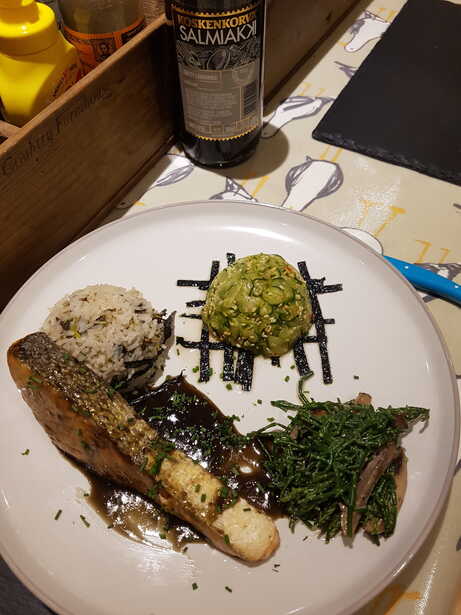
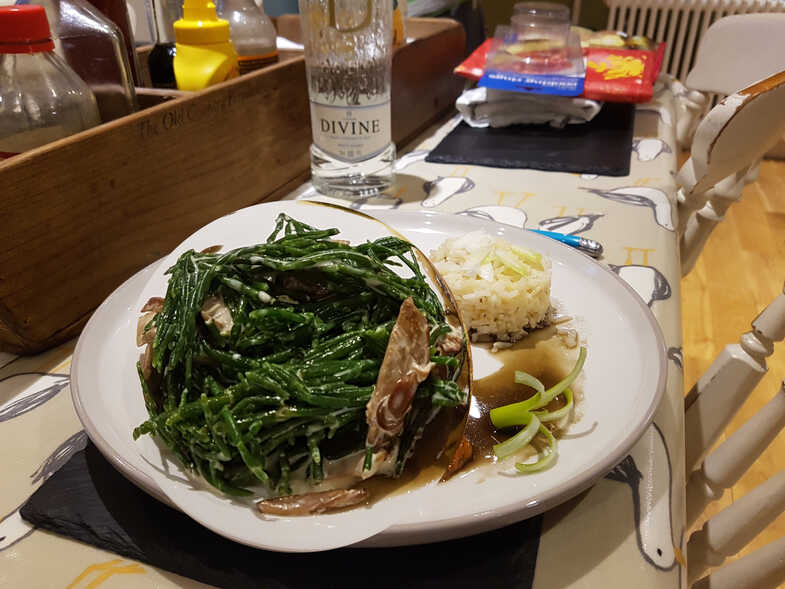
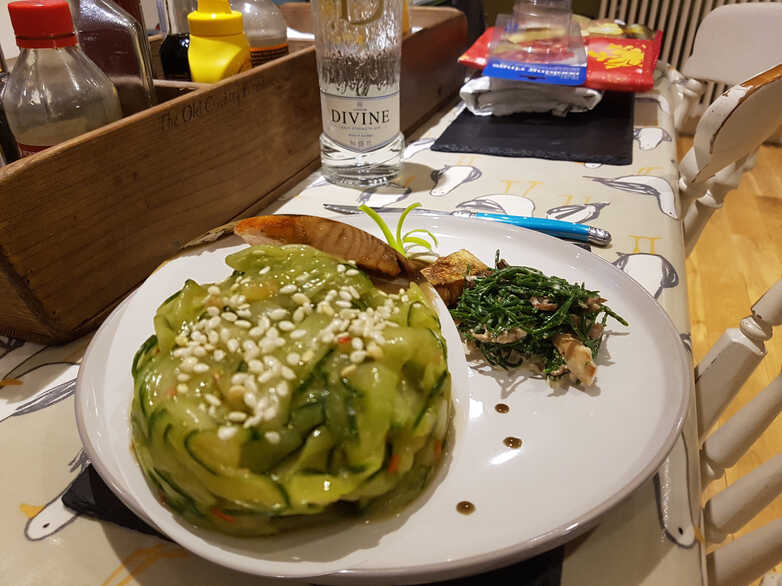
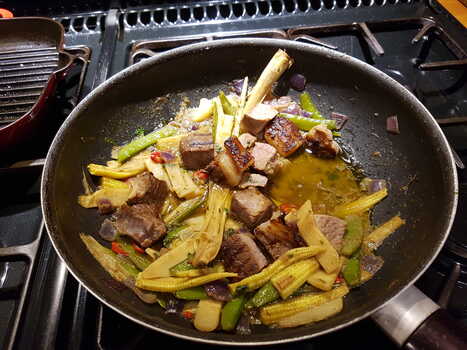
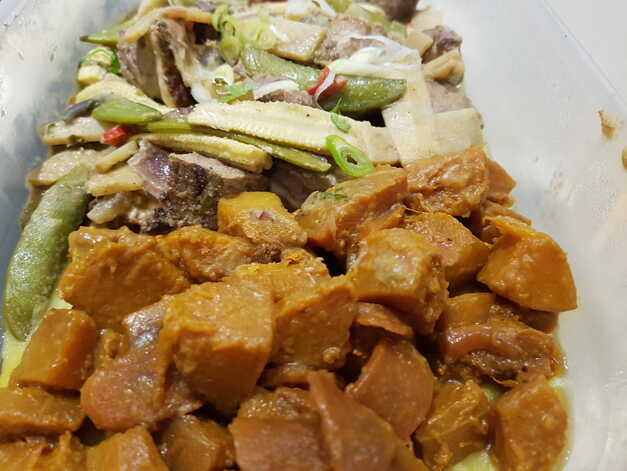

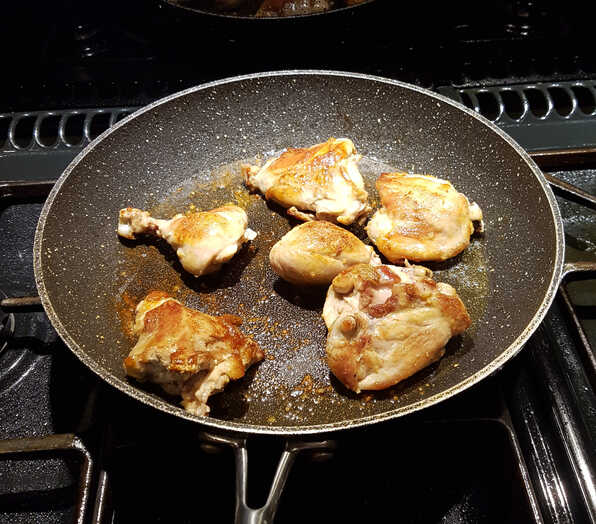
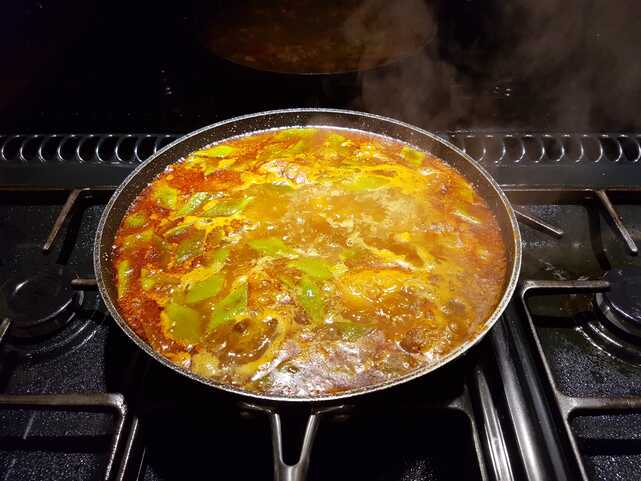
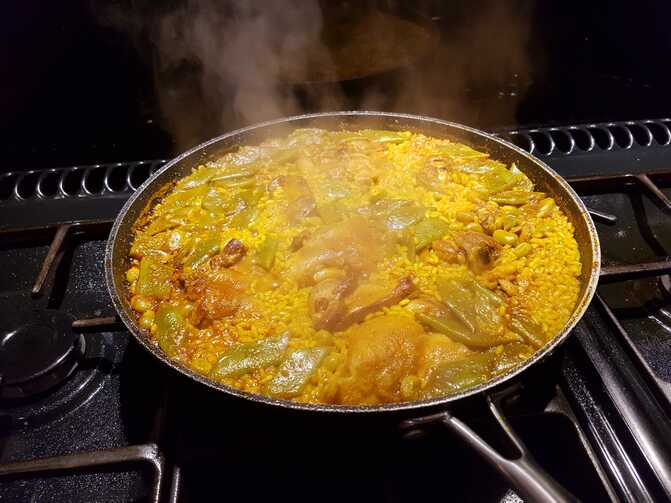
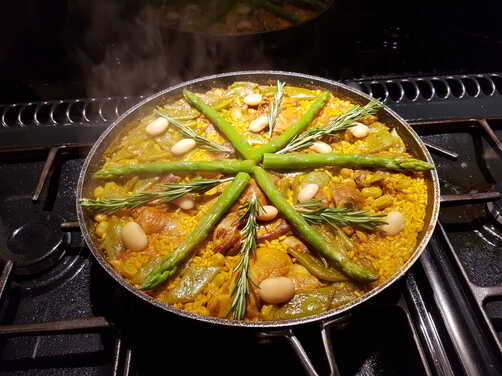
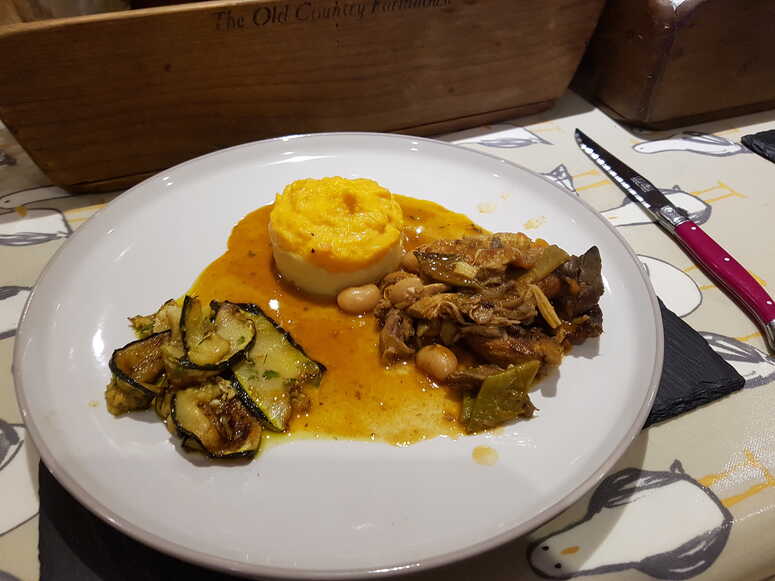
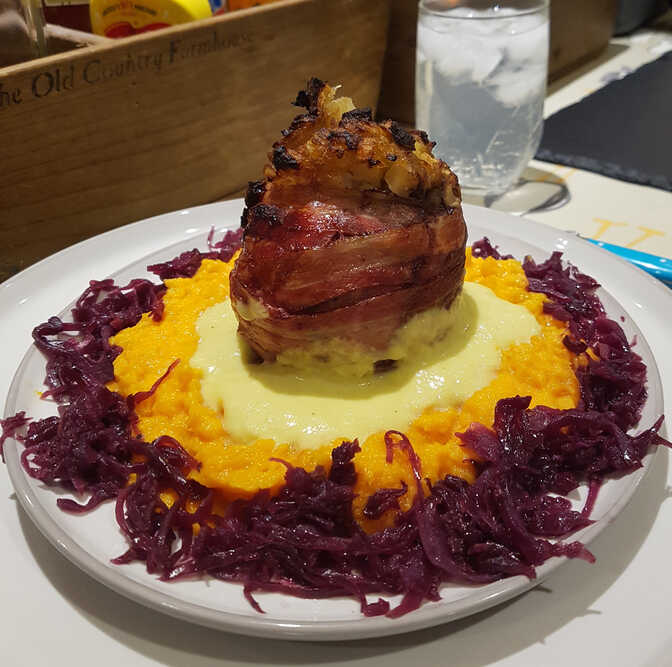



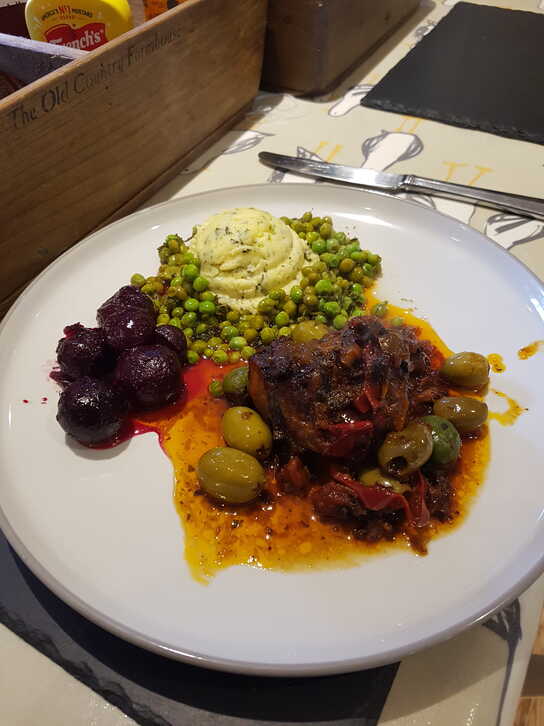

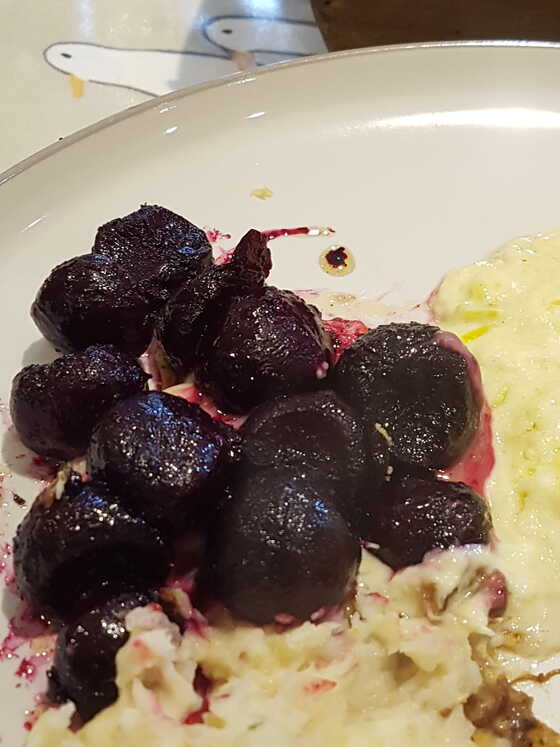
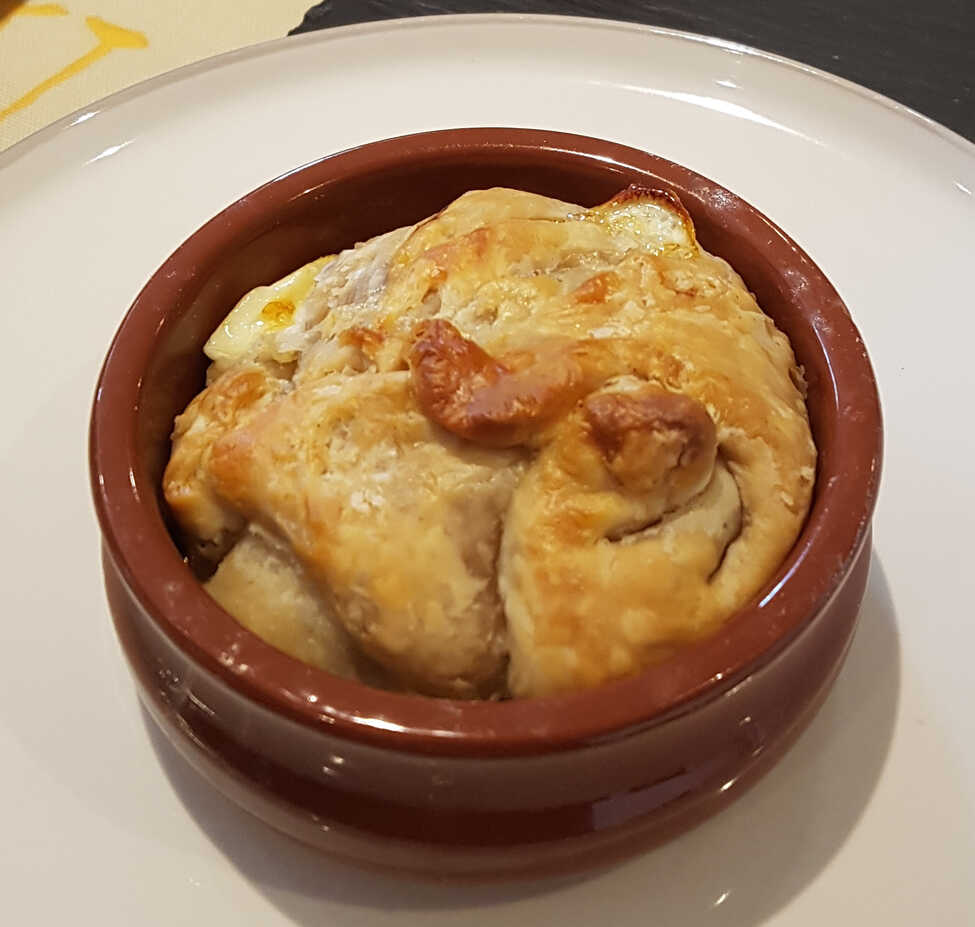
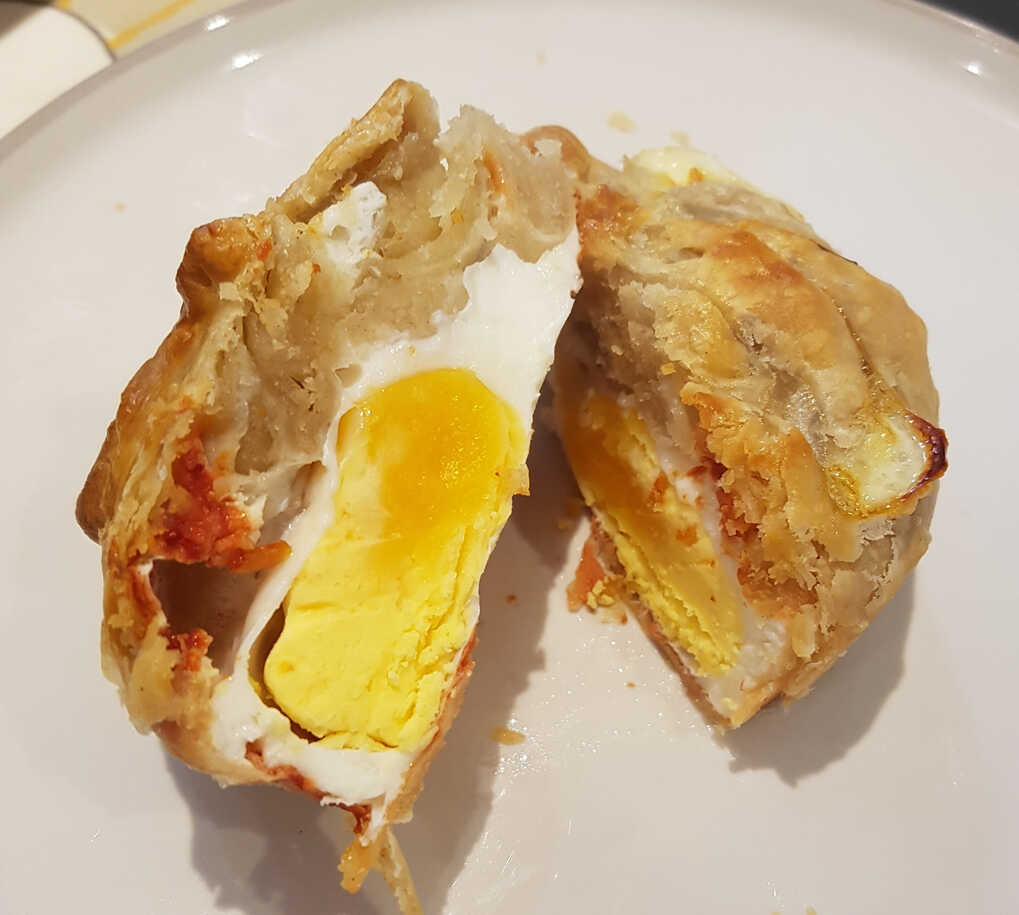
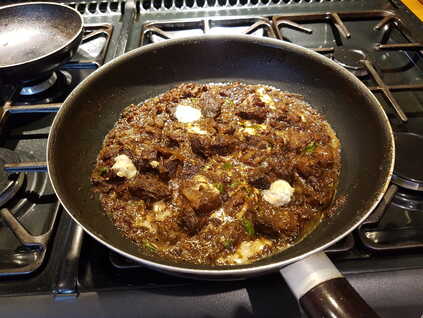
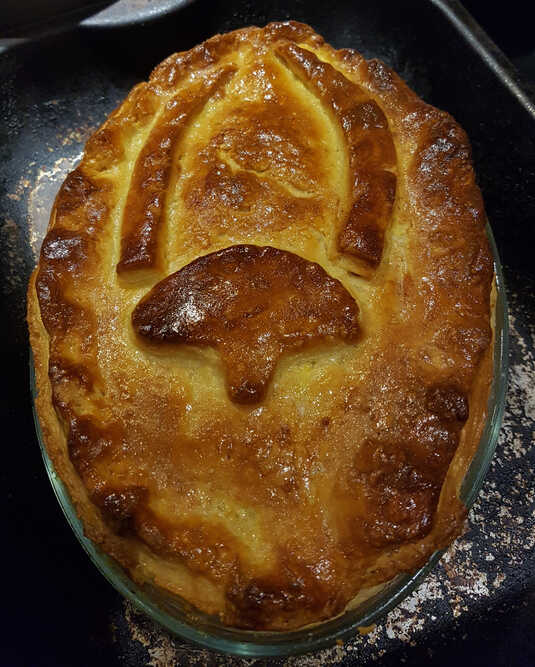
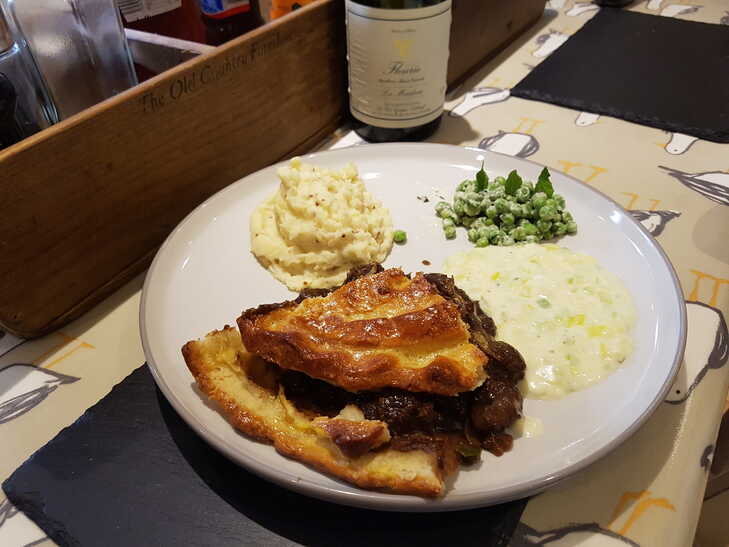

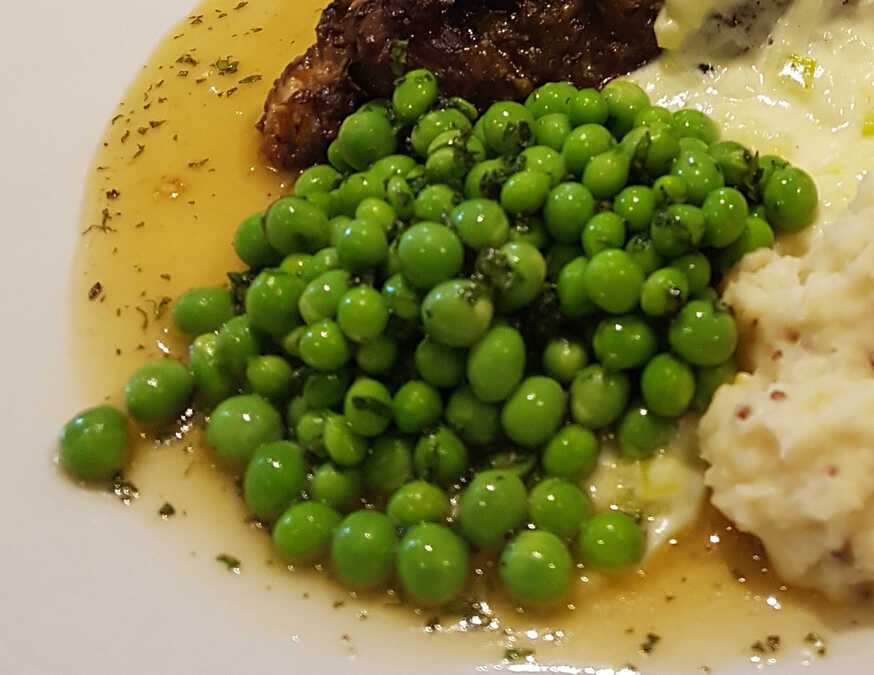

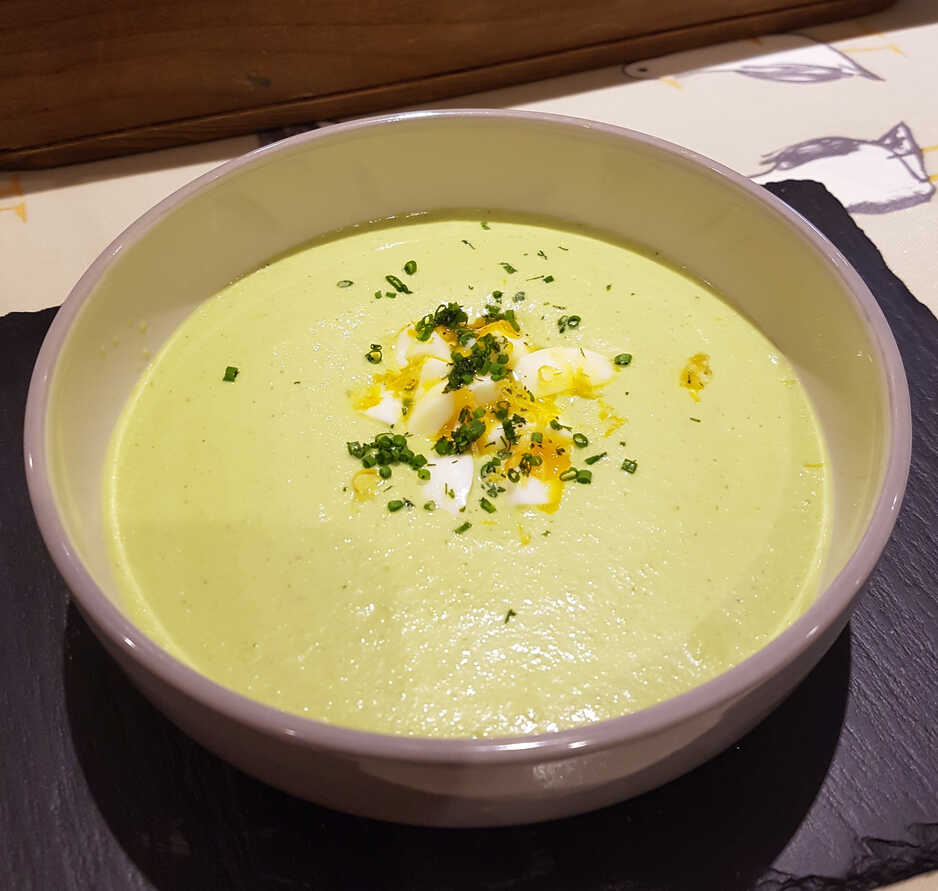

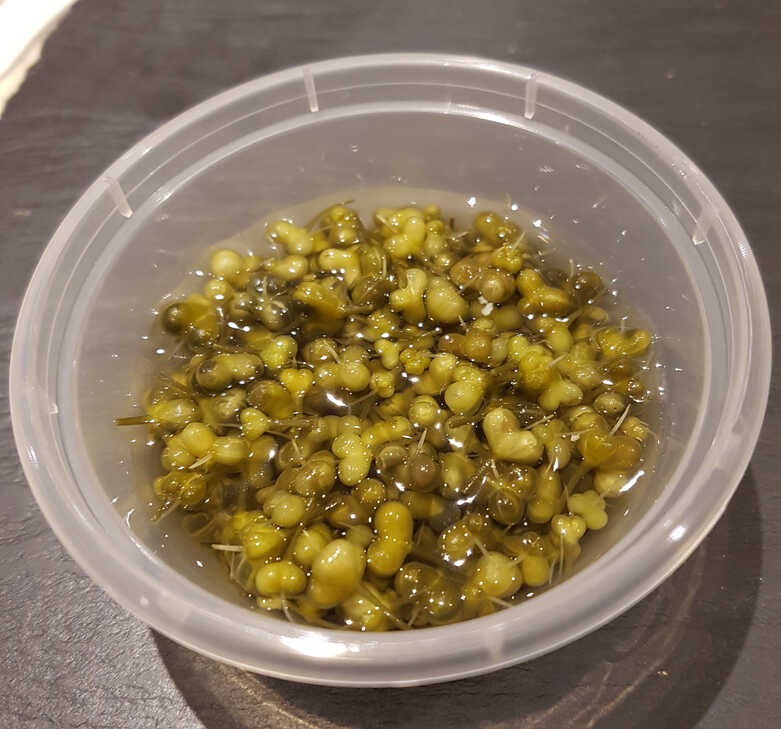
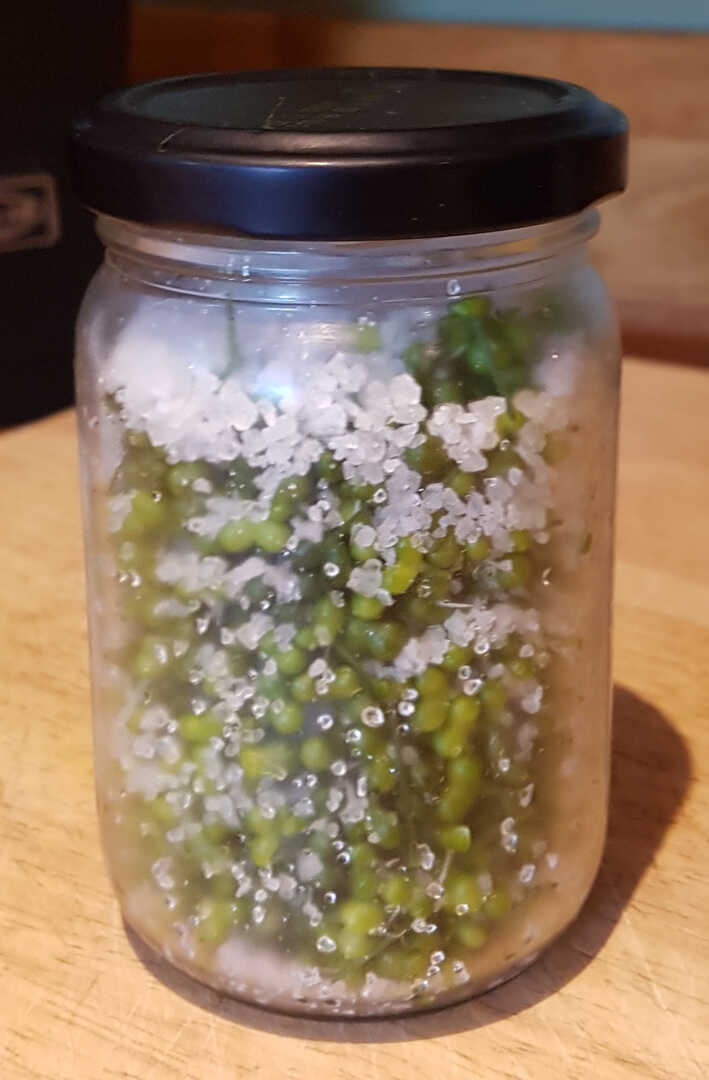
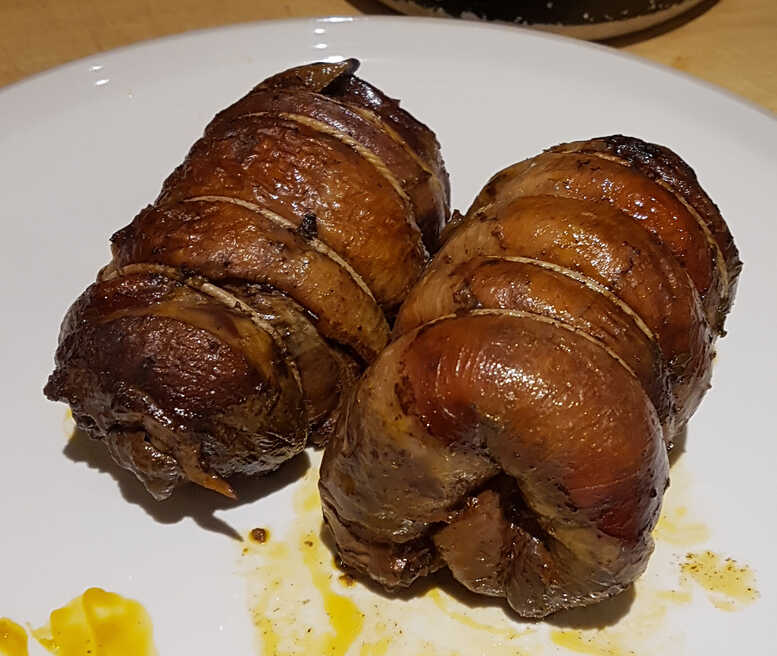

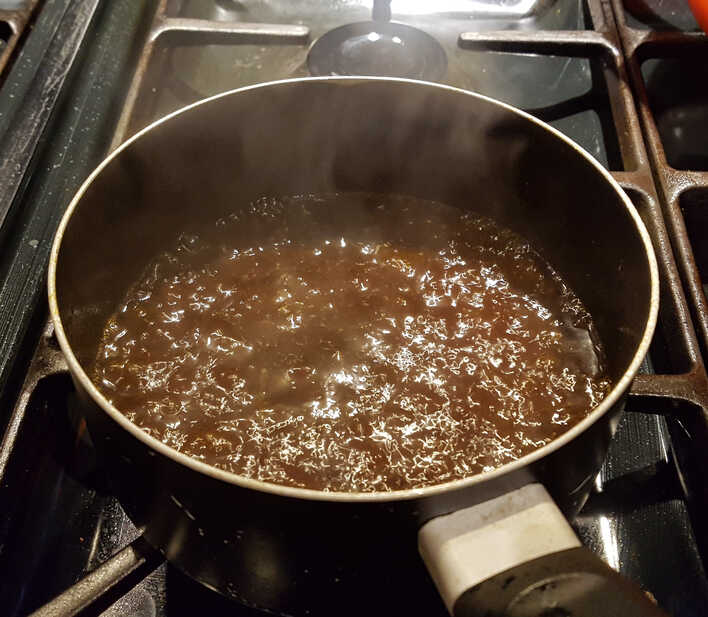
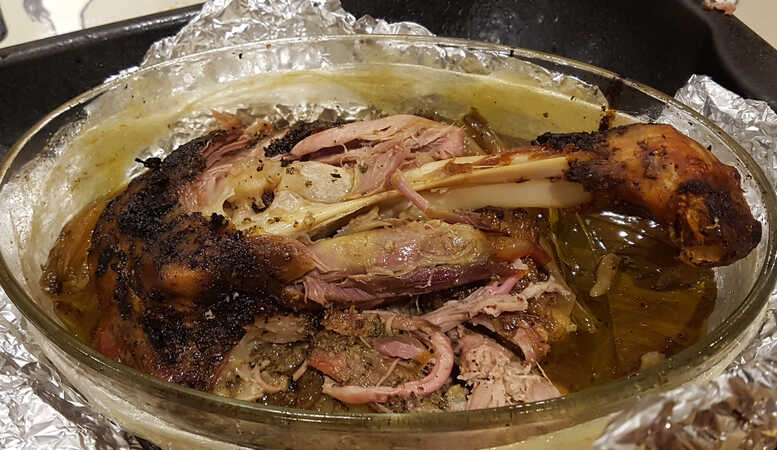
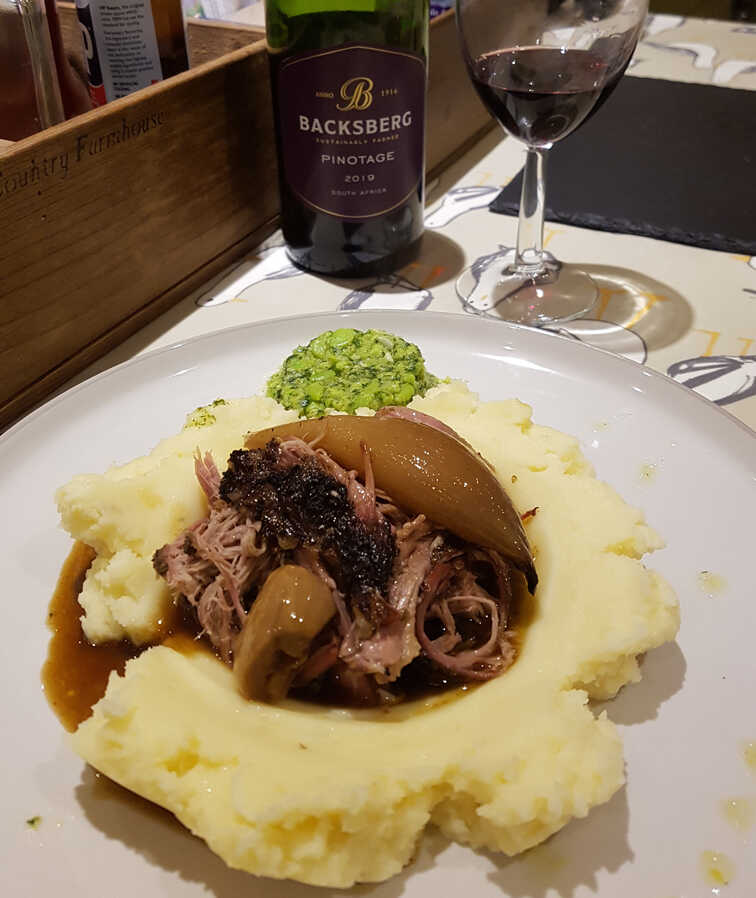
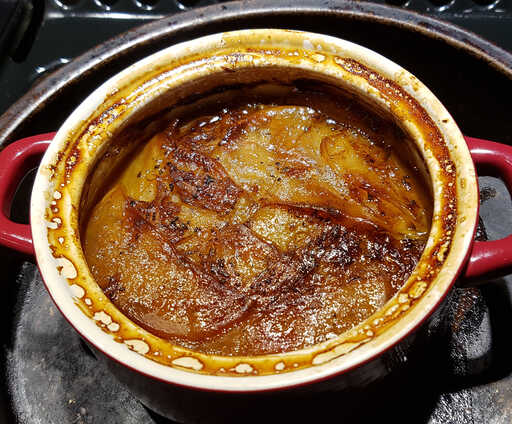
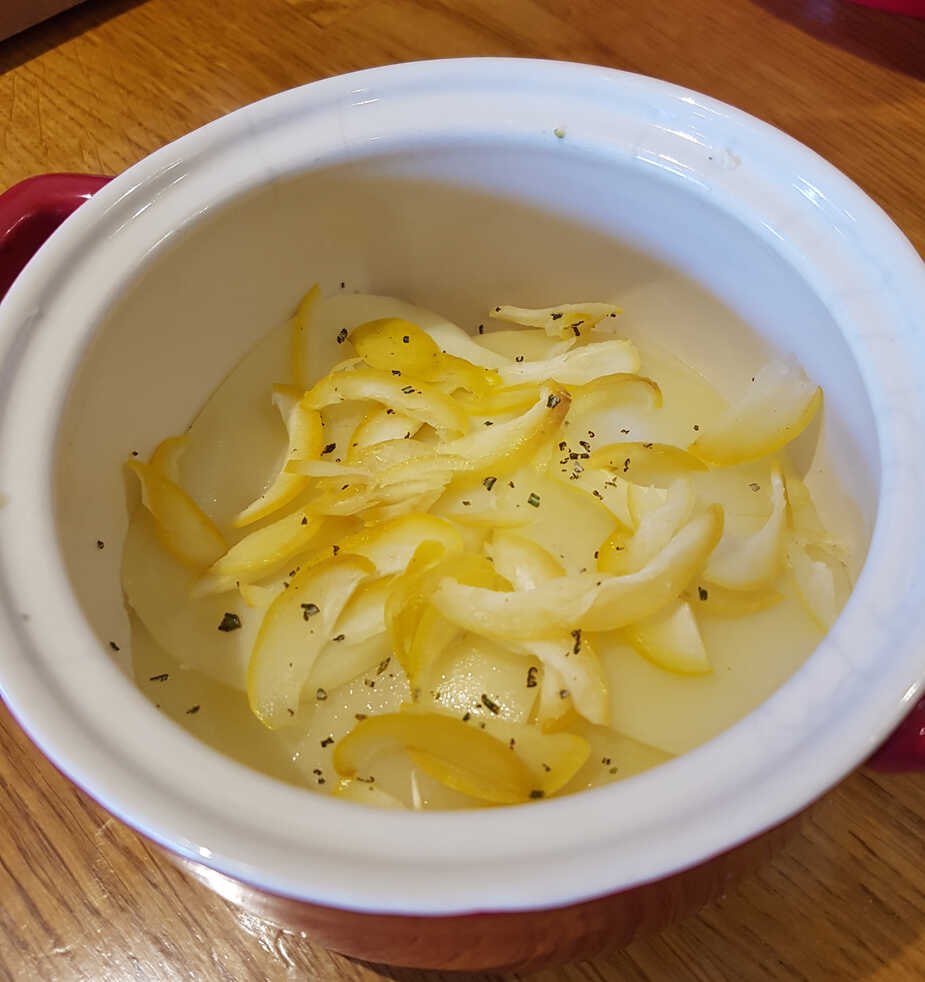
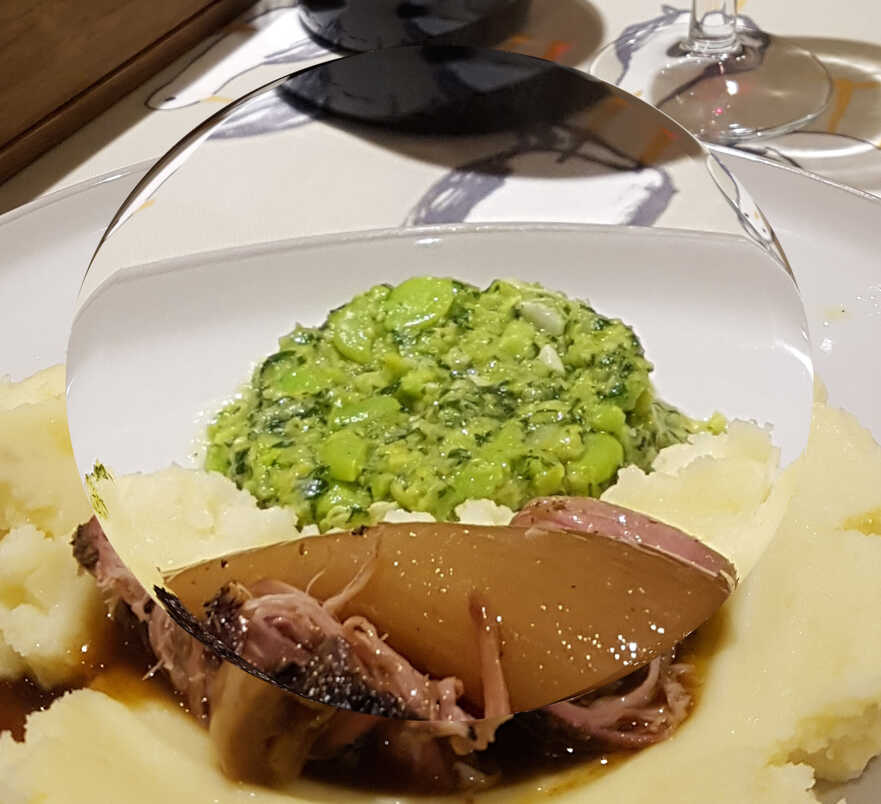
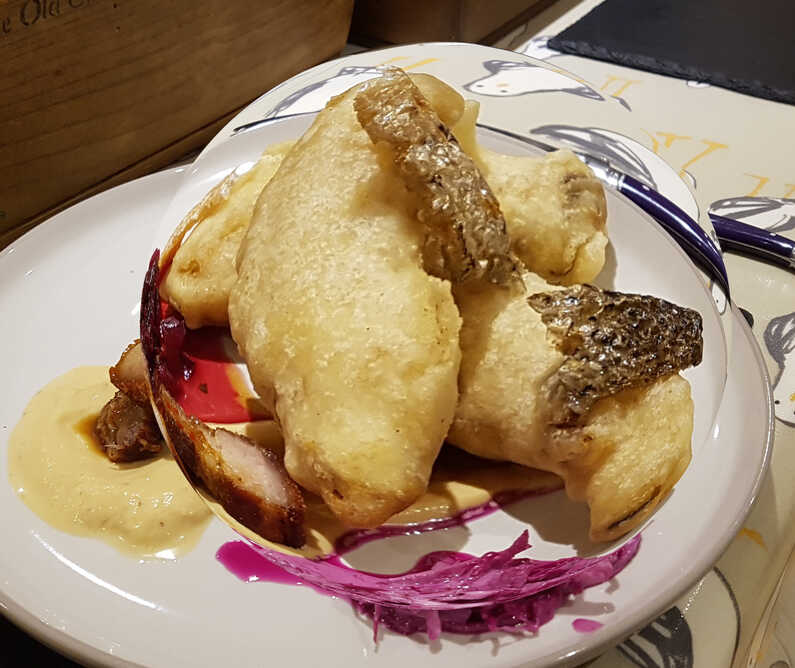
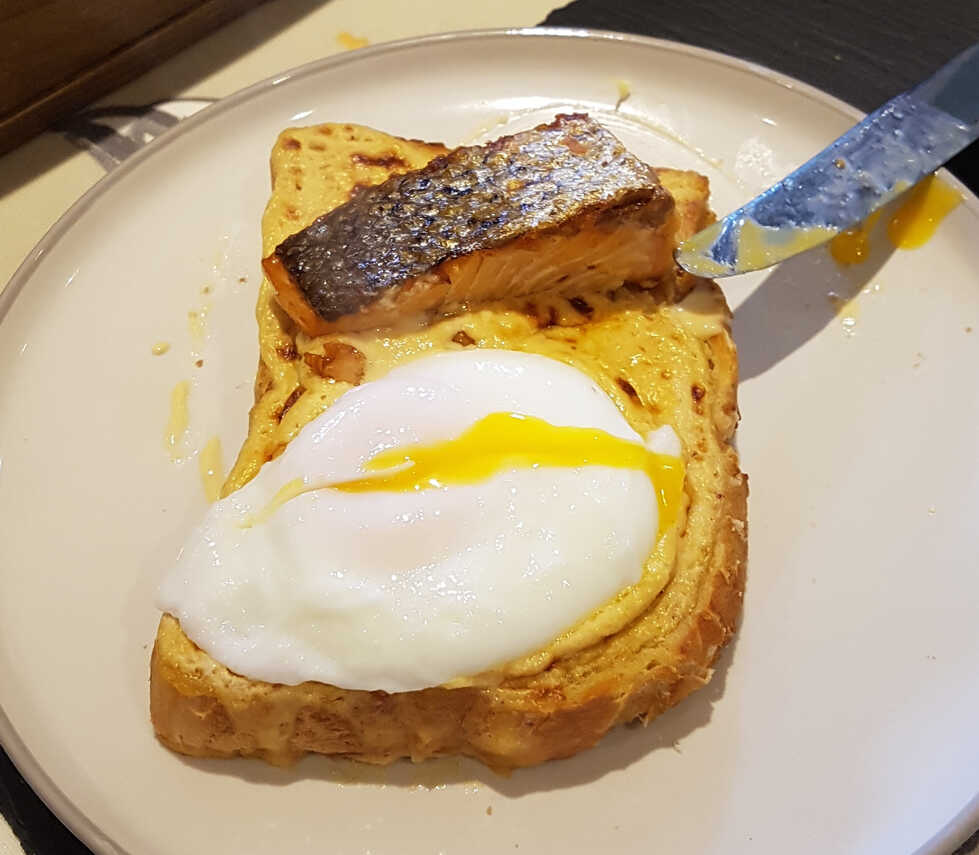
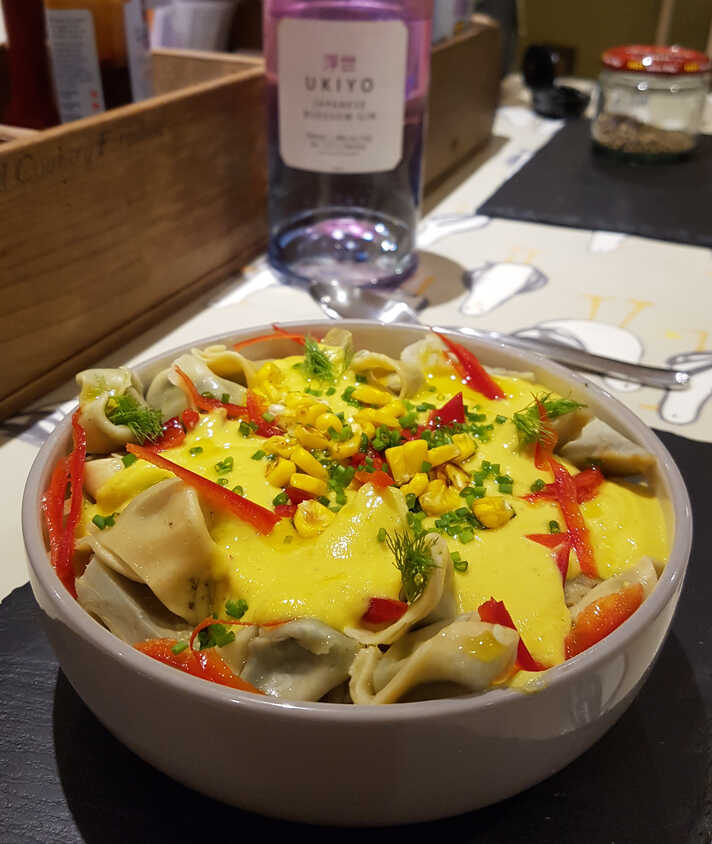
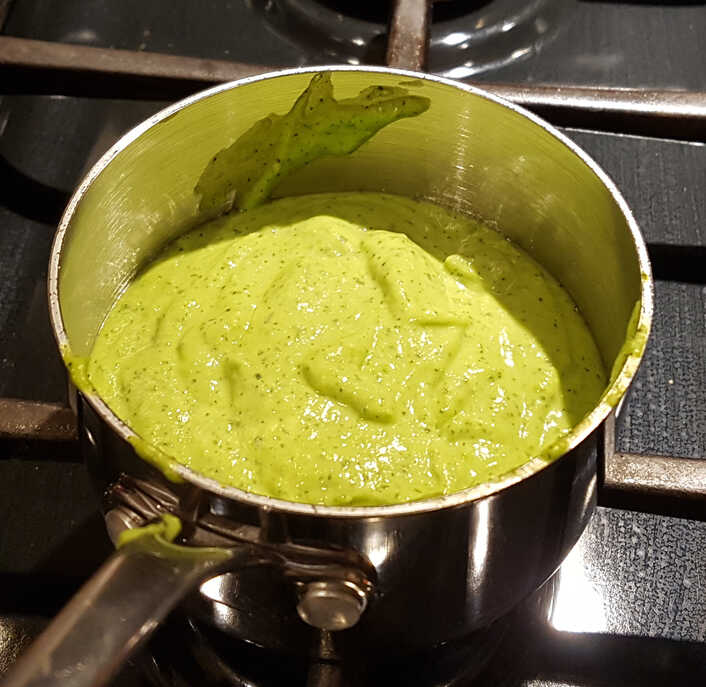
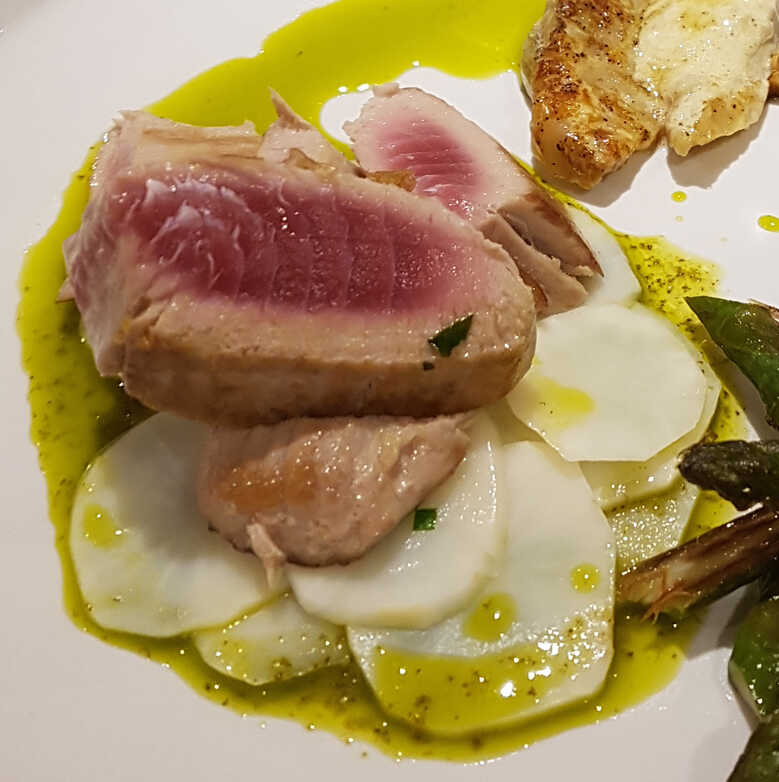
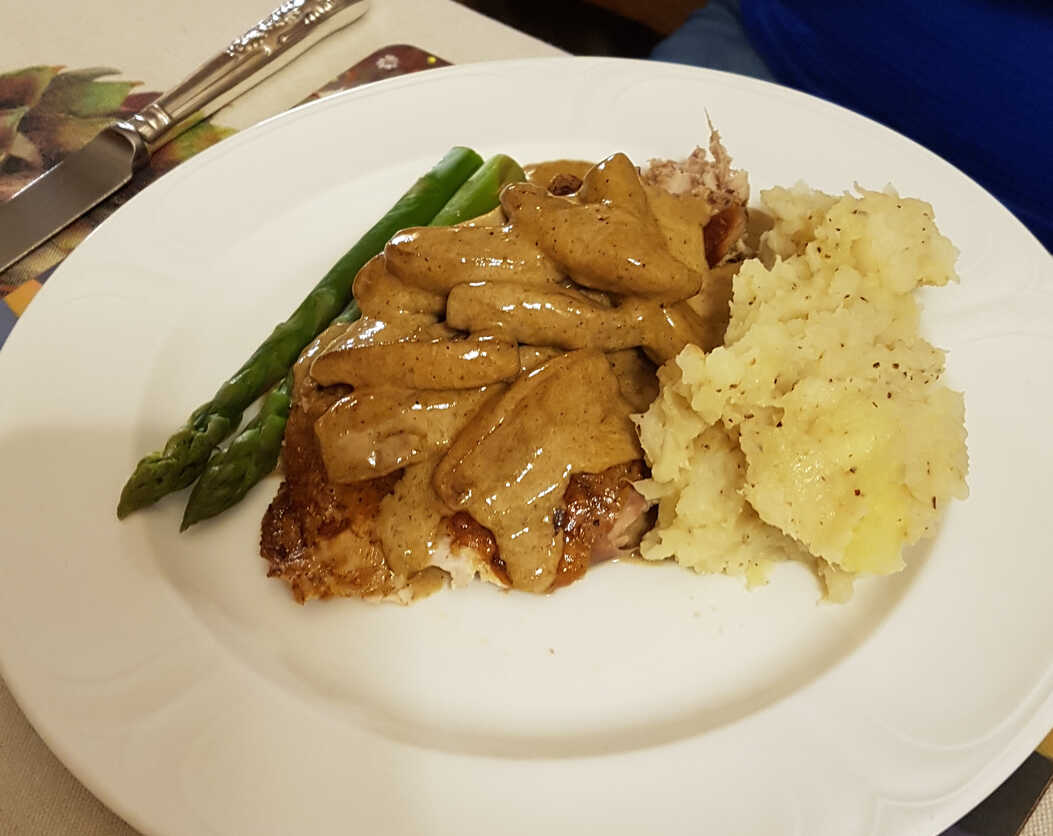
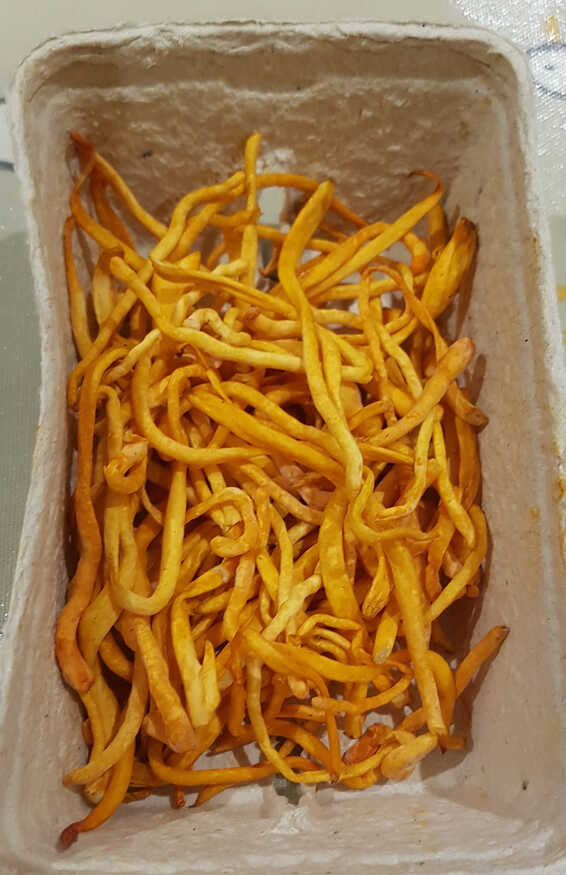
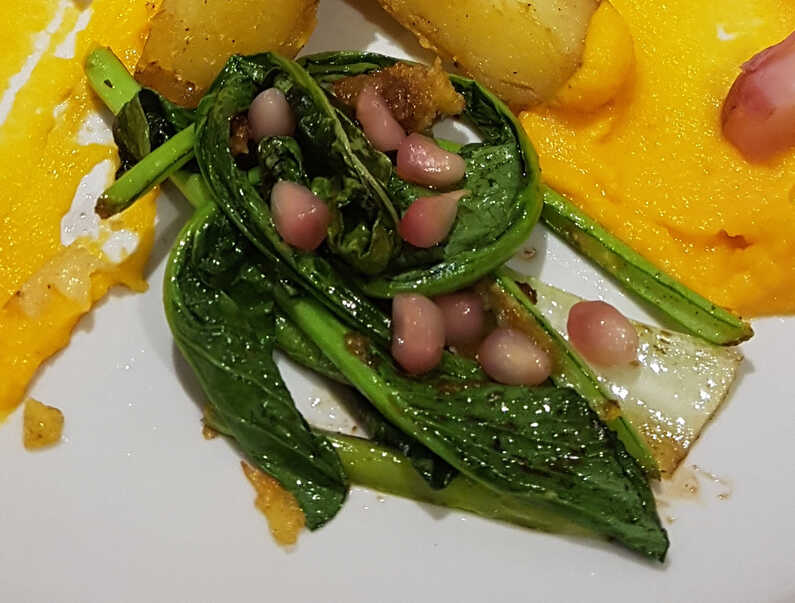

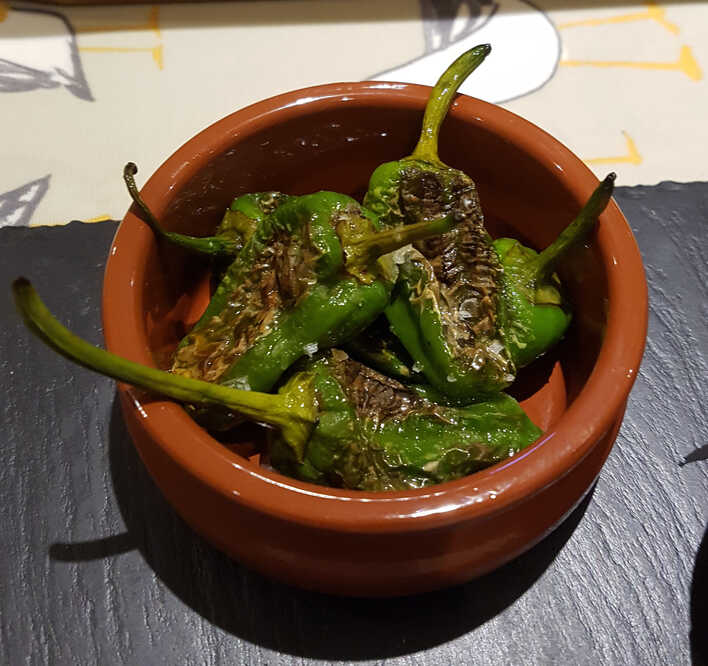
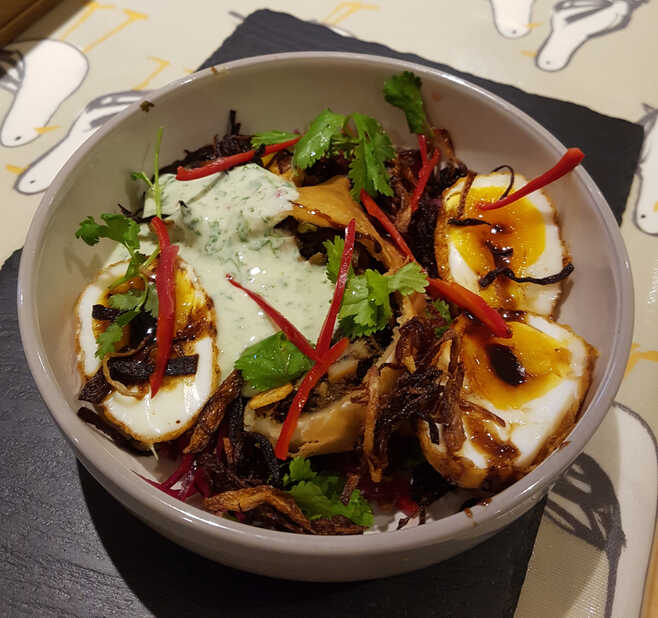
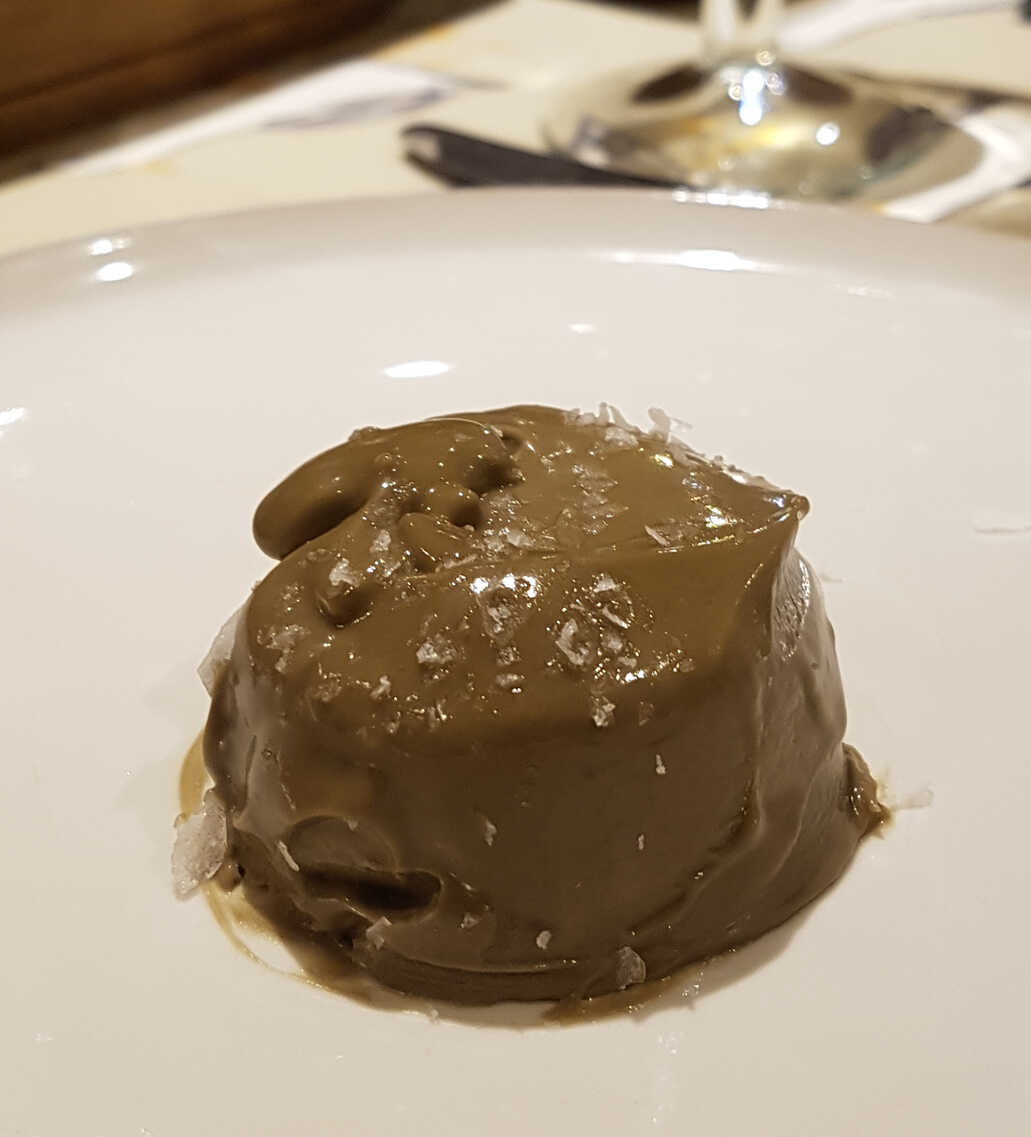
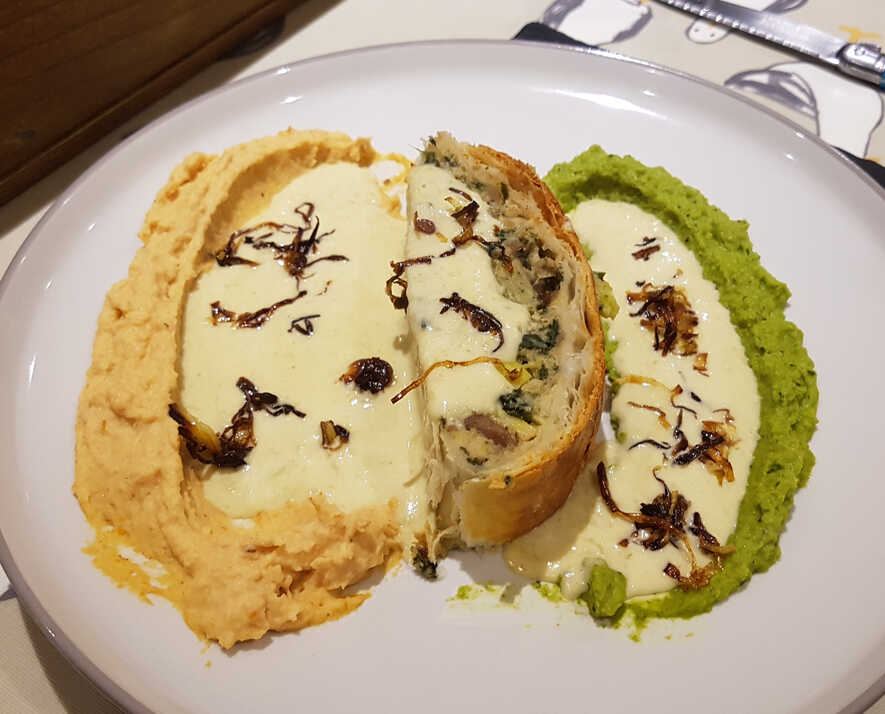
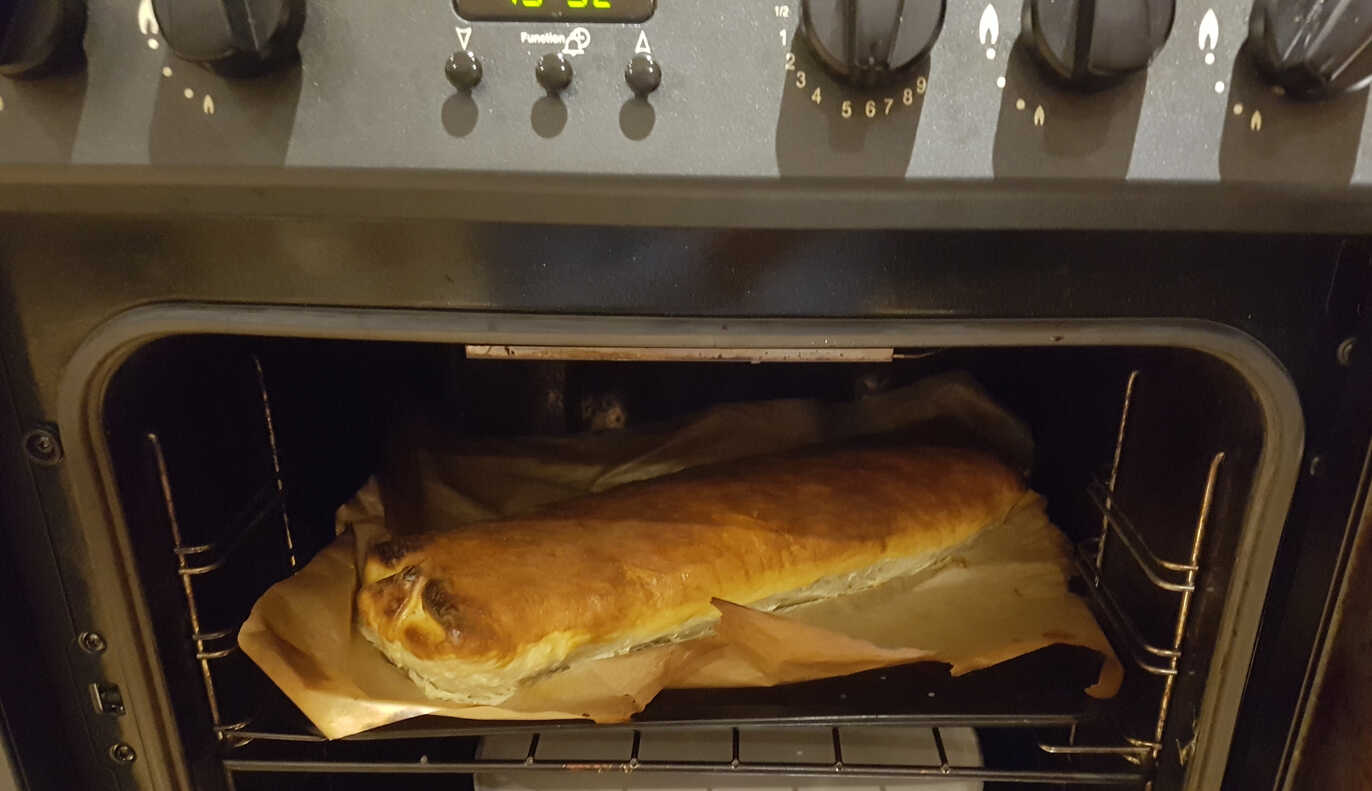
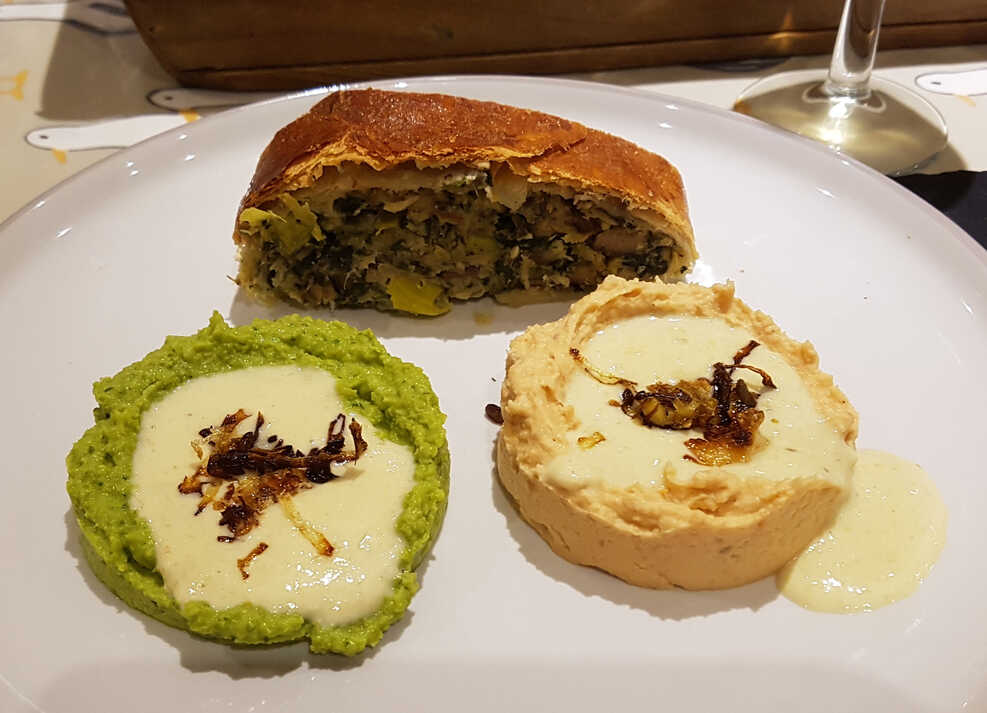

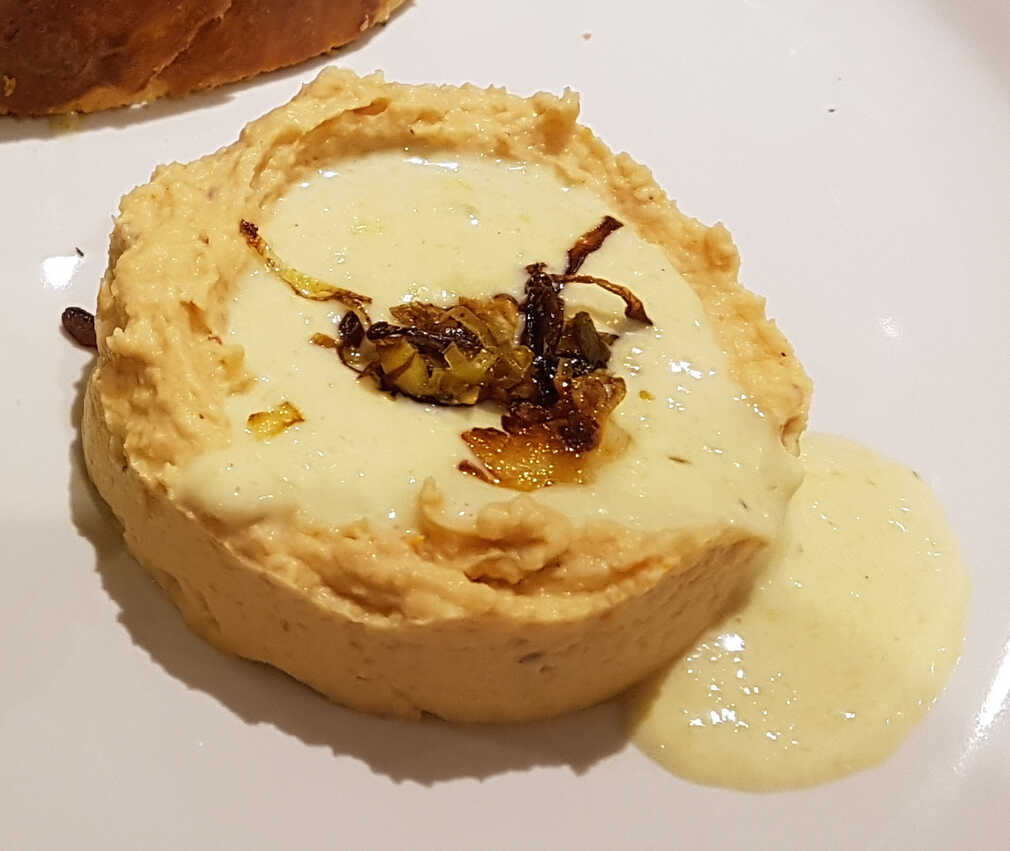
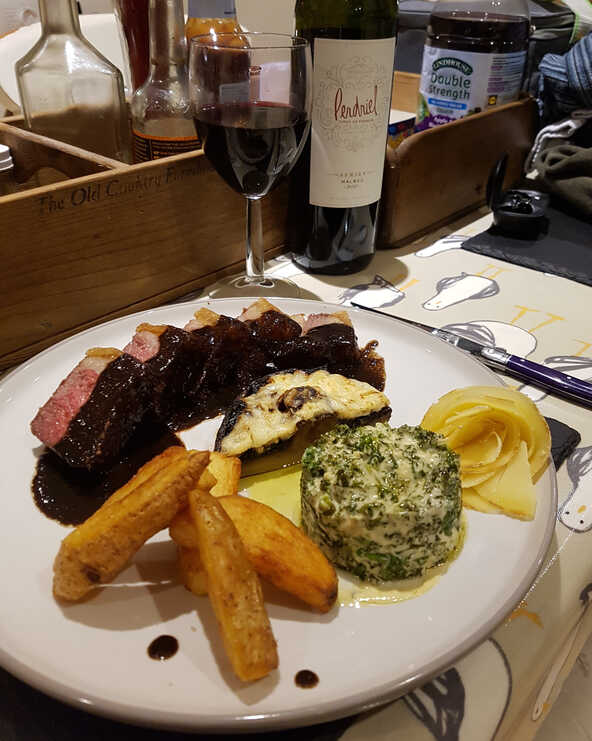
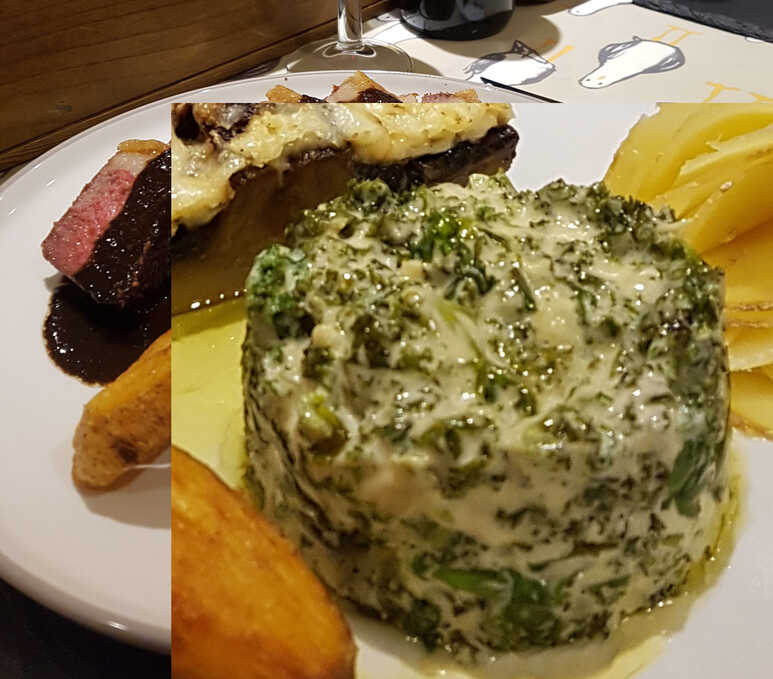
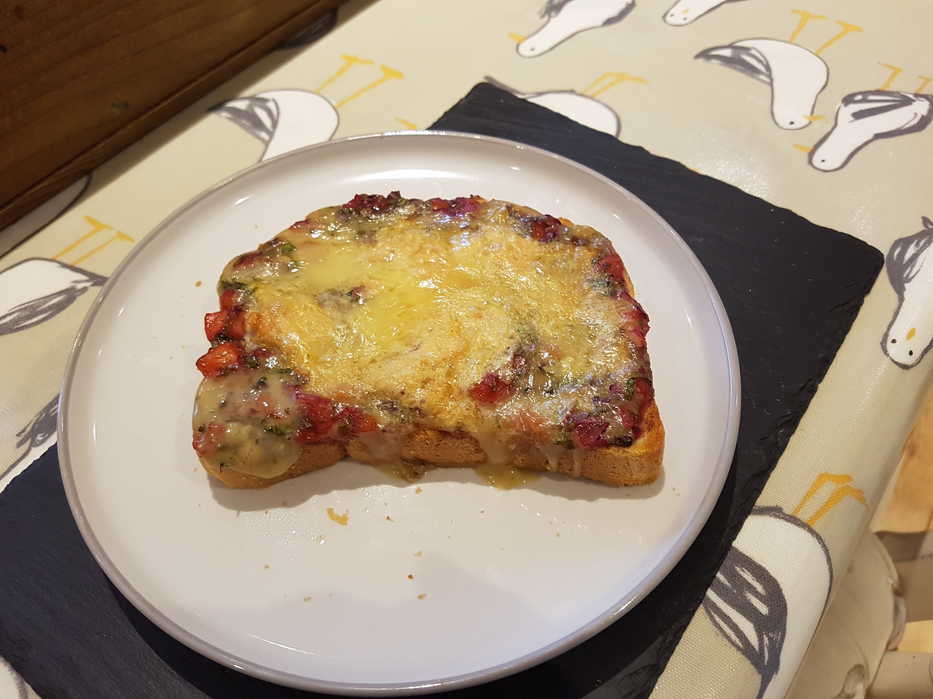
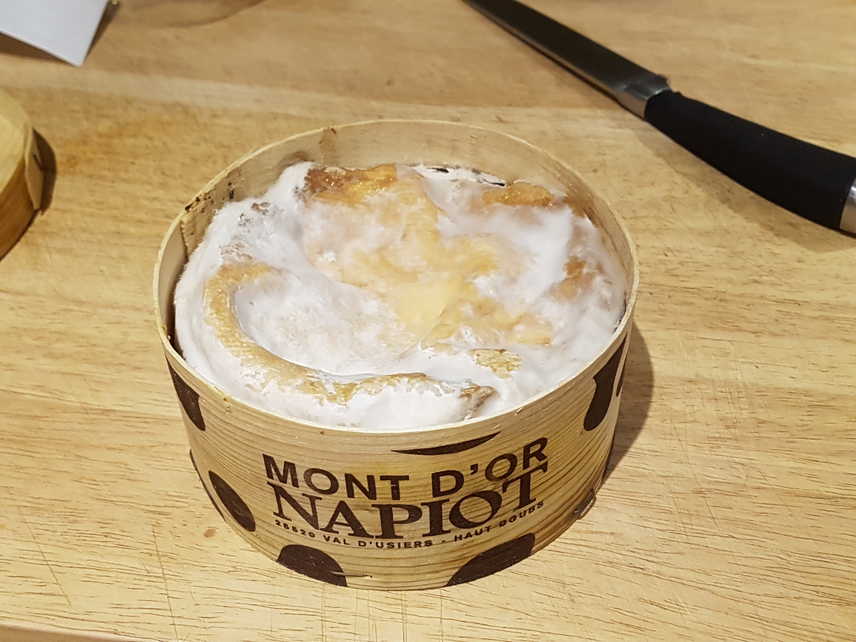
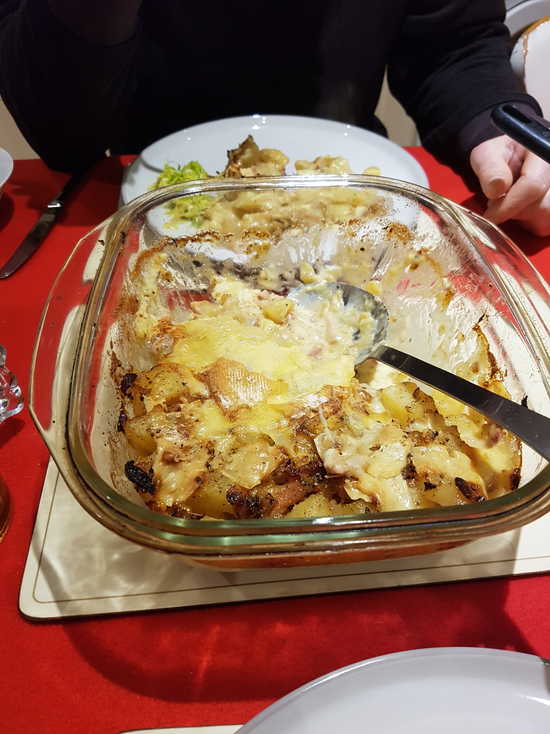
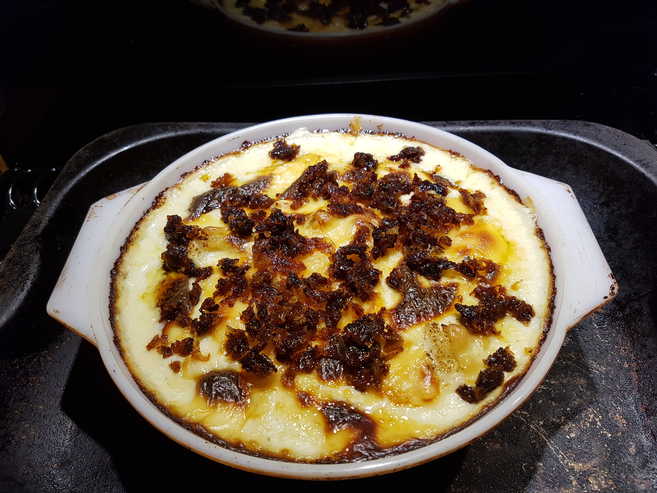


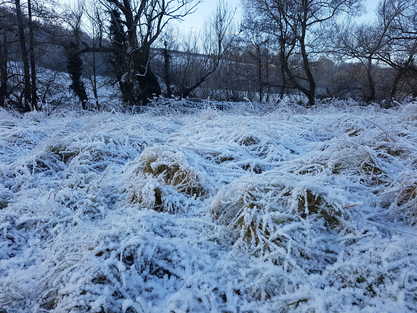
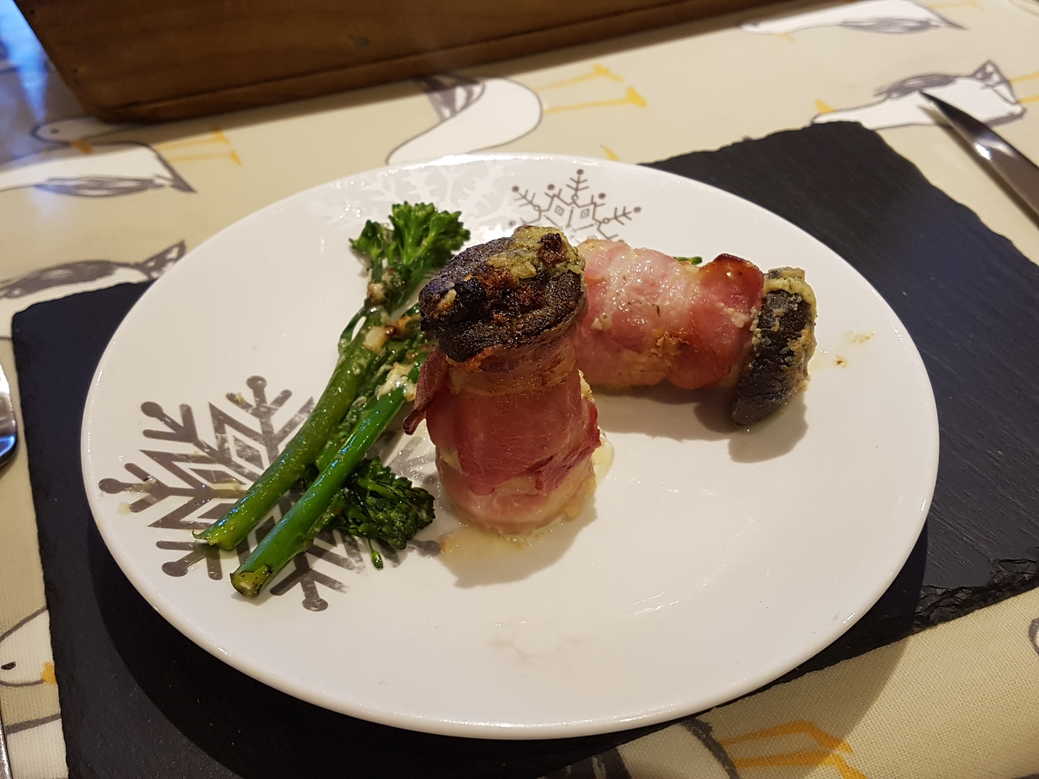
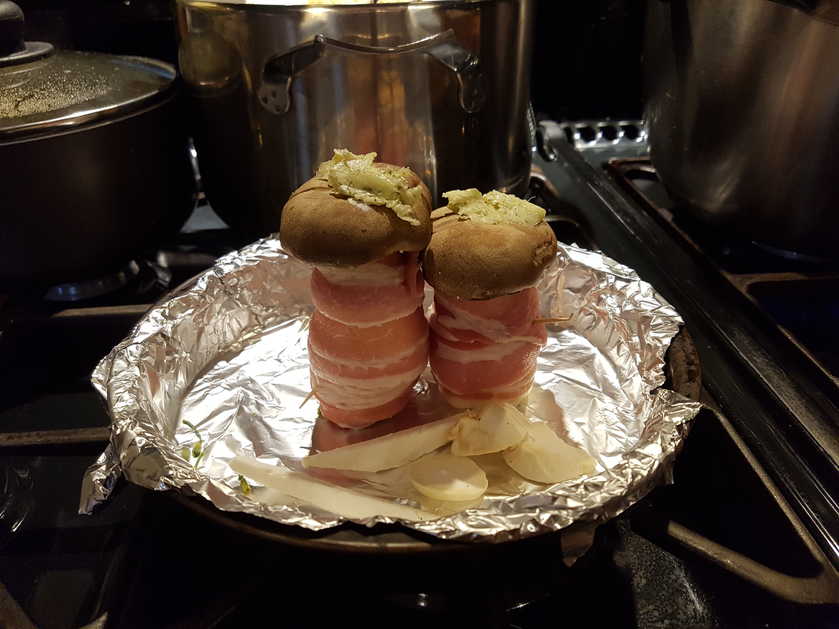

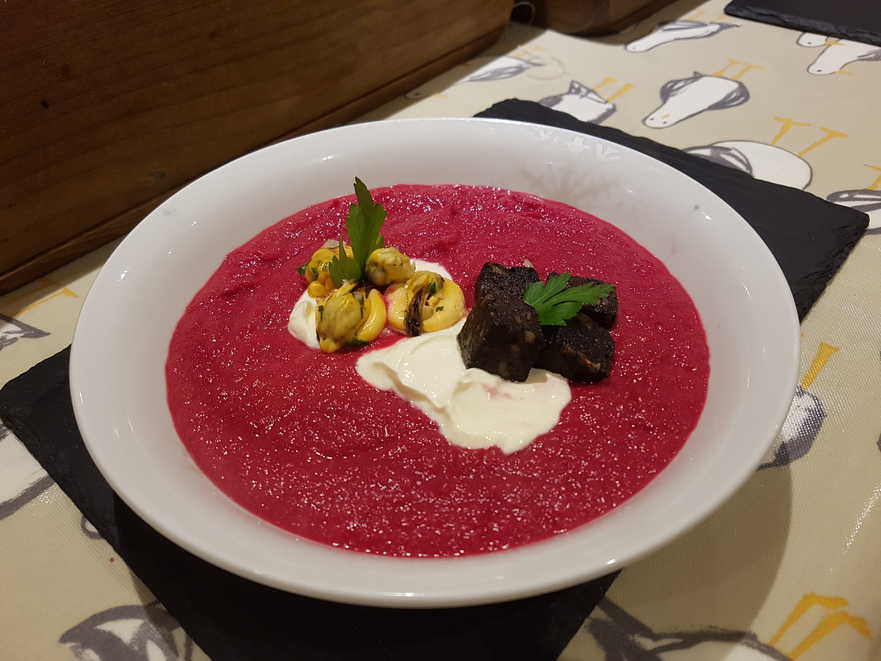
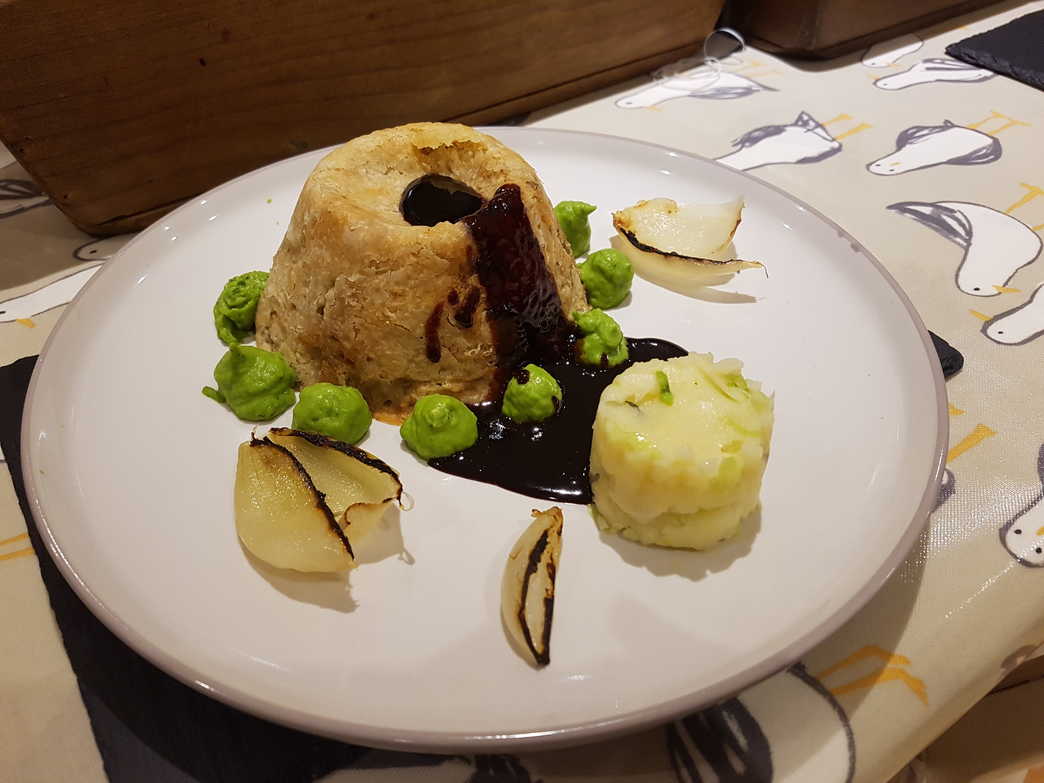
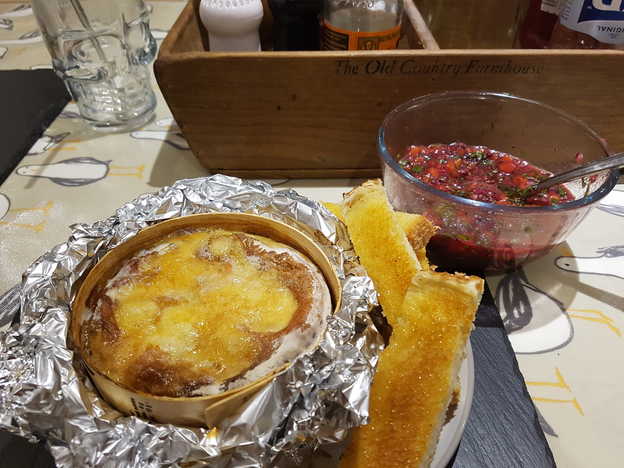
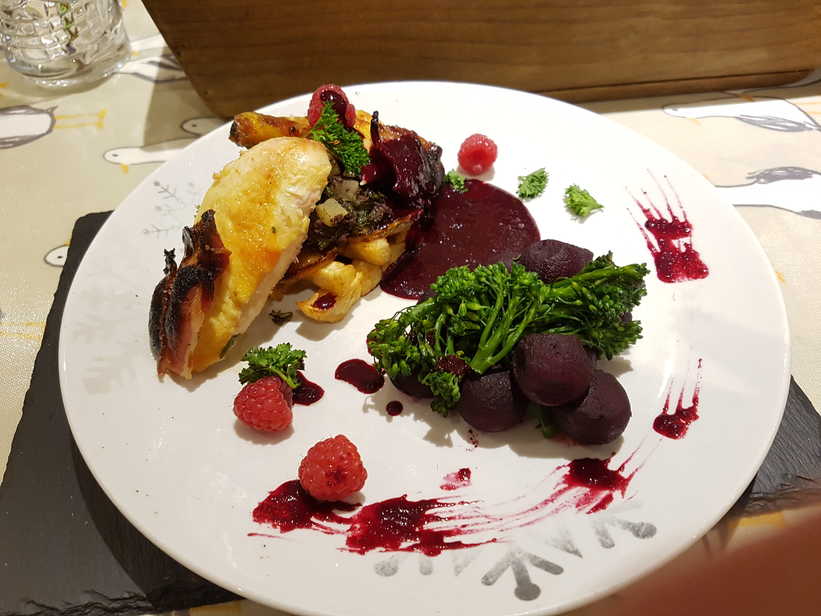
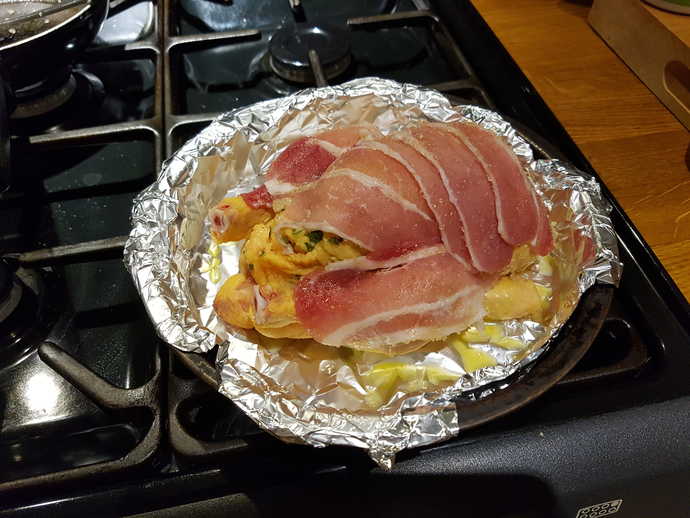




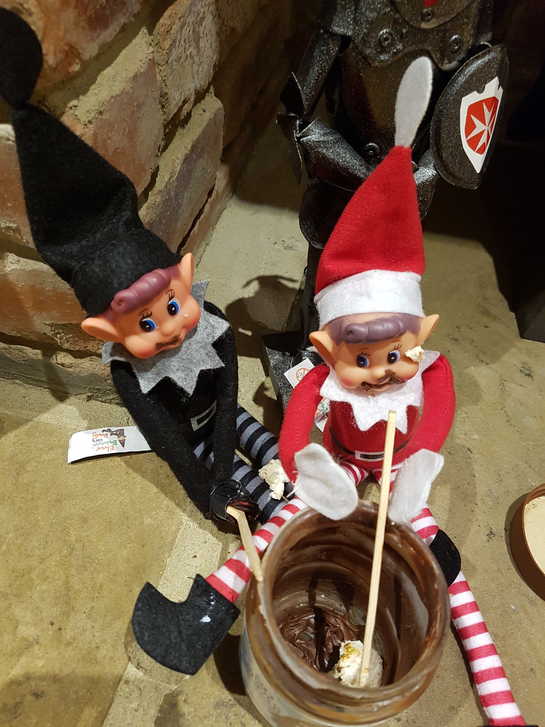
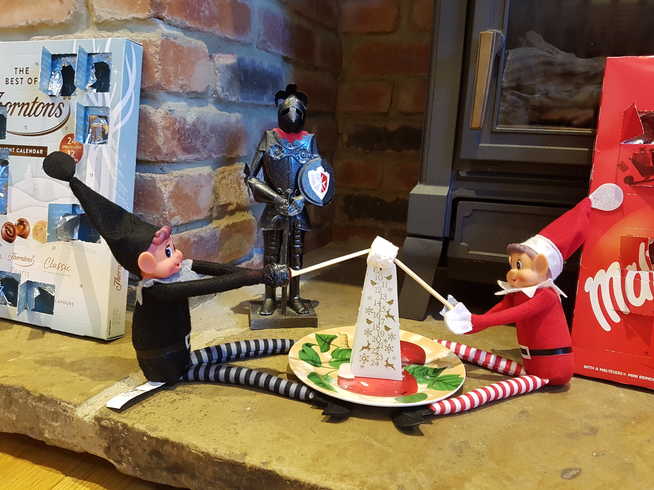







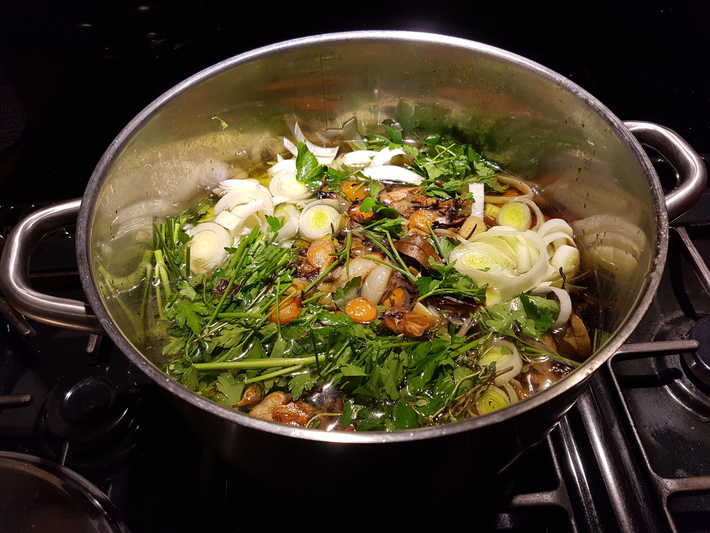

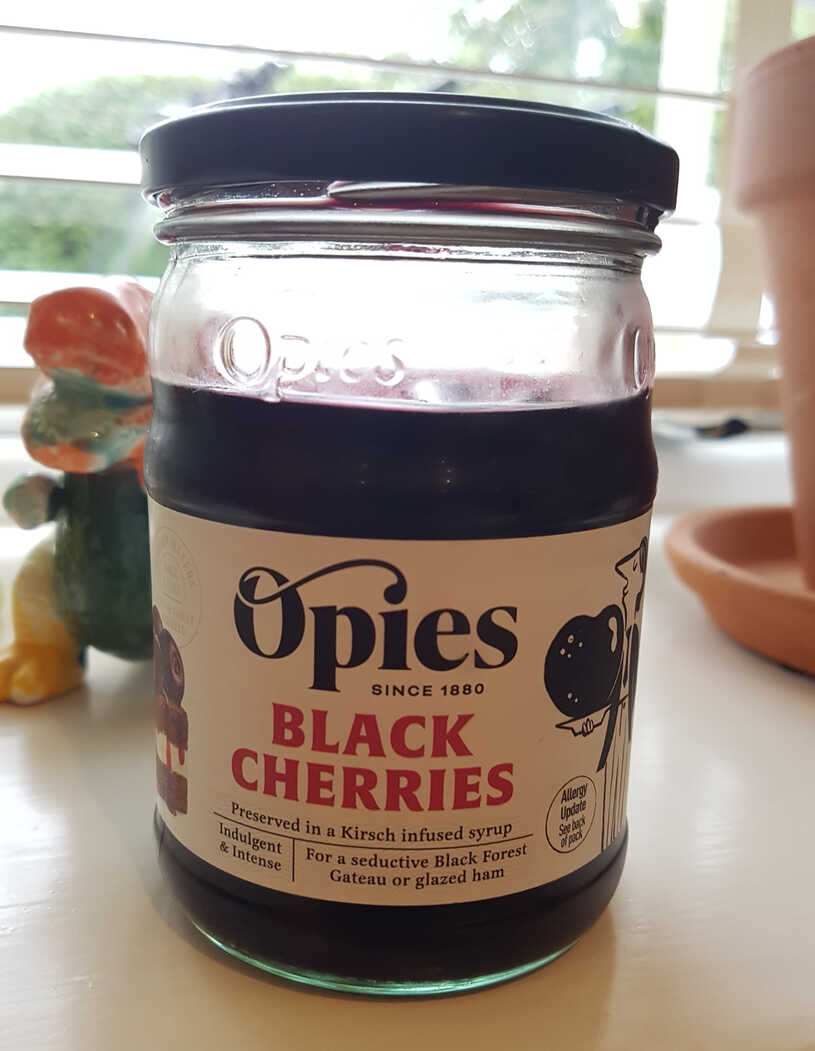
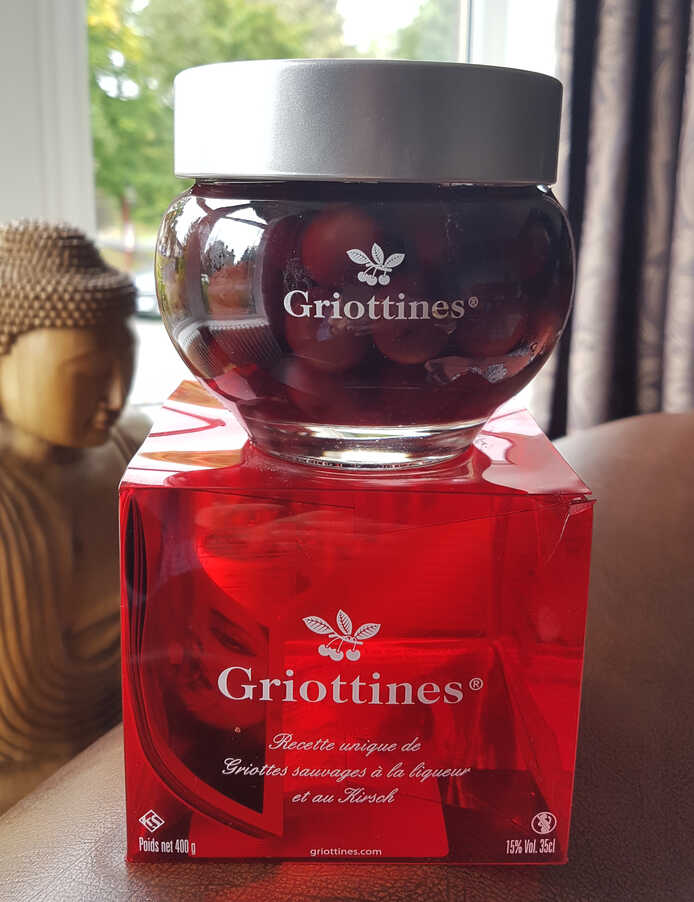
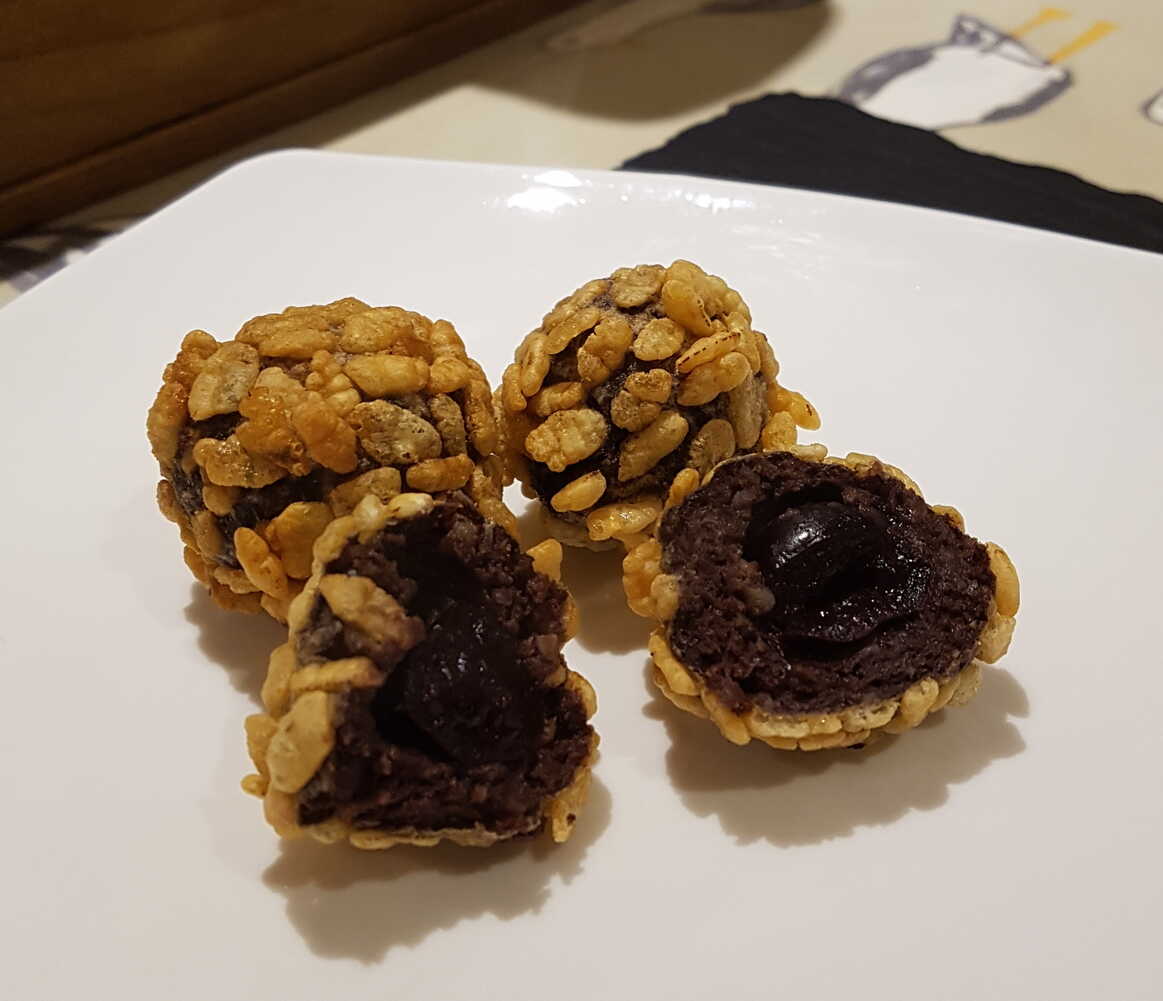





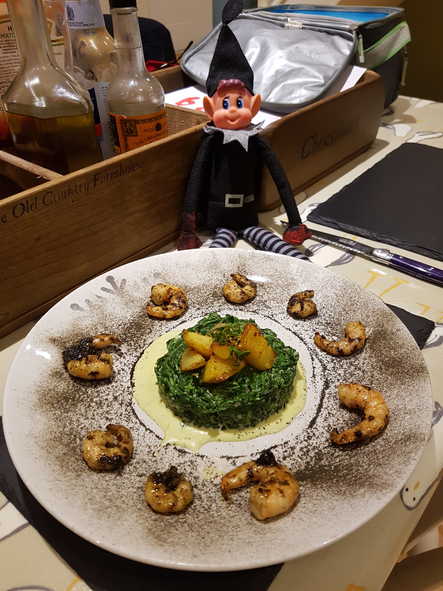
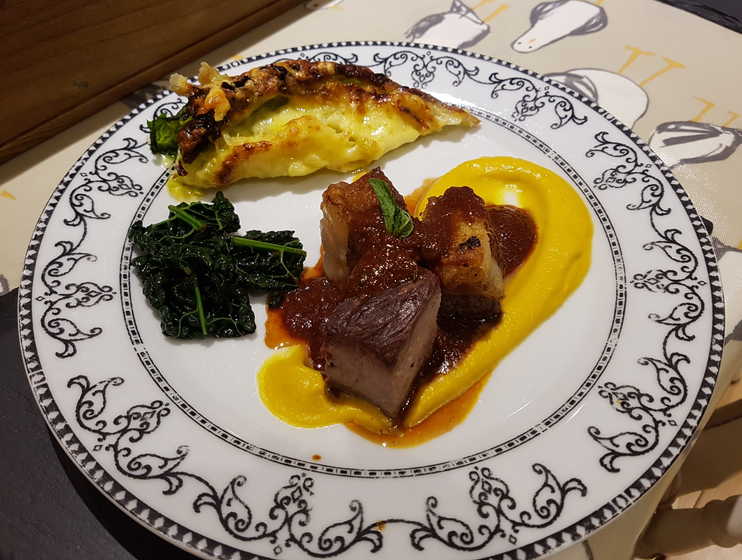
Ding Ding!
The fish is delicious, but the sauce isn't thick and sticky enough. Not like real teriyaki anyway.
I Probably mixed 2 tblsps salmiakki : 1 tblsp maple syrup - teriyaki gets a lot of its glutinous gloss from the soy sauce, but I don't want to add any of that since the salmiakki is already salty enough. (Or at least, that strange ammonia salt that makes it so distinctive.)
Nor do I want to add more syrup or sugar since I don't want to make it over-sweet.
Perhaps I will need to thicken it with tapioca starch, potato starch (Finns like potatoes) or cornflour, though that feels a little like cheating.
Some Mushroom powder perhaps (Finns like mushrooms)?
Round Two
I tried Equal volumes of salmiakki and syrup. Also, I used about 1 tsp tapioca starch dissolved in 2 tsps water to thicken the sauce. Added off the heat after the sauce has already reduced and foamed.
Nope.
Too sweet and the salmiakki flavour (the whole point of the exercise) is lost.
So now I'm thinking, what about beer, stout or porter?
Or Barley Wine?
What about a splash of red wine vinegar? Finns like vinegar.
Round Three
Jackpot!
Salmiakki:Barley-Wine:Maple-Syrup in ratios 3:2:1 gives a pretty good reduction with a nice barley edge to it. You can thicken it slightly with tiny pinches of xanthan gum if you like.
And you may just have to!